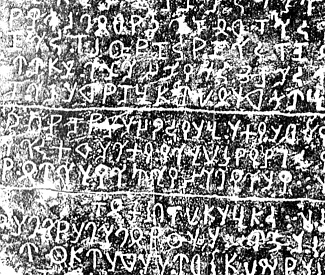

Zitierweise / cite as:
Payer, Alois <1944 - >: Quellenkunde zur indischen Geschichte bis 1858. -- 6. Bewegliche Hinterlassenschaften. -- Fassung vom 2008-03-31. -- http://www.payer.de/quellenkunde/quellen06.htm
Erstmals publiziert: 2008-03-31
Überarbeitungen: 2008-07-16 [Ergänzungen]
Anlass: Lehrveranstaltung FS 2008
©opyright: Dieser Text steht der Allgemeinheit zur Verfügung. Eine Verwertung in Publikationen, die über übliche Zitate hinausgeht, bedarf der ausdrücklichen Genehmigung des Verfassers
Dieser Text ist Teil der Abteilung Sanskrit von Tüpfli's Global Village Library
Falls Sie die diakritischen Zeichen nicht dargestellt bekommen, installieren Sie eine Schrift mit Diakritika wie z.B. Tahoma.
4. Holzarbeiten
Vorbemerkung:
In diesem Kapitel werden Texte zitiert bzw. wird auf Texte verwiesen, die Zustände nach 1858 wiedergeben. Dies geschieht nicht in der Annahme, dass die Zustände in Indien statisch waren; der "Fortschritt" zumindest in den Dörfern war aber gewiss so langsam, dass man von den geschilderten Zuständen vorsichtig auf Zustände früherer Zeiten extrapolieren darf. Die Texte sollen also vor allem einen Rahmen von Fragestellungen und möglichen Vorstellungen geben, in dem materielle unbewegliche Hinterlassenschaften als historische Quellen betrachtet werden können (vorsichtige Anwendung des ethnographischen Zugangs).
Die Auswahl der Bilder gibt keinen repräsentativen Querschnitt durch diese Art historischer Quellen, sondern ist in ihrer Einseitigkeit bedingt durch das Vorhandensein von Bildmaterial, das urheberrechtlich genutzt werden kann.
Unter "beweglichen Hinterlassenschaften" des Menschen verstehe ich hier alle beweglichen Relikte des Menschen in Indien bis 1858 mit Ausnahme derer, denen ich eigene Kapitel gewidmet habe, d.h. mit Ausnahme von
"Beweglichen Hinterlassenschaften" sind ein Teilgebiet von Sachzeugnissen (gegenständlichen Quellen) der Vergangenheit. Mit Thorsten Heese definiere ich diese so:
"Definition: Das Sachzeugnis als Quelle Gegenständliche Quellen sind materielle Überreste gelebter geschichtlicher Wirklichkeit. Als authentische, da unmittelbar überlieferte Materialisierungen vergangenen menschlichen Handelns zeugen sie von den Lebensumständen derjenigen Menschen, die sie geschaffen, benutzt und bewahrt haben. Sie bedürfen der Quellenkritik und -Interpretation."
"Definition: Das Sachzeugnis als Medium Gegenständliche Quellen sind materielle Medien für historisches Lernen, die Menschen früherer Zeiten selbst gewollt oder zufällig produziert haben. Sie besitzen einen monumentalen oder einen dokumentarischen Charakter."
[Quelle beider Zitate: Heese, Thorsten <1965 - >: Vergangenheit "begreifen" : die gegenständliche Quelle im Geschichtsunterricht. --Schwalbach/Ts. : Wochenschau-Verl. , 2007. -- 223 S. : Ill. ; 19 cm. -- (Methoden historischen Lernens). -- ISBN 978-3-89974-331-9. -- S. 33, 35.]
Bewegliche Hinterlassenschaften sind also in unserem Zusammenhang u.a.
Thorsten Heese (a.a.O., S. 41 - 50) nennt folgende Kategorien gegenständlicher Quellen:
Folgende von Thorsten Heese für Schülerarbeiten genannten Arbeitsschritte gelten entsprechend für jedes historisches Arbeiten mit gegenständlichen Quellen:
"Übersicht: Arbeiten mit gegenständlichen Quellen
- Wahrnehmen: In einer ersten Begegnung werden die Schülerinnen und Schüler mit dem Gegenstand konfrontiert. Sie betrachten, beobachten, messen, wiegen, untersuchen, beschreiben, benennen, zeichnen die vorgestellte Quelle.
Leitfrage: Wie sieht der Gegenstand aus?
- Erschließen: Im zweiten Schritt wird die Quelle näher erschlossen. Herstellung, Entstehung und Funktionszusammenhang werden geklärt, indem z.B. mit dem Gegenstand (oder einer Nachbildung) hantiert und die ursprüngliche Funktionsweise ausprobiert wird. Es bietet sich dazu an, Vergleiche mit anderen Quellen oder Materialien anzustellen, zu recherchieren oder Experten zu befragen.
Leitfrage: Wie funktioniert der Gegenstand?
- Erkennen: In dieser Phase werden die Gegenstände historisch eingeordnet, politische, kulturelle, soziale Bezüge werden analysiert und daraus neue Erkenntnisse abgeleitet.
Leitfrage: Welche Bedeutung hat der Gegenstand?
- Ergebnisse dokumentieren: Die Ergebnisse können z.B. in Form einer Ausstellung, Broschüre oder Wandzeitung produktorientiert veröffentlicht und gesichert werden. Dies fördert die narrative Kompetenz der Schülerinnen und Schüler, ohne die historisches Bewusstsein nicht ausgebildet werden kann; und das Produkt ihrer Arbeit wird sichtbar. Leitfrage: Was lernen wir durch die Beschäftigung mit dem Gegenstand?"
[Quelle: Heese, Thorsten <1965 - >: Vergangenheit "begreifen" : die gegenständliche Quelle im Geschichtsunterricht. --Schwalbach/Ts. : Wochenschau-Verl. , 2007. -- 223 S. : Ill. ; 19 cm. -- (Methoden historischen Lernens). -- ISBN 978-3-89974-331-9. -- S. 93.]
Da Handwerker in Indien meist zu den niederen Kasten (Stand der Śūdra) gehören, sind sie in den schriftlichen Quellen völlig unterrepräsentiert. Deshalb sind Handwerksprodukte oft die wichtigste Quelle für eine "Geschichte von unten", da sie Bruchtückchen zu einer solchen Geschichte beitragen und die Welt eines Teils der kleinen Leute lebendig werden lassen.
Indische Handwerker gehörten zu den besten der ganzen Welt; ihre Produkte waren begehrt:
"ARTS and MANUFACTURES. In several parts of the East Indies, as in British India, Ceylon, Burma, Siam, China, and Japan, the arts, in many of the branches and applications, attained a high position in very early ages ; and they have been fostered by generations of diligent men, who from father to son have dedicated their hearts and minds thereto, completing their work with tasteful and fitting details; their colouring, sombre but rich, with blended tints, softened hues, and modulated effect, is relieved with just enough of chastened and harmonious brightness as wins the admiration of all who appreciate the application of true principles to human industry. The great Exhibition of 1851 gave Europe the first opportunity for ascertaining the value of many of the products of India, and numerous articles were then selected for the schools of art of Europe to imitate ; and the subsequent exhibitions held in India and in the chief capitals of Europe have still further diffused the knowledge of the arts of those eastern countries.
The artisans of India excel in anything requiring patience or accuracy of detail ; their patterns are [S. 171] tasteful and original. They are expert in executing tasteful designs in stucco or chunam, as solid ornaments for gateways, in alto-relievo for cornices, in perforated tracery for mosques and minarets, in floriated ornament or in the drawing of bold scroll patterns for interior decoration on a flat wall, with a broad continuous line of uniform thickness. This is a branch of art in which the natives of India far surpass European plasterers or decorators ; it is confined to a few localities in Southern India, and, like the celebrated old stone sculptures of the Ceded Districts, Mysore, Canara, and the Southern Mahratta country, it is an important branch of the fine arts of which very little is known, and the practice of which is gradually dying out from the want of proper encouragement. In the carving of wood, the chasing of metals, filagree work, weaving and embroidery, theyy excel ; and specimens of these in the Exhibition of 1851 were deemed of sufficient importance to be purchased as models of taste in design, care in execution, skill in the manipulation, and knowledge in the arrangement and harmony of colours. Their drawings on talc are characteristic, though out of proportion. There is considerable talent displayed in their modelling of toy figures of the different castes, and they have long been celebrated for their dexterity in founding bronze images. In the spinning and in the weaving and dyeing of cotton and silk stuffs, of such kinds as are suitable for the clothing that they wear and to their habits, the weavers and dyers of S.E. Asia are not approached by any European race. Though machinery makes cheaper articles, the labour of the hand is much more durable ; and their muslins, checks, and ginghams are not only greatly more lasting, but the colours are far more permanent. In field and garden cultivation, in the economy of water, and the utilisation of manures, there are several races skilled in varied degrees, though none excel the Chinese in their acquaintance with these subjects, to their acquisition of which they are stimulated by the example of the imperial family, the emperor annually ploughing the first field, and the empress and her attendants watching the silk-worms and their produce. Every European artificer and artist alike might well take the handicraftsmen of India for an example in the patience, perseverance, and thoroughness which are the ground of their excellency, and by which the inspirations of art are wrought into reality and life. The welfare of the arts is important both to India and to Europe, and the loss of them would be a serious blow to civilisation, and an injury to the pleasure and dignity of life. Reference to the articles on architecture, carpet-weaving, embroidery, enamelling, filagree work, ivory-carving, lacquer ware, pottery, Beder-ware, koft-gari, lapidary work, Bombay work, shawls, and sculpture, will show that the arts of S.E. Asia are indissolubly bound up with the popular institutions of the country ; and the patient Hindu handicraftsman's dexterity is a second nature, developed from father to son, working for generations at the same processes and manipulations. The 19th century has seen changes in British India which have greatly affected some branches of its arts and manufactures. While wars were unceasing, the armourer's trade occupied numbers of artisans, and as an art it was carried to a high degree of beauty, but with British supremacy the manufacture of arms has gradually ceased ; also the finer cotton goods from America and Great Britain have displaced the fancy muslins of Dacca and Arnee, which, however, only the few wealthy people purchased. Their workmen have taken to the workshops of railways; and although the looms of the villages hold their own, it is the strong, coarse cottons which the labouring classes prefer. Similarly, the introduction of printing, with supplies of cheap paper and the spread of education, have displaced numbers who earned a livelihood by the scriptory work of copying books ; while the iron and steel of Europe have shut up many of the smaller furnaces and forges. But other industries have been introduced or extended ; and tea, coffee, cotton, indigo, jute, coal and gold mining give employment to thousands. Agriculture is the greatest of all the Indian arts. Other large trades, employing thousands, are those of the tanner, salt maker, the makers of oils from the poppy-seed, sesamum, til, cocoa-nut, and seeds of the palma christi plant ; oils of kinds, valued at half a million sterling, are annually exported; and the rose and all other sweet-smelling flowers are made to produce the attar perfumes by distillation or enflowering.
The houses of the people are humble ; but the constructive capabilities of the races find opportunities for display in the erection of religious edifices and tombs, wells and tanks, for which woods, limestones, marble, sandstones, and greenstones are utilized. The polished chunam walls of the Madras houses are the admiration of all travellers.
The presents received in India by the Prince of Wales were exhibited in London in 1876. Skilled artistic labour was worthily represented by the gold and silver wares of Trichinopoly and Cuttack, the gold and silver lace of every large town, the brass, copper, tin, and zinc work ; their chasings and carvings, their trappings and caparisons ; the mother-of-pearl work of Ahmadabad ; the inlaid work of Agra, Multan, Sind, and Bombay; the horn and ivory work of Vizagapatam, Ceylon, China, and Japan ; the carved horn and tortoiseshell work of these countries ; the carpets, pottery, porcelain, and enamels, all bear comparison with the work of former times.
[...]
The art of enamelling is in the first rank of the handicrafts of the world, and at Jeypore is pursued to the highest degree of perfection yet known. The art there is exclusively Hindu, and the specimens presented to the Prince of Wales were the master art of the enameller.
The lacquer work of Burma, China, and Japan ; the marble work of Burma ; the lac work of Karnul ; the tutanague work of Beder ; the wood work of Nirmul and of Hyderabad in Sind ; the [S. 172] shawl and woollen work of Kashmir and the N.W. of India ; and the paintings on ivory in Dehli and the Peninsula.
The shawls of Kashmir have for ages been esteemed for their matchless colouring, due in part to the peculiar qualities of the air and water of that wondrous valley, but also to the appropriateness of the peculiar elaboration in the designs. Their art urgently needs encouragement, for European agents have interfered with the Kashmir workmen's designs, only to lose their characteristic loveliness.
Koftgari work, or steel inlaid with gold, was in former days carried on to a considerable extent in various parts of Northern India. It was chiefly used for decorating armour ; and among the collections at the 1851 Exhibition, were some very fine specimens of guns, coats of mail, helmets, swords, and sword handles, to which the process of koftgari had been successfully applied. Since the revolt in India of 1857, the manufacture of arms has been generally discouraged, and koftgari work is consequently now chiefly applied to ornamenting a variety of fancy articles, such as jewel-caskets, pen and card trays, paper weights, paper knives, inkstands, etc. The process is exactly the same as that pursued in Europe, and the workman can copy any particular pattern required. The work is of high finish, and remarkable for its cheapness. Koftgari is chiefly carried on in Gujerat and Kotli, in the Sealkote district.
The tutanague work of Beder finds a ready sale, and admirable specimens of inlaid metal work by the native artisans of Bhooj are found in collections of arms.
The inlaid work of ivory, white and dyed, the ebony or coloured woods known as Multan or Bombay work, have become familiar to all Europe by the several exhibitions ; and the carved blackwood or rosewood furniture of Bombay is to be seen in many parts of India.
The splendour of Indian jewellers' work, in jewellery proper, and as seen on arms and armour, is due to the free use they make in it of diamonds, rubies, emeralds, and other gems. Their art permits them to use flat gems, mere scales, so light that they will float on water, and rubies and emeralds full of flaws, stones, in fact, which could only be used for the artistic effect that they produce when combined.
The inferior gems-- garnets, chalcedonies, and other silicious minerals -- are in extensive use ; and lapidaries find work in polishing and engraving them, and in forming potstone, figure-stone, and jades into useful and ornamental articles.
[...]
In 1880, Mr. C. P. Clarke was sent to India by the Art and Science Department to make purchases of the metal work of Madras and Kashmir, the wood carving of Ahmadabad and Canara, the pottery of. Madura and Multan, and the textile fabrics of Masulipatam, Jeypore, Dacca, Lucknow, Dehli, Ahmadabad, Sind, Bangalore, Malabar, and Central India. --
Morrison's Compendious Description ; Fortune's Chinese Books ; Sir R. Temple's India in 1880 ; Sir George Birdwood's Report on the Paris Exhibition."
[Quelle: Balfour, Edward <1813-1889>: Cyclopædia of India and of eastern and southern Asia, commercial, industrial and scientific: products of the mineral, vegetable and animal kingdoms, useful arts and manufactures / ed. by Edward Balfour. -- 3rd ed. -- London: Quaritch. -- Vol. 1. -- 1885. -- S. 170ff.]
Gute Darstellungen der verschiedenen Handwerkerkasten und Handwerke betreibenden Volksgruppen findet man in:
Russell, R. V. (Robert Vane) <1873-1915> ; Hira Lal, Rai Bahadur <1867-1934>: The tribes and castes of the Central Provinces of India. -- London : Macmillan, 1916. -- 4 Bde.
Thurston, Edgar <1855 - 1935> ; Rangachari, K.: Castes and tribes of southern India. -- Madras : Govt. Press, 1909. -- 7 Bde. : Ill. ; 24 cm.
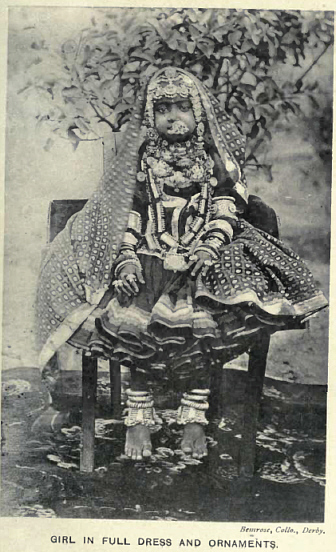
Abb.: Mädchen in vollem Ornat, Zentralindien, um 1916
[Bildquelle: Russell, R. V. (Robert Vane) <1873-1915> ; Hira Lal, Rai Bahadur <1867-1934>: The tribes and castes of the Central Provinces of India. -- London : Macmillan, 1916. -- 4 Bde. -- Bd. 3. -- Nach S. 378]
Siehe:
Watson, J. Forbes (John Forbes) <1827-1892>: The textile manufactures and the costumes of the people of India <Auszüge> / by John Forbes Watson (1866). -- (Quellenkunde zur indischen Geschichte bis 1858 / Alois Payer ; 6. Bewegliche Hinterlassenschaften, 1.). --Fassung vom 2008-03-27. -- http://www.payer.de/quellenkunde/quellen06.htm
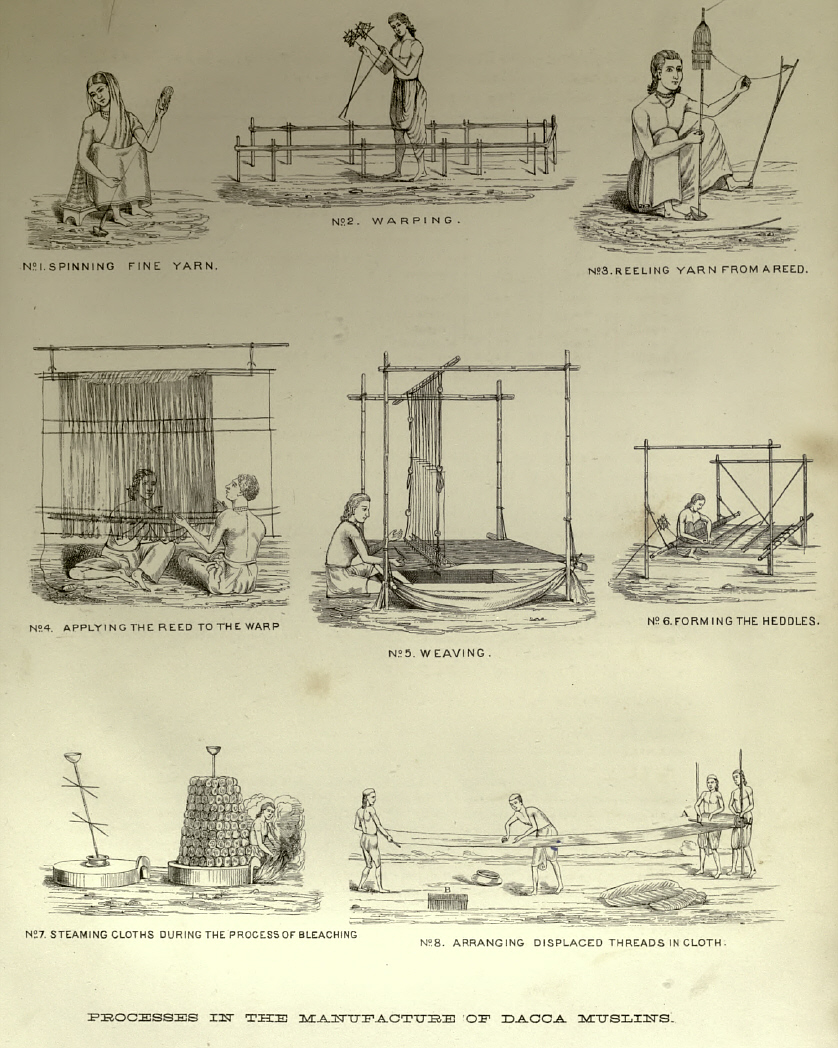
Abb.: Herstellung von Dacca-Musselin
[Bildquelle: Watson, J. Forbes (John Forbes) <1827-1892>: The textile manufactures and the costumes of the people of India. -- London : India Office, 1866. -- xxi, 173 S. : Ill. ; 39 cm. -- Pl. A. -- Online: http://www.archive.org/details/textilemanufactu00watsrich. -- Zugriff am 2008-03-36. -- "Not in copyright"]
Folgende Ausführungen in Balfours Cyclopaedia (1885) geben eine gute Vorstellung von dem herausragenden Können indischer Textilhandwerker:
"TEXTILE ARTS. The east has, from the earliest times of which we have any record, been famous for its textile fabrics ; and India, notwithstanding the great mechanical inventions of the western world, is still able to produce her webs of woven air, which a manufacturer of the 18th century attempted to depreciate by calling them the shadow of a commodity, at the same time that his townsmen were doing all they could to imitate the reality, and which they have not yet been able to excel. Though the invention and completion of a loom for weaving would indicate a high degree of ingenuity as well as a considerable advance in some other arts, the Hindus were acquainted with it at a very early period, for in the hymns of the Rig Veda, composed about 1200 years B.C., weavers' threads are alluded to; and in the Institutes of Menu it is directed, 'Let a weaver who has received ten bales of cotton thread, give them back increased to eleven by the rice-water and the like used in weaving.' That cotton was employed at very early periods, is also evident from the Indian name of cotton, Karpas, occurring in the Book of Esther, i.6, in the account of the hangings in the court of the Persian palace at Shushan, on the occasion of the great feast given by Ahasuerus, -- white, green, and blue hangings ; the word corresponding to green is Karpas in the Hebrew. It seems to mean cotton cloth made into curtains, which were striped white and blue. Such may be seen throughout India in the present day, in the form of what are called purdahs. (Vide Essay on Antiquity of Hindu Medicine, p. 145.) The mode in which these are used, and the employment of the same colours in stripes, is still known as Shatranji, or cotton carpets. That the Hindus were in the habit of spinning threads of different materials, appears from another part of [S. 854] the Institutes of the same lawgiver, where it is directed that the sacrificial threads of a Brahman must be made of cotton, that of a Kshatriya (second caste) of sana (Crotalaria juncea), and that of a Vaisya of woollen thread. The natives of India prepare fabrics not only of cotton, but also of hemp and of jute and other substitutes for flax ; also of a variety of silks, and the wool of the sheep, goat, and camel, as well as mixed fabrics of different kinds. But it is for the delicacy of the muslins, especially of those woven at Dacca, that India was so long famous. From a careful examination of the cottons grown in different parts of India, as well as of those of other parts of the world, we find that it is not owing to any excellence in the raw material that the superiority in the manufacture was due, for English spinners say that the Indian cotton is little fit for their purposes, being not only short but coarse in staple. It is owing, therefore, to the infinite care bestowed by the native spinners and weavers on every part of their work, that the beauty of the fabric is due, aided as they are by that matchless delicacy of touch for which the Hindus have long been famous. According to one of their authors, 'the first, the beat, and most perfect of instruments is the human hand.' The Hindu weaver has been described as hanging his loom to a tree, and sitting with his feet on the ground. But this is the case only with the coarser fabrics ; and a late resident of Dacca has given a minute account of the cotton manufacture of that district, and has shown that great care is bestowed on every part of the process. The spinning-wheel is usually considered to be an improvement upon the distaff and spindle, as modern machinery is upon the inexpensive spinning-wheel. In facilitating work and diminishing expense, the spinning-wheel was no doubt a great improvement, and is still employed throughout India for the ordinary and coarser fabrics. But the spindle still holds its place in the hands of the Hindu women, when employed in spinning thread for the fine and delicate muslins to which the names of Shabnam or Dew of Night, Ab-i-Rawan or Running-water, etc., are applied by natives, and which no doubt formed the Tela vcntosa of the ancients ; and those called Gangitika in the time of Arrian were probably produced in the same locality. Mr. James Taylor, of the Bengal Medical Service, in a report which was sent by the Court of Directors to India, gave much interesting information respecting the cotton manufacture of Dacca. He showed that the Hindu woman first cards her cotton with the jaw-bone of the boalee fish, which is a species of Silurus ; she then separates the seeds by means of a small iron roller worked backwards and forwards upon a flat board. A small bow is used for bringing it to the state of a downy fleece, which is made up into small rolls to be held in the hand during the process of spinning. The apparatus required for this consists of a delicate iron spindle, having a small ball of clay attached to it, in order to give it sufficient weight in turning ; and imbedded in a little clay there is a piece of hard shell, on which the spindle turns with the least degree of friction. A moist air and a temperature of 80° is found best suited to this fine spinning, and it is therefore practised early in the mornings and in the evening, sometimes over a shallow vessel of water, the evaporation from which imparts the necessary degree of moisture. The spinners of yarn for the Chundeyree muslins in the dry climate of North- Western India are described as working in underground workshops, on account of the greater uniformity in the uniformity of the atmosphere. The Indian spinning-wheel is looked upon with contempt by those who look to the polish rather than to the fitness of a tool. Professor Cowper, than whom none was a better judge, observing that the wood-work of some of these spinning-wheels was richly carved, inferred that the strings with which the circumference was formed might have some use, and not have been adopted from poverty or from idleness. In making working models of these instruments, he has found that in no other way could he produce such satisfactory results as by closely imitating the models before him, the strings giving both tension and elasticity to the instrument. The spindles, moreover, being slightly bent or the hand held obliquely, the yarn at every turn of the spindle slips off the end and becomes twisted. The common dimensions of a piece of Dacca muslin are twenty yards in length by one in breadth. There are more threads in the warp than in the woof, the latter being to the former in a piece of muslin weighing twenty tolas or siccas, in the proportion of 9 to 11 ; one end of the warp is generally fringed, sometimes both. The value of a piece of plain muslin is estimated by its length and the number of threads in the warp, compared with its weight. The greater the length and number of threads, and the less the weight of the piece, the higher is its price. It is seldom, however, that a web is formed entirely of the finest thread which it is possible to spin. The local committee of Dacca having given notice that they would award prizes for the best piece of muslin which could be woven in time for the 1851 Exhibition, the prize of 25 rupees was awarded to Hubeeb Oollah, weaver of Golconda, near Dacca. The piece was ten yards long and one wide, weighed only 3 oz. 2 dwts., and might be passed through a very small ring. Though the cotton manufactures of India seem to have greatly fallen off, from the cheapness of English manufactured goods, the report of the Revenue Board, Madras, shows that up to the year 1871 weavers continued to increase in numbers. In the year 1850, it was stated by Dr. Taylor that, as the finest muslins formed but a small portion of goods formerly exported to England, the decay of the Dacca trade has had comparatively little influence on this manufacture, as these delicate manufactures still maintain their celebrity in the country, and are still considered worthy of being included among the most acceptable gifts that can be offered to her native princes ; and he believes that the muslin being then made was superior to the manufacture of 1790, and fully equal to that of the reign of Aurangzeb. Fine muslins have been sent to the Exhibitions in Europe, from Dacca, from Kishengarh in Bengal, from Collar, in the raja of Travanoore's dominions, as well as from Chundeyree in the Gwalior territories. Specimens of almost every variety of the cotton manufacture, such as the coarse garrha and guzzee for packing, clothing, and for covering corpses, with dosootee, etc., for tents, canvas for sails, towels, and table-cloths, and every variety of calico, were sent from Nepal and Assam, as well as from along the valley of the Ganges, from [S. 856] Bengal up to the Jullundhur Doab, in the Sikh territories ; also from Cutch, Ahmadabad, Surat, and Dharwar on the western side of India ; from the central territories of the Nizam, from Nagpur, and from the islands of the Indian Ocean. Fine pieces of calico and punjum longcloth were sent from Juggiapettah, in the Northern Circars, which was formerly the great seat of this manufacture. Some of the places noted for their manufactures did not grow their own cotton. Dacca no doubt grew most of what it required for its muslins, because the thread did not swell in bleaching, but it also imported cotton formerly from Surat, as well as from Central India. Azimgarh imports its cotton chiefly from the same source to which the Northern Circars was also formerly indebted, while Chundeyree imports its cotton from the distant valley of Nimar. The natives are acquainted with every kind of weaving, from guzzee and gauze, to striped, checkered, and flowered muslins. The last are a branch of art which has been long known in the east, and the mode of making which often puzzled weavers in Great Britain. In manufacturing figured (jamdanee) fabrics, Mr. Taylor informs us, they place the pattern, drawn upon paper, below the warp, and range along the track of the woof a number of cut threads, equal to the flowers or parts of the design intended to be made ; and then, with two small, fine-pointed bamboo sticks, they draw each of these threads between as many threads of the warp as may be equal to the width of the figure which is to be formed. When all the threads have been brought between the warp, they are drawn close by a stroke of the ley. The shuttle is then passed, by one of the weavers, through the shed, and the weft having been driven home, it is returned by the other weavers. Most of these flowered muslins are uniform in colour, but some are in two colours, and chiefly woven in Bengal. Specimens of double weaving in cotton, and showing considerable skill, with a pleasing arrangement of pattern and colours, were sent from Khyrpur, in Sind. These kinds are also woven in Ganjam. -- Royle on the Arts and manufactures of India, p. 487."
[Quelle: Balfour, Edward <1813-1889>: Cyclopædia of India and of eastern and southern Asia, commercial, industrial and scientific: products of the mineral, vegetable and animal kingdoms, useful arts and manufactures / ed. by Edward Balfour. -- 3rd ed. -- London: Quaritch. -- Vol. 3. -- 1885. -- S. 854 - 856]
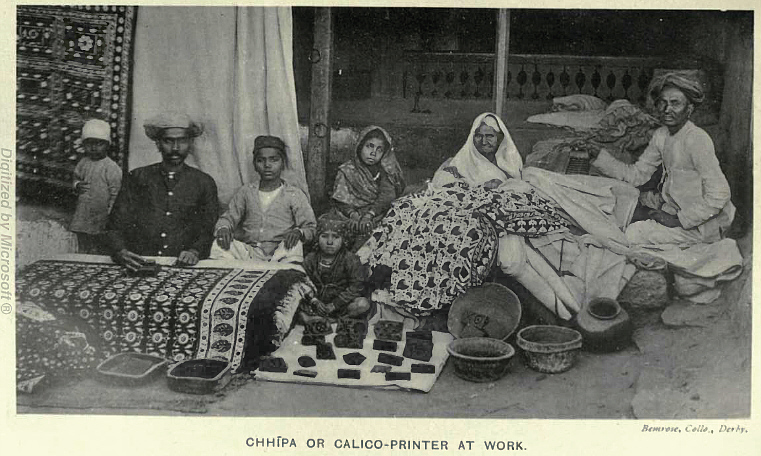
Abb.: Chhīpa (Stoffdrucker)
[Bildquelle: Russell, R. V. (Robert Vane) <1873-1915> ; Hira Lal, Rai Bahadur <1867-1934>: The tribes and castes of the Central Provinces of India. -- London : Macmillan, 1916. -- 4 Bde. -- Bd. 2. -- Nach S. 430.]
"PRINTED CLOTHS. The art of calico-printing is one which was common to the ancient Egyptians and Indians, and is still largely practised by the latter, and with a skill which produces much to be admired, even in the midst of the productions of the world, and after many attempts have been made to improve an art certainly imported from the east. Pliny was acquainted with the art by which cloths, though immersed in a heated dyeing liquor of one uniform colour, came out tinged with different colours, and afterwards could not be discharged by washing. The people of India were found practising the art when first visited by Europeans, and Calicut on the Malabar coast has given its name to calico.
The large cotton chintz counterpanes, called pallampoors (palangposh), which from an early period have been made in the East Indies, are prepared by placing on the cloth a pattern of wax, and dyeing the parts not so protected.
The colours used in calico-printing are derived from all the three kingdoms of nature, but it seldom happens that solutions, infusions, or decoctions of these colours admit of being applied at once to the cloth without some previous preparation, either of the cloth itself, or of the colouring [S. 293] material. It is often necessary to apply some substance to the cloth which shall act us a bond of union between it and the colouring matter. The substance is usually a metallic salt, which has an affinity for the tissue of the cloth as well as for the colouring matter when in a state of solution, and forms with the latter an insoluble compound. Such a substance is called a mordant (from the Latin Mordere, to bite), a term given by the French dyers, under the idea that it exerted a corrosive action on the fibre, expanding the pores, and allowing the colour to be absorbed. The usual mordants are common alum and several salts of alumina, peroxide of tin, protoxide of tin, and oxide of chrome. These have an affinity for colouring matters, but many of their salts have also a considerable attraction for the tissue of the cloth, which withdraws them to a certain extent from their solutions. Mordants are useful for all those vegetable and animal colouring matters which are soluble in water, but have not a strong affinity for tissues. The action of the mordant is to withdraw them from solution, and to form with them, upon the cloth itself, certain compounds which are insoluble in water. In European cloth-printing, although the methods employed are numerous, and the combinations of colours and shades of colour almost infinite, yet each colour in a pattern must, in the present state of the art, be applied by one of six different styles of work. These are termed
the madder style ;
printing by steam ;
the paddling style ;
the resist style ;
the discharge style ; and
the China-blue style.
By the proper combination of two or more of these styles, any pattern, however complicated, is produced. The processes actually required for finishing a piece of cloth are numerous, as, for example, in producing a red stripe upon a white ground, the bleached cloth is submitted to nineteen operations, as follows :
Printing on mordant of red liquor (a preparation of alumina) thickened with flour, and dyeing ;
ageing for three days ;
dunging ;
wincing in cold water ;
wasting at the dash-wheel
wincing in dung-substitute and size ;
wincing in cold water ;
dyeing in madder ;
wincing in cold water ;
washing at the dash-wheel ;
wincing in soap-water containing a salt of tin ;
washing at the dash-wheel ;
wincing in soap-water ;
wincing in a solution of bleaching-powder ;
washing at the dash-wheel ;
drying by the water extractor ;
folding;
starching;
drying by steam.
Indian dyers apply the mordants both by pencils and by engraved blocks. Blocks are used throughout India, but silk handkerchiefs had the parts where the round spots were to be, tied up with thread, so as not to be affected by the dye-liquors, and it was from this process of tying (bandhna) that they received the name of bandana. The cloth-printers at Dacca stamp the figures on cloth which is to be embroidered. The stamps are formed of small blocks of kautul (Artocarpus) wood, with the figures carved in relief. The colouring matter is a red earth imported from Bombay, probably the so-called Indian earth from the Persian Gulf. Though the art is now practised to much perfection in Europe, the Indian patterns still retain their own particular beauties, and command a crowd of admirers. This is no doubt due in a great measure to the knowledge which they have of the effects of colours, and the proportion which they preserve between the ground AIM! toe pattern, by which a good effect is procured both at distance and on a near inspection. Printed cloths are worn occasionally, as in Berar and Bundelkhand, for sarees ; and the ends and borders have peculiar local patterns. There is also a class of prints on coarse cloth, used for the skirte or petticoats of women of some of the lower classes in Upper India ; but the greatest demand for printed cloths is for palempores, or single quilts. In the costlier garments of India, the borders and ends are entirely of gold thread and silk, the former predominating. Printing in gold and in silver is a branch of the art which has been carried to great perfection in India, as well upon thick calico as upon fine muslin. The size which is used is not mentioned, but in the Burmese territory the juice of a plant is used, which no doubt contains caoutchouc in a state of solution.
There is a branch of cotton-printing carried on at Sholapur. The patterns of various kinds are printed upon coarse cloth, and are used for floor-coverings, bed-coverlets, etc. etc., the latter by the poorer classes. The colours are very permanent, and will bear any amount of washing, but are confined to madder reds, and browns, black, dull greens, and yellows. See Dyes.
The object of calico-printing is to apply one or more colours to particular parts of cloth, so as to represent a distinct pattern, and the beauty of a print depends on the elegance of the pattern and the brilliancy and contrast of the colours. The processes employed are applicable to linen, silk, worsted, and mixed fabrics, although they are usually referred to cotton cloth or calico. There are various methods of calico-printing, the simplest of which is block-printing by hand, in which the pattern or a portion thereof is engraved in relief upon the face of a block of sycamore, holly, or pear-tree wood, backed with deal, and furnished with a strong handle of boxwood. A machine, called the perrotine, in honour of its inventor, M. Perrot of Rouen, is in use in France and Belgium as a substitute for hand-block printing. Copperplate printing similar to that used in the production of engravings, has also been applied to calico-printing. The invention of cylinder or roller printing is the greatest achievement that has been made in the art, producing results which are truly extraordinary : a length of calico equal to one mile can by this method be printed off with four different colours in one hour, and more accurately and with better effect than block-printing by hand. By another method of calico-printing, namely, press-printing, several colours can be printed at once. The cloth to be printed is wound upon a roller at one end of the machine, and the design, which is formed in a block of mixed metal about 2½ feet square, is supported with its face downwards in an iron rame, and can be raised or lowered at pleasure. The face of the block is divided into as many stripes, ranging crossways with the table, as there are colours to be printed. -- Royle's Arts of India."
[Quelle: Balfour, Edward <1813-1889>: Cyclopædia of India and of eastern and southern Asia, commercial, industrial and scientific: products of the mineral, vegetable and animal kingdoms, useful arts and manufactures / ed. by Edward Balfour. -- 3rd ed. -- London: Quaritch. -- Vol. 3. -- 1885. -- S. 292f.]
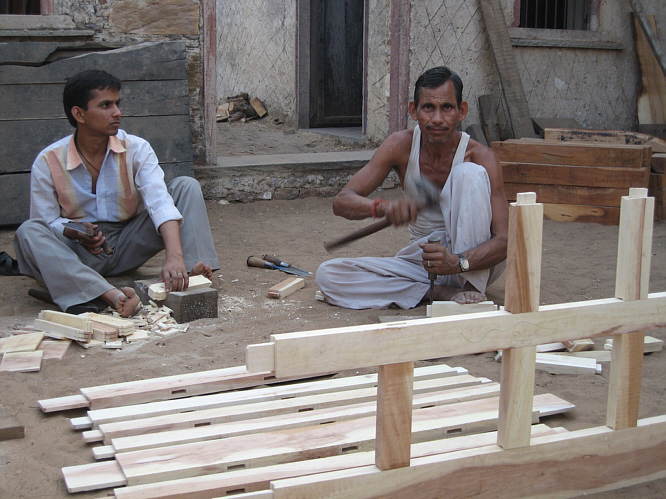
Abb.: Schreiner, Madhogarh (माधोगढ), Rajasthan
[Bildquelle: von Dan.be. --
http://www.flickr.com/photos/70534225@N00/383125840/. -- Zugriff am
2008-04-01. --
![]()
![]()
![]() Creative
Commons Lizenz (Namensnennung, keine kommerzielle Nutzung, keine Bearbeitung)]
Creative
Commons Lizenz (Namensnennung, keine kommerzielle Nutzung, keine Bearbeitung)]
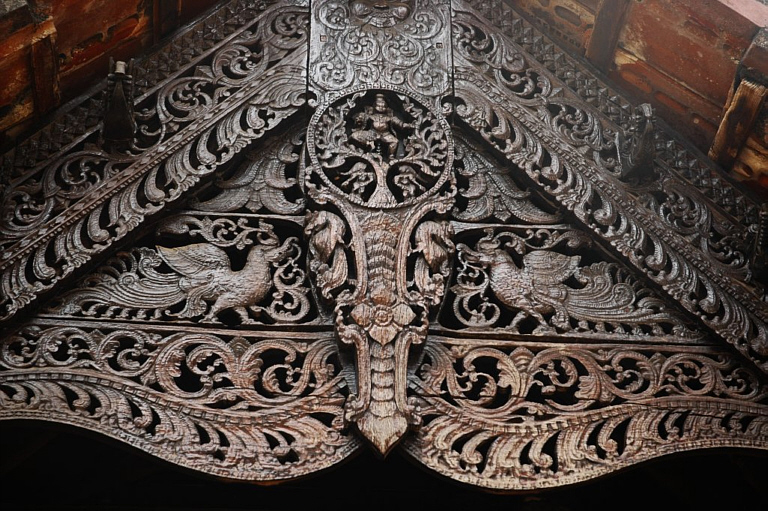
Abb.: Holzschnitzereien, Palast von Padmanabhapuram (பத்மனாபபுரம்), Tamil Nadu,
16-18. Jhdt.
[Bildquelle: deepsan. --
http://www.flickr.com/photos/deepsan/71720163/. -- Zugriff am 2008-04-01. --
![]()
![]()
![]() Creative
Commons Lizenz (Namensnennung, keine kommerzielle Nutzung, keine Bearbeitung)]
Creative
Commons Lizenz (Namensnennung, keine kommerzielle Nutzung, keine Bearbeitung)]
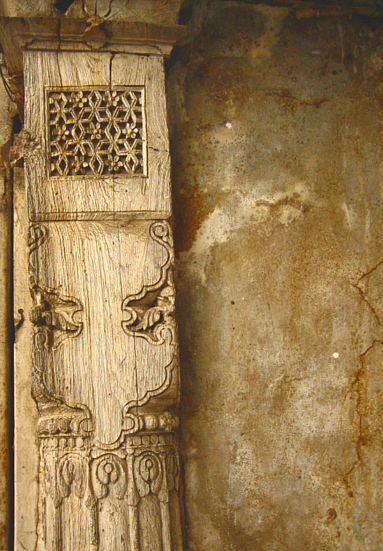
Abb.: Holzarbeit, Ahmedabad (અમદાવાદ),
Gujarat
[Bildquelle: Meanest Indian. --
http://www.flickr.com/photos/meanestindian/403220887/. -- Zugriff am
2008-04-01. --
![]() Creative
Commons Lizenz (Namensnennung)]
Creative
Commons Lizenz (Namensnennung)]
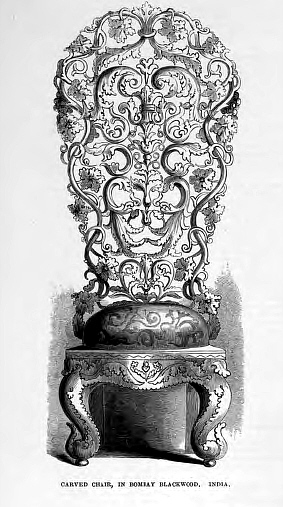
Abb.: Holzarbeit aus Indien, ausgestellt bei der Great Exhibition of the Works
of Industry of all Nations, London 1851
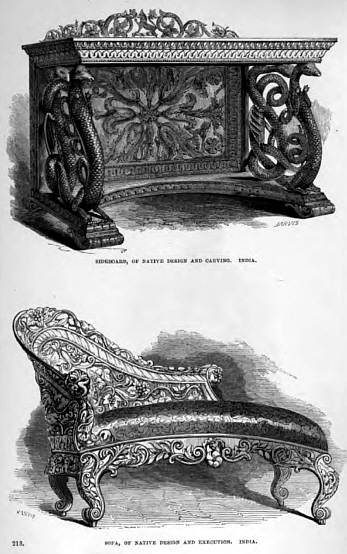
Abb.: Holzarbeit aus Indien, ausgestellt bei der Great Exhibition of the Works
of Industry of all Nations, London 1851
[Quelle der 2 Abb.: Official descriptive and illustrated catalogue of the Great exhibition of the works of industry of all nations, 1851 ... -- London : Spicer, 1851. -- Vol IV: Colonies - foreign states. Division I.]
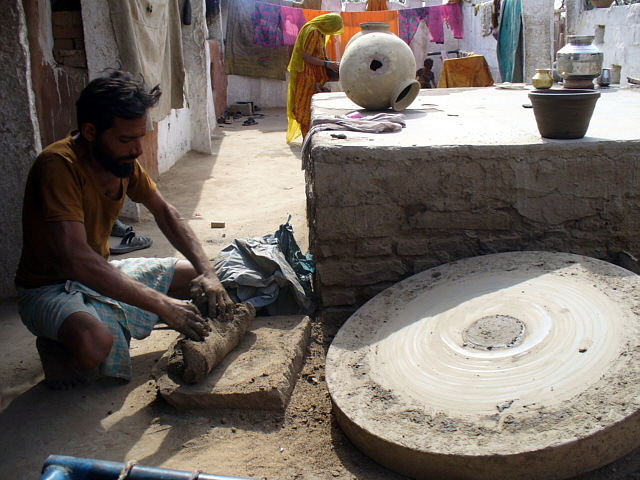
Abb.: Töpfer beim Lehmkneten, Jodhpur (जोधपुर), Rajasthan, 2006
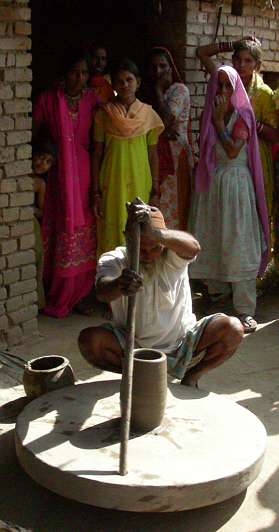
Abb.: Töpfer beim Anwerfen des Rades, 2007
[Bildquelle: liketearsintherain. --
http://www.flickr.com/photos/liketearsintherain/2099356535/. -- Zugriff am
2008-04-01. --
![]()
![]() Creative
Commons lizenz (Namensnennung)]
Creative
Commons lizenz (Namensnennung)]
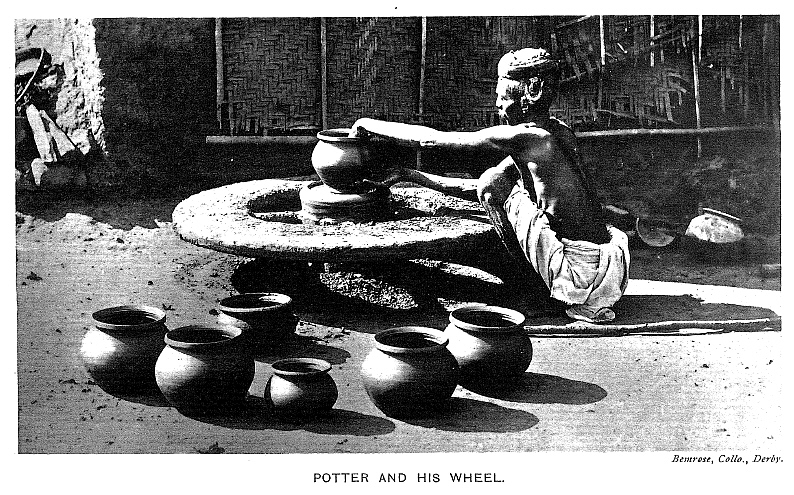
Abb.: Töpfer am Töpferrad, Zentralindien, um 1916
[Bildquelle: Russell, R. V. (Robert Vane) <1873-1915> ; Hira Lal, Rai Bahadur <1867-1934>: The tribes and castes of the Central Provinces of India. -- London : Macmillan, 1916. -- 4 Bde. -- Bd. 4. -- Nach S. 4.]
Abb.: Kusavan (Töpfer), Tamil Nadu, um 1909[Bildquelle: Thurston, Edgar <1855 - 1935> ; Rangachari, K.: Castes and tribes of southern India. -- Madras : Govt. Press, 1909. -- 7 Bde. : ill. ; 24 cm. -- Bd. 4. -- Nach S. 190.]
Abb.: Töpfer beim Ausklopfen eines Topfes, Tiruchchirappalli (திருச்சிராப்பள்ளி), Tamil Nadu, 2007
[Bildquelle: von Dilip Muralidaran. -- http://www.flickr.com/photos/dilipm/364714358/. -- Zugriff am 2008-04-01. --Creative Commons Lizenz (Namensnennung, keine kommerzielle Nutzung)]
Abb.: Töpfer beim Schlagen von Schüsseln auf Matrize, Rajasthan, 2004
[Bildquelle: Dey. -- http://www.flickr.com/photos/dey/1193026371/. -- Zugriff am 2008-04-01. --Creative Commons Lizenz (Namensnennung, keine kommerzielle Nutzung)]
Abb.: Hochzeitstöpfe, Tamil Nadu, um 1909[Bildquelle: Thurston, Edgar <1855 - 1935> ; Rangachari, K.: Castes and tribes of southern India. -- Madras : Govt. Press, 1909. -- 7 Bde. : ill. ; 24 cm. -- Bd. 6. -- Nach S. 18.]
Abb.: Topf-Trommel, Südindien, um 1909[Bildquelle: Thurston, Edgar <1855 - 1935> ; Rangachari, K.: Castes and tribes of southern India. -- Madras : Govt. Press, 1909. -- 7 Bde. : ill. ; 24 cm. -- Bd. 6. -- Nach S. 232.]
"POTTERY. TRUEST to nature, in the directness and simplicity of its forms, and their adaptation to use, and purest in art, of all its homely and sumptuary handicrafts is the pottery of India; the unglazed rude earthenware, red, brown, yellow, or grey, made in every village, and the historical glazed earthenware of Madura, Sindh, and the Panjab.
Unglazed pottery is made everywhere in India, and has been from before the time of Manu : and the forms of it shewn on ancient Buddhist and Hindu sculptures, and the ancient Buddhist paintings of Ajanta, are identical with those still everywhere thrown from the village hand-wheels. In the sculptures of Bhuvaneswar the form of the kalasa, or water jug, is treated with great taste as an architectural decoration, especially in its use as an elegant finial to the temple towers. In the same sculptures is seen the form of another water vessel, identical with the amriti, or "nectar" bottle, sold in the bazaars of Bengal.
It is impossible to attempt any enumeration of the places where unglazed pottery is made, for its manufacture is literally universal, and extended over the whole and to every part of India. Mr. Baden Powell, however, cites the following places in the Panjab as worthy of special mention for their unglazed earthenware: Amritsar, Cashmere, Dera Ghazi Khan, Dera Ismail Khan, Gugranwalla, Hazara, Hushiarpur, Jhelam, Kangra, Kohat, Lahore, Ludhiana, Montgomery, Rawalpindi, and Shahpur. I Bengal the village pottery of Sawan in Patna, of Bardwan, of Ferozepur in Dacca, and Dinajpur in Rajshahye are noted : and in [S. 388] Bombay that of Ahmedabad in Gujarat, and of Khanpur in the collectorate of Belgaum.
The principal varieties of Indian fancy pottery made purposely for exportation are the red earthenware pottery of Travancore and Hyderabad in the Deccan, the red glazed pottery of Dinapur, the black and silvery pottery of Azimghar in the North-Western Provinces, and Surrujgurrah in Bengal (Bhagalpur), and imitation bidri of Patna and Surat in Gujarat, the painted pottery of Kota in Rajputana, the gilt pottery of Amroha also in Rajputana, the glazed and unglazed pierced pottery of Madura, and the glazed pottery of Sindh and the Panjab. In all these varieties of Indian pottery an artistic effect is consciously sought to be produced.
The Azimghar pottery, like most of the art-work of the Benares district, and eastward, is generally feeble and rickety in form and insipid and meretricious in decoration, defects to which its fine black color, obtained by baking it with mustard oilseed cake, gives the greater prominence. The only tolerable example of it I have ever seen is the water-jug in the India Museum, which attracts, and in a way pleases, because of the strangeness of look given to it by the pair of horn-like handles. The silvery ornamentation is done by etching the pattern, after baking, on the surface, and rubbing into it an amalgam of mercury and tin ; thus producing the characteristic mawkish and forbidding effect, which, however, the unsophisticated potter of Azimghar does not attempt to mystify by calling it by any of those artful, advertising "cries" wherewith so much ado about nothing is sometimes made in English high art galleries. Very different is the glazed pottery of Sindh and the Panjab. The charms of this pottery are the simplicity of its shapes, the spontaneity, directness, and propriety of its ornamentation, and the beauty of its coloring. The first thing to be desired in pottery is beauty of form, that perfect symmetry and purity of form which is
"When unadorn'd, adorn'd the most."
[S. 389]
[...]
Also, never more than two or three colors are used, and when three colors are used, as a rule, two of them are [S. 390] merely lighter and darker shades of the same color.
[...]
The potter's art is of the highest antiquity in India, and the unglazed water vessels, made in every Hindu village, are still thrown from the wheel in the same antique forms represented on the ancient Buddhistic sculptures and paintings.
[...]
The only exception is the glazed pottery of Madura, and of Sindh and the Panjab, which alone of the fancy varieties can be classed as art pottery, and as such is of the highest excellence.
Plate 76 (b)The Madura pottery [Plate 76] is in the form generally of water bottles, with a globular bowl and long upright neck; the bowl being generally pierced so as to circulate the air round an inner porous bowl. The outer bowl and neck are rudely fretted all over by notches in the clay, and are glazed either daik green or a rich golden brown.
Plate 70.
Plate 71.
Plate 73.
Plate 74.
Plate 75.The glazed pottery of Sindh [Plates 70-75] is made principally at Hala, Hyderabad, Tatta, and Jerruck, and that of the Panjab at Lahore, Multan, Jang, Delhi, and elsewhere.1 The chief places for the manufacture of encaustic tiles are at Bulri and Saidpur in[S. 399] Sindh.
1 The master potters known to me by name are Jumu, son of Osman the Potter. Karachi ; Mahommed Azim, the Pathan, Karachi ; Messrs. Nur; Mahommecl, and Kadmil, Hyderabad ; Ruttu Wuleed Minghu, Hyderabad ; and Peranu, son of Jumu, Tatta. Mr. Kipling sends me the name of Mahommed Hashim at Multan.
[...]
It is found in the shape of drinking cups, and water bottles, jars, bowls, plates, and dishes of all shapes and sizes, and of tiles, pinnacles for the tops of domes, pierced windows, and other architectural accessories. In form, the bowls, and jars, and vases may be classified as egg-shaped, turband, melon, and onion-shaped, in the latter the point rising and widening out gracefully into the neck of the vase. They are glazed in turquoise, of the most perfect transparency, or in a [S. 400] rich dark purple, or dark green, or golden brown. Sometimes they are diapered all over by the pâte-sur-pâte method, with a conventional flower, the seventy or lotus, of a lighter color than the ground. Generally they are ornamented with the universal knop and flower pattern, in compartments formed all round the bowl, by spaces alternately left uncolored and glazed in color. Sometimes a wreath of the knop and flower pattern is simply painted round the bowl on a white ground [Plate 72].
Plate 72.[...]
It is a rare pleasure to the eye to see in the polished corner of a native room one of these large turquoise blue sweetmeat jars on a fine Kirman rug of minimum red ground, splashed with dark blue and yellow. But the sight of wonder is, when travelling over the plains of Persia or India, suddenly to come upon an encaustic-tiled mosque. It is colored all over in yellow, [S. 401]green, blue, and other hues; and as a distant view of it is caught at sunrise, its stately domes and glittering minarets seem made of purest gold, like glass, enamelled in azure and green, a fairy-like apparition of inexpressible grace and the most enchanting splendor.
In giving the following receipts of the different preparations used in enamelling Sindh and Panjab pottery, it is as well to say that they are of little practical value out of those countries. It will be noted that a great deal is thought, by the native manufacturers, to depend on the particular wood, or other fuel used, in the baking, which, if it really influences the result, makes all attempts at imitating local varieties of Indian pottery futile.
In the glazing and coloring two preparations are of essential importance, namely kanch, literally glass, and sikka, oxides of lead. In the Panjab the two kinds of kanch used are distinguished as Angrezi kanchi, "English glaze," and desi-kanchi, "country glaze."
Angrezi kanchi is made of sang-i-safed, a white quartzose rock 25 parts; sajji, or pure soda, 6 parts; sohaga telia, or pure borax, 3 parts ; and nausadar or sal ammoniac, 1 part. Each ingredient is finely powdered and sifted, mixed with a little water, and made up into white balls of the size of an orange. These are red-heated, and after cooling again, ground down and sifted. Then the material is put into a furnace until it melts, when clean-picked shora kalmi, or saltpetre, is stirred in. A foam appears on the surface, which is skimmed off and set aside for use. The desi-kanchi is similarly made, of quartzose rock and soda, or quartzose rock and borax, or siliceous sand and soda. A point is made of firing the furnace in which the kanch is melted with kikar, karir, or Capparis wood.
Four sikka, or oxides of lead, are known, namely, sikka safed, white oxide, the basis of most of the blues, greens, and greys used ; sikka zard, the basis of the yellows ; sikka sharbati, litharge ; and sikka lal, red oxide.
[S. 402] Sikka safed is made by reducing the lead with half its weight of tin ; sikka zard by reducing the lead with a quarter of its weight of tin ; sikka sharbati by reducing with zinc instead of tin ; and sikka lal in the same way, oxidising the lead until red. The furnace is always heated in preparing these oxides with jhand, or Prosopis wood. The white glaze is made with one part of kanch and one part sikka safed (white oxide) well ground, sifted, and mixed, put into the kanch furnace, and stirred with a ladle. When melted, borax in the proportion of two chittaks to the ser (1 chittak = 1/16 ser ; 1 ser = 2 2/5 lbs. avoirdupois) is added. If the mixture blackens, a small quantity of shora kalmi, or saltpetre, is thrown in. When all is ready, the mixture is thrown into cold water, which splits it into splinters, which are collected and kept for use. All the blues are prepared by mixing either copper or manganese, or cobalt, in various proportions with the above white glaze. The glaze and coloring matter are ground together to an impalpable powder ready for application to the vessel.
The following are the blue colors used :
Firoza, turquoise blue: 1 ser of glaze, and 1 chittak of chhiltamba, or calcined copper.
Firozi-abi, pale turquoise: 1 ser of glaze, and 1/24 of calcined copper.
Nila, indigo blue: 1 ser of glaze, and 4 chittaks of reta, or zaffre (cobalt).
Asmani, sky blue: 1 ser of glaze, and 1½ chittak of zaffre.
Halka-abi, pale sky blue: 1 ser of glaze, and 1 chittak of zaffre.
Kasni, pink or lilac: 1 ser of glaze, and 1 chittak of anjani, or oxide of manganese.
Sosni, violet: 1 ser of glaze, and 1 chittak of mixed manganese and zaffre.
Uda, purple or puce: 1 ser of glaze, and 2 chittak of manganese.
Khaki, grey: 1 ser of glaze, and 1½ chittak of mixed manganese and zaffre.
The rita or zafifre is the black oxide of cobalt found all over Central and Southern India, which has been roasted and powdered, [S. 403] mixed with a little powdered flint. Another mode of preparing the nila, or indigo blue glaze, for use by itself, is to take:
Powdered flint: 4 parts.
Borax: 24
Red oxide of lead: 12
White quartzose rock: 7
Soda: 5
Zinc: 5
Zaffre: 5
All are burnt together in the kanch furnace as before described.
The yellow glaze used as the basis of the greens is made of sikka zard, white oxide 1 ser, and sang safed, a white quartzose rock, or millstone, or burnt and powdered flint, 4 chittaks, to which, when fused, 1 chittak of borax is added.
The green colors produced are :
Zamrudi, deep green: 1 ser of glaze, and 3 chittaks of chhil tamba, or calcined copper.
Sabz, full green: 1 ser of glaze, and 1 chittak of copper.
Pistaki, or Pistachio (bright) green: 1 ser of glaze, and 1½ chittak of copper.
Dhani, or Paddy (young shoots of rice), green: 1 ser of glaze, and 1/125 chittak of copper.
Another green is produced by burning one ser of copper filings with nimak shor, or sulphate of soda.
The colors, after being reduced to powder, are painted on with gum, or gluten. The vessel to receive them is first carefully smoothed over and cleaned, and, as the pottery clay is red when burnt, it is next painted all over with a soapy, whitish engobe prepared with white clay and borax and Acacia and Conocarpus gums called kharya mutti. The powdered colors are ground up with a mixture or nishasta, or gluten and water, called mawa until the proper consistence is obtained, when they are [S. 404] painted on with a brush. The vessels are then carefully dried and baked in a furnace heated with ber, or Zizyphus, or, in some cases, Capparis wood. The ornamental designs are either painted on off-hand, or a pattern is pricked out on paper, which is laid on the vessel and dusted with the powdered color along the prickings, thus giving a dotted outline of the design, which enables the potter to paint it in with all the greater freedom and dash. It is the vigorous drawing, and free, impulsive painting of this pottery which are among its attractions. The rapidity and accuracy of the whole operation is a constant temptation to the inexperienced bystander to try a hand at it himself. You feel the same temptation in looking on at any native artificer at his work. His artifice appears to be so easy, and his tools are so simple, that you think you could do all he is doing quite as well yourself. You sit down and try. You fail, but will not be beaten, arid practise at it for days with all your English energy, and then at last comprehend that the patient Hindu handicraftsman's dexterity is a second nature, developed from father to son, working for generations at the same processes and manipulations.
The great skill of the Indian village potter may be judged also from the size of the vessels he sometimes throws from his wheel, and afterwards succeeds in baking. At Ahmedabad and Baroda, and throughout the fertile pulse and cereal-growing plains of Gujarat, earthen jars, for storing grain, are baked, often five feet high ; and on the banks of the Dol Samudra, in the Dacca division of the Bengal Presidency, immense earthen jars are made of nearly a ton in cubic capacity. The clay figures of Karttikeya, the Indian Mars, made for his annual festival by the potters of Bengal, are often twenty-seven feet in height.
The Indian potter's wheel is of the simplest and rudest kind. It is a horizontal fly-wheel, two or three feet in diameter, loaded heavily with clay around the rim, and put in motion by the hand ; and once set spinning, it revolves for five or seven minutes with a perfectly steady and true motion. The clay to be moulded is [S. 405] heaped on the centre of the wheel, and the potter squats down on the ground before it. A few vigorous turns and away spins the wheel, round and round, and still and silent as a "sleeping" top, while at once the shapeless heap of clay begins to grow under the potter's hand into all sorts of faultless forms of archaic fictile art, which are carried off to be dried and baked as fast as they are thrown from the wheel. Any polishing is done by rubbing the baked jars and pots with a pebble. There is an immense demand for these water-jars, cooking-pots, and earthen frying-pans and dishes. The Hindus have a religious prejudice against using an earthen vessel twice, and generally it is broken after the first pollution, and hence the demand for common earthenware in all Hindu families. There is an immense demand also for painted clay idols, which also are thrown away every day after being worshipped ; and thus the potter, in virtue of his calling, is an hereditary officer in every Indian village. In the Dakhan, the potter's field is just outside the village. Near the wheel is a heap of clay, and before it rise two or three stacks of pots and pans, while the verandah of his hut is filled with the smaller wares and painted images of the gods and epic heroes of the Rayamana and Mahabharata. He has to supply the entire village community with pitchers and cooking pans, and jars for storing grain and spices and salt, and to furnish travellers with any of these vessels they may require. Also, when the new corn begins to sprout, he has to take a water-jar to each field for the use of those engaged in watching the crop. But he is allowed to make bricks and tiles also, and for these he is paid, exclusively of his fees, which amount to between 4 l. and 5 l. a year. Altogether he earns between 10 l. and 12 l. a year, and is passing rich with it. He enjoys, beside, the dignity of certain ceremonial and honorific offices. He bangs the big drum, and chants the hymns in honour of Jami, an incarnation of the great goddess Bhavani, at marriages ; and at the dowra, or village harvest home festivals, he prepares the barbat [S. 406] or mutton stew. He is, in truth, one of the most useful and respected members of the community, and in the happy religious organisation of Hindu village life there is no man happier than the hereditary potter, or kumbar.
We cannot overlook this serenity and dignity of his life if we would rightly understand the Indian handicraftsman's work. He knows nothing of the desperate struggle for existence which oppresses the life and crushes the very soul out of the English working man. He has his assured place, inherited from father to son for a hundred generations, in the national church and state organisation ; while nature provides him with everything to his hand, but the little food and less clothing he needs, and the simple tools of the trade.
[...]
[S. 416]
The Bombay School of Art Pottery we owe chiefly to the exertions of Mr. George Terry, the enthusiastic superintendent of the school, who has a quick sympathy with native art. He has introduced some of the best potters from Sindh, and the work Mr. Terry's pupils turn out in the yellow glaze in Bombay is now with difficulty distinguishable from the indigenous pottery of Sindh. It is only to be identified by its greater finish, which is a fault. The School of Art green and blue pottery always betrays its origin by some inherent defect in the glaze or clay used. Mr. Terry has also developed two original varieties of glazed pottery at Bombay, the designs in one being adapted with great knowledge and taste from the Ajanta cave paintings, and the popular mythological paintings of the Bombay bazaars ; while in the other they are of his, or his pupils' own inspiration, and derived from leaf and flower forms. Examples of all these varieties of the [S. 417] Bombay School of Art Pottery, of the imitation Sindh and the Terry ware, have been put together in a separate case in the India Museum. The glazed pottery which comes from Bombay of Sindhian designs on Chinese and Japanese jam and pickle pots are a violation of everything like artistic and historical consistency in art, and if they are not ignorant productions of the pupils of the School of Art they are a most cruel slander on them."
[Quelle: Birdwood, George C. M. (George Christopher Molesworth) <1832-1917>: The industrial arts of India. -- London : Chapman and Hall. -- 20 cm. -- (South Kensington Museum art handbooks). -- Vol. 2. -- 1884. -- S. 387 - 417. -- Online: http://www.archive.org/details/industrialartsof00birduoft. -- Zugriff am 2008-03-24. -- "Not in copyright".]
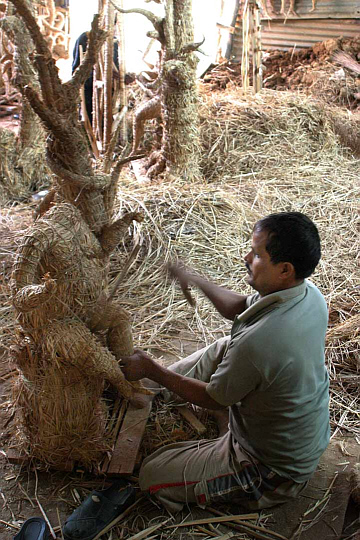
Herstellung einer Lehmfigur Gaṇeśas für Gaṇeś Caturthī (गणेश चतुर्थी): Gerüst
aus Stroh
[Bildquelle: babasteve. --
http://www.flickr.com/photos/babasteve/1395177994/. -- Zugriff am
2008-04-01. --
![]() Creative
Commons Lizenz (Namensnennung)]
Creative
Commons Lizenz (Namensnennung)]
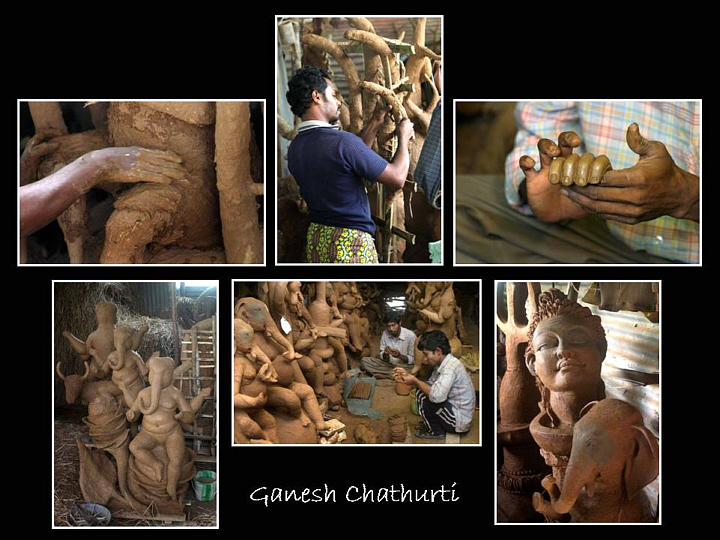
Herstellung einer Lehmfigur Gaṇeśas für Gaṇeś Caturthī (गणेश चतुर्थी): Auftragen
von Lehm und Modellieren
[Bildquelle: babasteve. --
http://www.flickr.com/photos/babasteve/1395904369/in/set-781175/. -- Zugriff
am 2008-04-01. --
![]() Creative
Commons Lizenz (Namensnennung)]
Creative
Commons Lizenz (Namensnennung)]
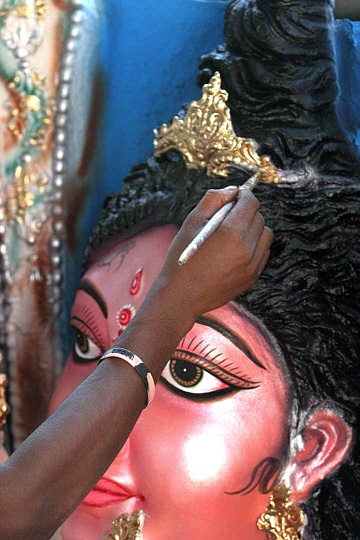
Herstellung einer Lehmfigur Gaṇeśas für Ganesh Chaturthi (गणेश चतुर्थी):
Bemalen der getrockneten Lehmfigur
[Bildquelle: babasteve. --
http://www.flickr.com/photos/babasteve/1399838397/in/set-781175/. -- Zugriff
am 2008-04-01. --
![]() Creative
Commons Lizenz (Namensnennung)]
Creative
Commons Lizenz (Namensnennung)]
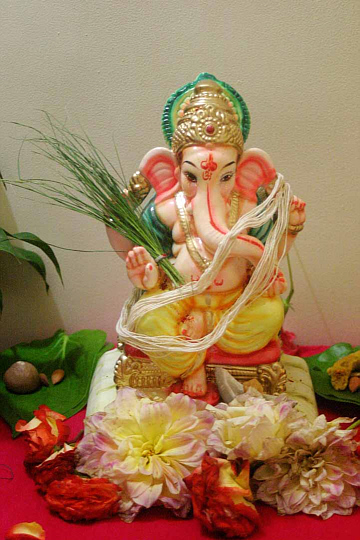
Gaṇeśas für Ganesh Chaturthi (गणेश चतुर्थी)
[Bildquelle: babasteve. --
http://www.flickr.com/photos/babasteve/1387102756/in/set-781175/. -- Zugriff
am 2008-04-01. --
![]() Creative
Commons Lizenz (Namensnennung)]
Creative
Commons Lizenz (Namensnennung)]
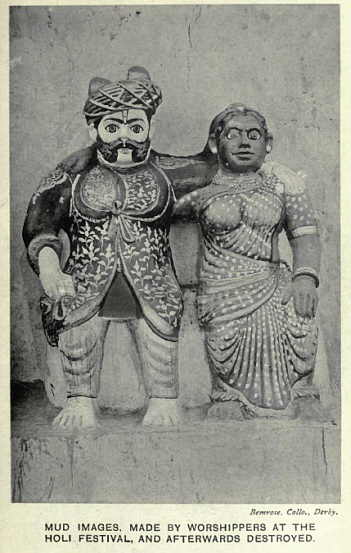
Abb.: Lehmfiguren für Holi-Fest (होली)
[Bildquelle: Russell, R. V. (Robert Vane) <1873-1915> ; Hira Lal, Rai Bahadur <1867-1934>: The tribes and castes of the Central Provinces of India. -- London : Macmillan, 1916. -- 4 Bde. -- Bd. 2. -- Nach S. 126.]
Abb.: Lehmfiguren, Nīlgiri (நீலகிரி), um 1909[Bildquelle: Thurston, Edgar <1855 - 1935> ; Rangachari, K.: Castes and tribes of southern India. -- Madras : Govt. Press, 1909. -- 7 Bde. : ill. ; 24 cm. -- Bd. 7. -- Nach S. 136.]
"Clay Figures.
Figures in clay, painted and dressed up in muslins, silks, and spangles, are admirably modelled at Kishnaghur, Calcutta Lucknow, and Poona. Fruit is also modelled at Gokak, and other villages in the Belgaum Collectorate of the Bombay Presidency, and at Agra and Lucknow. The Lucknow models of fruit are so true to nature as to defy detection until handled. The clay figures of Lucknow are also most faithful and characteristic representations of the different races and tribes of Oudh ; and highly creditable to the technical knowledge and taste of the artists. They are sold on the spot at the rate of four shillings the dozen. Wall brackets, vases, clock-cases, and other articles are also manufactured out of the tenacious clay at the bottom of the tanks in Lucknow ; but they are in a very debased style, being modelled after the Italian work which is to be found all over Lucknow, the old Oudh Nawabs having largely employed Italian sculptors in the building and decoration of their gardens and palaces.
It is very surprising that a people who possess, as their ivory and stone carvings and clay figures incontestably prove, so great a facility in the appreciation and delineation of natural forms should have failed to develop the art of figure sculpture. Nowhere does their figure sculpture shew the inspiration of true art. They seem to have no feeling for it They only attempt a literal transcript of the human form, and of the forms of animals, for the purpose of making toys and curiosities, almost exclusively for sale to English people. Otherwise they use these sculptured forms only in architecture, and their tendency is to subordinate them strictly to the architecture. The treatment of them rapidly becomes decorative and conventional. Their very gods are distinguished only by their attributes and symbolical monstrosities [S. 303] of body, and never by any expression of individual and personal character."
[Quelle: Birdwood, George C. M. (George Christopher Molesworth) <1832-1917>: The industrial arts of India. -- London : Chapman and Hall. -- 20 cm. -- (South Kensington Museum art handbooks). -- Vol. 2. -- 1884. -- S. 302f. -- Online: http://www.archive.org/details/industrialartsof00birduoft. -- Zugriff am 2008-03-24. -- "Not in copyright".]
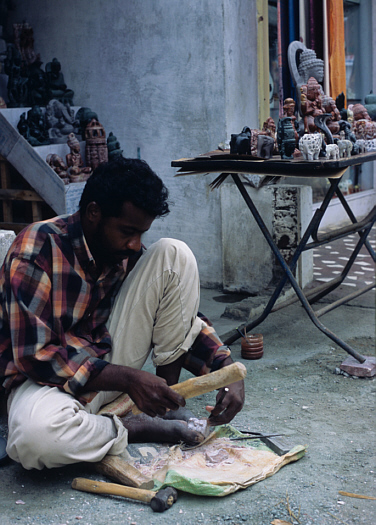
Abb.: Steinbildhauer für Kleinfiguren, Mamallapuram, Tamil Nadu
[Bildquelle: w3p706. --
http://www.flickr.com/photos/w3p706/475394438/. -- Zugriff am 2008-04-01. --
![]()
![]()
![]() Creative
Commons Lizenz (Namensnennung, keine kommerzielle Nutzung)]
Creative
Commons Lizenz (Namensnennung, keine kommerzielle Nutzung)]
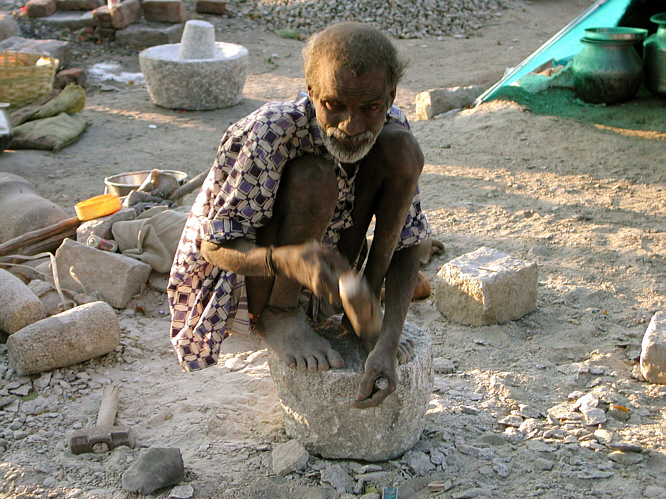
Abb.: Steinhauer, Tirupati (తిరుపతి, திருப்பதி), Andhra Pradesh, 2004
[Bildquelle: isado. --
http://www.flickr.com/photos/isadocafe/13777732/. -- Zugriff am 2008-04-01.
--
![]()
![]() Creative
Commons Lizenz (Namensnennung, keine Bearbeitung)]
Creative
Commons Lizenz (Namensnennung, keine Bearbeitung)]
"Carved Stone. The agate vases of Baroach and Cambay have been famous under the name of Murrhine vases from the time of Pliny. The best carnelians and agates are found at Ratanpur near Baroach, and are taken to Cambay to be worked into cups, saucers, knife-handles, paperweights, beads, bangles, and other ornaments.
Plate 63.Animals are carved in black chlorite at Gaya in the Patna division of Bengal ; and in white marble and reddish sandstone (Plate 63) at Ajmir and other places in Rajputana ; and we find the same truth of representation in these stone carvings as in the best ivory carvings of Amritsar, Benares, and Travancore.
In Rajputana also idols are largely carved in white marble, and brilliantly colored in red, green, yellow, and blue paint and gold. Jade is still carved in Cashmere. At Fattehpur Sikri models in soapstone are made of the celebrated Mahommedan ruins of that city ; and it is also carved into ornamental dishes, inkstands, and other objects. Soapstone ornaments are also made at Gohari in the North-Western Provinces. In Singbhum and Manbhum, in the Chota-Nagpur division of Bengal, there are large masses of soapstone, which the people have for ages worked into platters and cups. On the Nilgiri estate close to Balasore in Orissa, a black chlorite is obtained which is also worked into cups and dishes. Soapstone and potstone ware are manufactured at Tambulghata, and at Kanheri and Pendri, in the Central Provinces. At Nagpur, where in former times the art of stone and wood carving reached a high degree of perfection, there are still many excellent stone carvers among the masons. The art has to a certain extent fallen into disuse, but efforts are being made to revive it. The Chanda masons also are very skilful in carving stone. The stone carvers of Katch and Kathiwar are celebrated all over Western India. [S. 299]
The early Mahommedan architecture of Ahmedabad has been remarkably influenced by these clever Hindu masons. Afterwards the taste of their Mahommedan masters reacted on their own work, as is strikingly seen in the Jaina temples of Palitana and other parts of Gujarat. At Malwan and Patgaum, in the Ratnagiri Collectorate of the Bombay Presidency, a soft slatey stone is carved into cups after the schistose models imported into Western India from Persia. The masons of Sargiddapanam in Nellore (Madras) are noted for their stone sculpture on the native towers called Galegopurams ; and those of Buchereddipalem for their sculpture on the granite pillars of the local temples. The masons also of Udayagiri in this district are skilled in stone carving. The masons of Tumkur in Mysore are specially noted for the stone idols they carve. Stone jugs are largely manufactured at Kavaledurga in Mysore.
Captain Cole, R.E., who has paid special attention to the ancient stone sculptures of India, in his Catalogue to the Objects of Indian Art exhibited in the South Kensington Museum, 1874, classifies them in the two divisions :
Statues and bas-reliefs.
Decorative sculpture for architectural purposes.
Under the head of statues and bas-reliefs he enumerates :
The Buddhistic figure sculptures of the Asoka edict pillars, and of the Sanchi and Amaravati topes ; and the Graeco-Buddhistic remains in the Peshawur district.
The Jaina sculptures, of the twenty-four hierarchs of that sect in Rajputana, at Gwalior, at Benares, and Mahoba, and in Bandelkhand.
The Brahmanical bas-reliefs of Pandrethan and Marttand in Cashmere, at Bindraband, at Eran and Pathari near Bhilsa, at Khajuraho in Bandelkhand, and at Puri in Kattack.
The Mahommedan sculptures, consisting of the two carved elephants which formerly stood outside the gates of Delhi, and similar statues at Fattehpur Sikri and Ahmedabad.
[S. 300] The best examples of decorative sculptures are :
The Buddhist, of the Sarnath, Sanchi, and Amravati topes, and the caves of Ellora, Kanheri, and Ajanta.
The Jaina, of the temples of Mount Abu, at Khajuraho, the ancient capital of Bandelkhand, at Sonari, and in the fort at Gwalior.
The Brahmanical at Avantipur in Cashmere, of the temples at Benares, and at Bindraband, at the Kutub at Delhi, of Tirumulla Nayak's (Trimul Naik's) Choultri at Madura, and the Kylas at Ellora.
- The Mahommedan, namely :
The Pathan, decorative carving of Kutub-ud-din's gateway at Delhi, A.D. 1193 ; the Kutub Minar, at Delhi, A.D. 1200 ; and the palace at Ahmedabad.
The Mogol, of the palaces at Fattehpur Sikri, and the Taj Mahal at Agra."
[Quelle: Birdwood, George C. M. (George Christopher Molesworth) <1832-1917>: The industrial arts of India. -- London : Chapman and Hall. -- 20 cm. -- (South Kensington Museum art handbooks). -- Vol. 2. -- 1884. -- S. 298 - 301. -- Online: http://www.archive.org/details/industrialartsof00birduoft. -- Zugriff am 2008-03-24. -- "Not in copyright".]
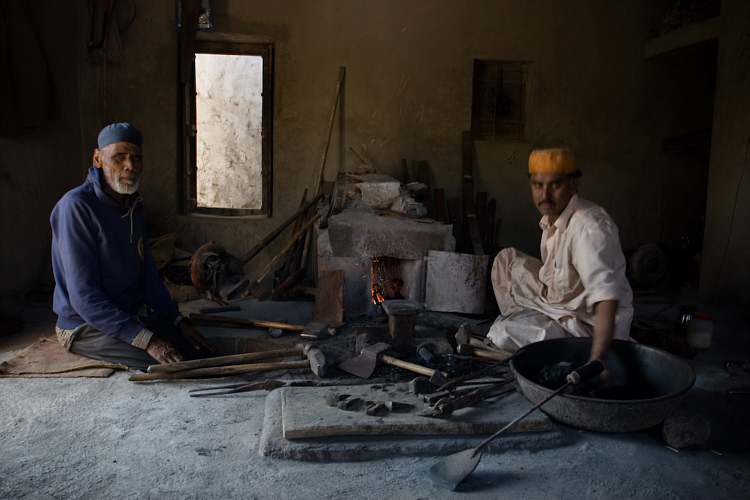
Abb.: Schmiede, Gujarat, 2008
[Bildquelle: owenstache. --
http://www.flickr.com/photos/owen-pics/2331791031/. -- Zugriff am
2008-04-01. --
![]()
![]()
![]() Creative
Commons Lizenz (Namensnennung, keine kommerzielle Nutzung, keine Bearbeitung)]
Creative
Commons Lizenz (Namensnennung, keine kommerzielle Nutzung, keine Bearbeitung)]
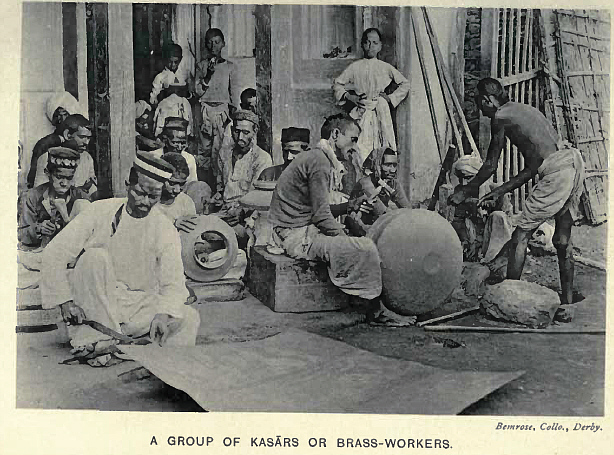
Abb.: Kasārs (Messing- und Kupferarbeiter), Zentralindien, um 1916
[Bildquelle: Russell, R. V. (Robert Vane) <1873-1915> ; Hira Lal, Rai Bahadur <1867-1934>: The tribes and castes of the Central Provinces of India. -- London : Macmillan, 1916. -- 4 Bde. -- Bd. 3. -- Nach S. 370.]
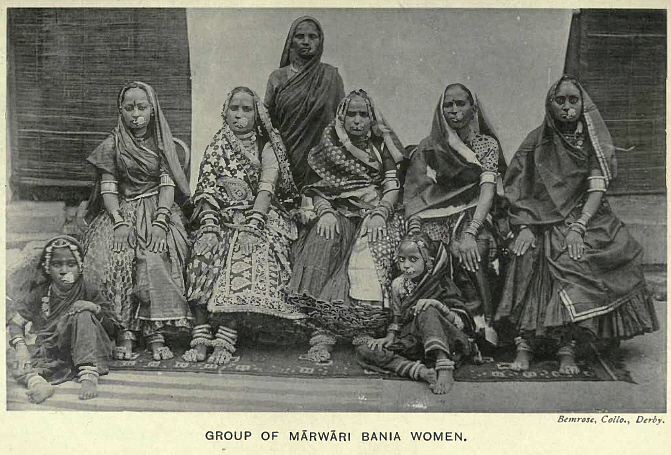
Abb.: Bania-Frauen, Mārwār (मारवाड़), Rajasthan, um 1916
[Bildquelle: Russell, R. V. (Robert Vane) <1873-1915> ; Hira Lal, Rai Bahadur <1867-1934>: The tribes and castes of the Central Provinces of India. -- London : Macmillan, 1916. -- 4 Bde. -- Bd. 2. -- Nach S. 112]
Abb.: Männerschmuck eines Palian, Tamil Nadu, um 1909[Bildquelle: Thurston, Edgar <1855 - 1935> ; Rangachari, K.: Castes and tribes of southern India. -- Madras : Govt. Press, 1909. -- 7 Bde. : ill. ; 24 cm. -- Bd. 5. -- Nach S. 468.]
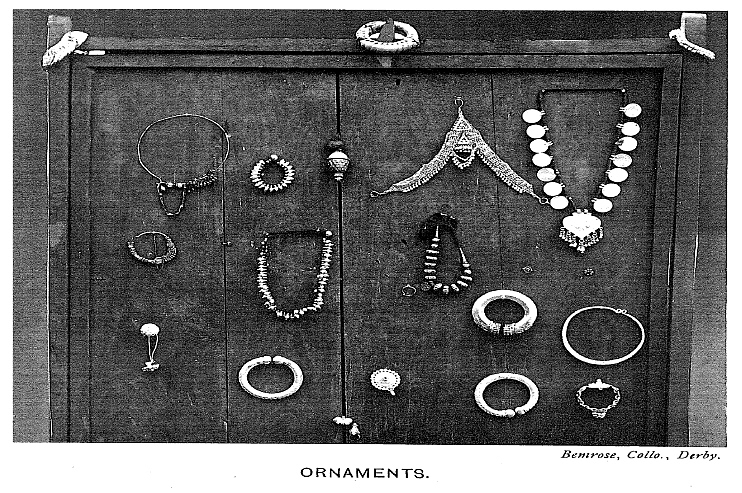
Abb.: Schmuck, Zentralindien, um 1916
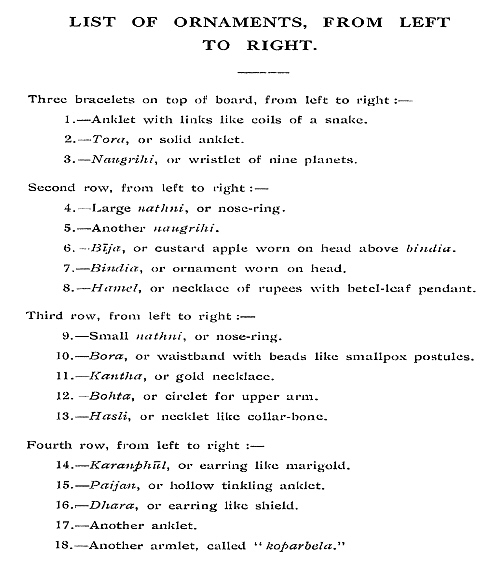
[Bildquelle: Russell, R. V. (Robert Vane) <1873-1915> ; Hira Lal, Rai Bahadur <1867-1934>: The tribes and castes of the Central Provinces of India. -- London : Macmillan, 1916. -- 4 Bde. -- Bd. 4. -- Nach S. 524.]
Abb.: Schmuck von Nāttukottai Chettis (Geldverleiher), Tamil Nadu, um 1909[Bildquelle: Thurston, Edgar <1855 - 1935> ; Rangachari, K.: Castes and tribes of southern India. -- Madras : Govt. Press, 1909. -- 7 Bde. : ill. ; 24 cm. -- Bd. 5. -- Nach S. 264.]
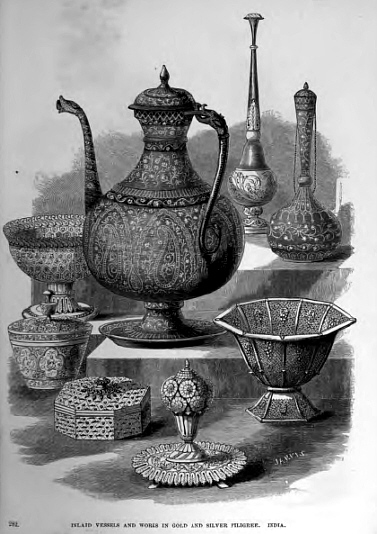
Abb.: Gold- und Silberwaren aus Indien, ausgestellt bei der Great Exhibition of
the Works of Industry of all Nations, London 1851
[Bildquelle: Official descriptive and illustrated catalogue of the Great exhibition of the works of industry of all nations, 1851 ... -- London : Spicer, 1851. -- Vol IV: Colonies - foreign states. Division I.]
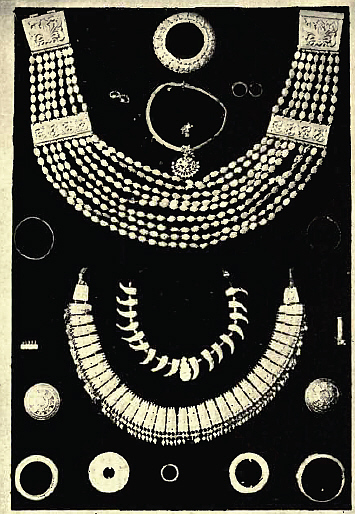
Abb.: Schmuck, wie er von Nāyar-Frauen (നായര്), Kerala, getragen wurde, um
1901
[Bildquelle: Fawcett, F.: Nāyars of Malabar. -- Madras : Government Press, 1915. -- (Bulletin / Madras Government Museum ; Vol. III, No.3. -- Pl. X.]
"JEWELRY. [S. 243] EVEN a greater variety of style is seen in Indian jewelry than in Indian arms. Mr. W. G. S. V. FitzGerald sent to the Annual International Exhibition of 1872, a collection of the grass ornaments worn by the wild Thakurs and Katharis of Matheran, and the Western Ghats of Bombay, which had been made by Dr. T. Y. Smith, the accomplished Superintendent of that Hill Station ; and by the side of these grass collars, necklaces, bracelets, anklets, and girdles, were exhibited also examples of the gold jewelry of thick gold wire, twisted into the girdles, bracelets, anklets, necklaces, and collars, worn all over India, and which are fashioned in gold exactly as the Matheran ornaments are fashioned in grass. [...] Necklaces of gold are also worn in Western India which are identical in character with the Matheran necklaces of chipped and knotted grass, which indicate the origin also of the peculiar Burmese necklaces, formed of tubular beads of ruddy gold strung together, and pendent from a chain which goes round the neck, from which [S. 244] the strings of tubular beads of gold hang down in front, like a golden veil. The details in these Burmese necklaces are often variously modified, the gold being wrought into flowers, or replaced by strings of pearl and gems, until all trace of their suggested origin is lost. By the side of Mr. FitzGerald's collection, I exhibited the "fig-leaf" worn by the women in the wilder parts of India, and which in many places is their only clothing. First was shewn the actual "fig-leaf," the leaf of the sacred fig, or pipal, Ficus religiosa ; next a literal transcript of it in silver, and then the more or less conventionalised forms of it, but all keeping the heart-shape of the leaf; the surface ornamentation in these conventionalised silver leaves being generally a representation of the pipal tree itself, or some other tree, or tree-like form, suggesting the "Tree of Life" of the Hindu Paradise on Mount Meru. These silver leaves are suspended from the waist, sometimes, like the actual leaf, by a simple thread, but generally by a girdle of twisted silver with a serpent's head where it fastens in front; [...] The forms of the champaca (Michelia Champaca) bud, and of the flowers of the babul (Acacia arabica) and seventi (Chrysanthemum species), the name of which is familiar in England through the story of "Brave Seventi Bhai," "the Daisy Lady," in Miss Frere's Old Deccan Days, are commonly used by Indian jewellers for necklaces and hairpins, as well as of the fruit of the anola or aonla (Phyllanthus emblica9 and ambgul (Elaeagnus Koluga), and mango, or amb (Mangifera indica). The bell-shaped earring, with smaller bells hanging within it, is derived from the flower of the sacred lotus : and the cone-shaped earrings of Cashmere, in ruddy gold, represent the lotus flower-bed. [...] [S. 245]
As primitive probably as the twisted gold wire forms of Indian jewelry, is the chopped gold form of jewelry worn also throughout India, the art of which is carried to the highest perfection at Ahmedabad and Surat in Western India. It is indeed worn chiefly by the people of Gujarat. It is made of chopped pieces, like jujubes, of the purest gold, flat, or in cubes, and, by removal of the angles, octahedrons, strung on red silk. It is the finest archaic jewelry in India. The nail-head earrings are identical with those represented on Assyrian sculptures. It is generally in solid gold, for people in India hoard their money in the shape of jewelry; but it is also made hollow to perfection at Surat, the flat pieces, and cubes, and octahedrons being filled with lac or dammar.
The beaten silver jewelry of the Gonds, and other wild tribes of the plains of India, and valleys of the inner Himalayas, is also very primitive in character. The singular brooch worn by the women of Ladak (v. Miss Gordon Cumming's From the Hebrides to the Himalayas, 1876, p. 219), is identical with one found among Celtic remains in Ireland and elsewhere. It is formed of a flat and hammered silver band, hooped in the centre, with the ends curled inward on the hoop ; and this is too artificial a shape to have arisen independently in India and Europe, and must have travelled westward with the Celtic emigration from the East. Its form is evidently derived from the symbols of serpent and phallic worship.
The waist-belt of gold or silver, or precious stones, which is worn in India to gird up the dhoti, or cloth worn about the legs, recalls the Roman cingulum ; [...] [S. 246] in India, at the ceremony of investiture with the sacrificial thread, an identical ornament, a hollow hemisphere of gold, hung from a yellow cotton thread or chain of gold, is taken from the boy's neck, and the sacred cord, the symbol of his manhood, is put on him.
The nava-ratna or nao-ratan, an amulet or talisman composed of "nine gems," generally the Coral, Topaz, Sapphire, Ruby, flat Diamond, cut Diamond, Emerald, Hyacinth, and Carbuncle [...]. This ancient ornament gave its name as a collective epithet to the "nine-gems" or sages of the Court of Vikramaditya, B.C. 56. In books the nine gems of the amulet are said to be pearl, ruby, topaz, diamond,, emerald, lapis- lazuli, coral-sapphire, and a stone, not identified, called gomeda. The tri-ratna, is the "triple-gemmed" "Alpha and Omega" jewel of the Buddhists, symbolical of Buddha, the Law, and the Church.
The jeweller's and goldsmith's art in India is indeed of the highest antiquity, and the forms of Indian jewelry as well as of gold and silver plate, and the chasings and embossments decorating them, have come down in an unbroken tradition from the Ramayana and Mahabharata. [...] [S. 247] But the earliest records, the national epics, and ancient sculptures and paintings, represent the Hindu forms of Indian jewelry, and gold and silver plate, and common pottery and musical instruments, and describe them, exactly as we have them now.
[...]
[249]
After the archaic jewelry of Ahmedabad, the best Indian jewelry, of the purest Hindu style, is the beaten gold of Sawuntwadi, Mysore, Vizianagram, and Vizagapatam, which well illustrates the admirable way in which the native workers in gold and silver elaborate an extensive surface of ornament out of apparently a wholly inadequate quantity of metal, beating it almost to the thinness of tissue paper, without at all weakening its effect of solidity. By their consummate skill and thorough knowledge and appreciation of the conventional decoration of surface, they contrive to give to the least possible weight of metal, and to gems, commercially absolutely valueless, the highest possible artistic value, never, even in their excessive elaboration of detail, violating the fundamental principles of ornamental design, nor failing to please, even though it be by an effect of barbaric richness and superfluity. [...] and so demoralising is the rage for weight that English purchasers, attracted by the eye to Indian jewelry, directly they find how light it is in the hand, reject it as rubbish ; the cost of Indian jewelry being from one-twentieth to one-fourth in excess of its net weight. The jury on jewelry at the Great Exhibition of 1851 actually wrote of Indian jewelry: "It is sufficient to cast a glance on the exhibitions of India, Turkey, Egypt, Tunis, to be convinced that these nations have remained stationary [S. 250] from a very early period of manufacture. Some of them indeed develop ideas full of grace and originality, but their productions are always immature and imperfect, and the skill of the workman is called in to make amends for the inadequateness of the manufacturing process." Surely it is better to remain stationary than to fall, as we have in England, from the thin beaten silver of Queen Anne's reign, and the designs of Adams, to the present unseemly dead-weight silver and gold manufactures of Birmingham and London, for which customers have to pay four times more than the value of their weight. Its false appearance of richness and solidity, and flaunting gorgeousness, is in fact one of the charms of Indian jewelry, especially in an admiring but poor purchaser's eyes. You see a necklace, or whatever ornament it may be, made up apparently of solid, rough cut cubes of gold, but it is as light as pith. Yet, though hollow, it is not false. It is of the purest gold, "soft as wax," and it is this which gives to the flimsiest and cheapest Indian jewelry its wonderful look of reality. [...] As was noticed under the head of "Arms," the Indian jeweller thinks only of producing the sumptuous, imposing effect of a dazzling variety of rich and brilliant colours, and nothing of the purity of his gems. He must have quantity, and cares nothing for commercial quality, and the flawed "tallow drop" emeralds, and foul spinel rubies, large as walnuts, and ere splinters and scales of diamonds, which he so lavishly uses, are often valueless, except as points, and sparkles, and splashes of effulgent coloring: but nothing can exceed the skill, artistic feeling, and effectiveness with which gems are used in India both in jewelry proper, and in the jewelled decoration of arms, and plate. In nothing indeed do the people of India display their naturally gorgeous and costly taste so [S. 251] much as in their jewelry and jewelled arms, which are not only fabricated of the richest and rarest materials, but wrought likewise with all the elaborateness, delicacy, and splendour of design within the reach of art. Megasthenes was struck by the contrast of their love of sumptuous ornament, to the general simplicity of their lives.
Plate 44.
Plate 45.The finest gemmed and enamelled jewelry in India Is that of Cashmere and the Panjab, the Aryan type of which extends across Rajputana to Delhi and Central India, and in a debased meretricious form throughout Bengal. It consists of tires, aigrettes, and other ornaments for the head, and for hanging over the forehead; earrings and ear-chains, and studs of the seventi flower ; noserings and nose-studs ; necklaces, made up, some (Plate 44) of chains of pearls and gems, falling on the breast almost like a stomacher of gems, and others (Plate 45) of tablets of gold set with precious stones, strung together by short strings of mixed pearls and turquoises, with a large pendant hanging from the middle, gemmed in front, and exquisitely enamelled, like all the rest of this necklace, or rather collar, at the back ; and armlets, bracelets, rings, and anklets ; all in never ending variations of form, and of the richest and loveliest effects in pearl, turquoise, enamel, ruby, diamond, sapphire, topaz, and emerald. The bracelets often end in the head of some wild beast, like the bracelets of the Assyrian sculptures; and the plaques are sometimes enamelled at the back with birds or beasts affronté on either side of the taper "cypress" tree, or else some wide-spreading tree [...] The long dangling necklaces worn by the women are called lalanti, i.e. "danglers," or "dalliers," and mohanmala, i.e. "garlands or spells of enchantment."
The jewelry of Cashmere is identical with that of the rest of the Panjab in form, but what I have seen of it has been in [S. 252]gold, and the choicest specimens in "ruddy gold," combining a good deal of gold filigrain work. [...] .
The gemmed jewelry of Delhi has lost its native vigour under European influences, but although weak it is pretty. The little miniatures, "Delhi paintings," with which some of it is adorned shew that the "limners" of the Mogol's capital have lost nothing of their cunning since Roe and Terry so highly praised their skill. They paint not with the brush, but with a pen. The babul ornament is not only very pretty, but highly interesting, [S. 245] for it proves that the Phoenician art, so long forgotten in Europe, of soldering gold in grains, which Castellani discovered some years ago to be still practised in an obscure Italian village, has never been lost in India.
Plate 46.
Plate 47.The jewelry of Sindh and Baluchistan is similar to that of the Panjab, but is usually found only in its more primitive gold and silver forms (Plates 46 and 47). Solid silver torques, and anklets, and bracelets are very common, of a severe style of rectangular construction and ornamentation.
The jewelry of Oudh is of the same general style as that of Delhi and Lahore. It was formerly very celebrated, but has declined, owing to the destruction of the native court at Lucknow. The jewellers of this old royal city lost all their capital during the Mutiny of 1857, and have never since recovered their former position. Some jewellers, however, remain, and diamond cutters, who prepare the table diamond so popular in India, and the rose diamond. The finest and most elaborate jeweller's work in Lucknow only costs 6 per cent, on the value of the raw material. The artist of the highest pretensions is happy to work for two shillings a day, and eightpence a day is considered fair wages for a good workman.
Plate 48.The silver filigrain work (Plate 48) in which the people of Cuttack in Orissa have attained such surprising skill and delicacy, is identical in character with that of Arabia, Malta, Genoa, Norway, Sweden, and Denmark, and with the filigrain work of ancient Greece, Byzantium, and Etruria, and was probably carried into the West by the Phoenicians and Arabs, and into Scandinavia by the Normans, and in the course also of the mediaeval trade between Turkestan and Russia. In Cuttack the work is generally done by boys, whose sensitive fingers, and keener sight enable them to put the fine silver threads together with the necessary rapidity and accuracy. It is quite distinct in character from the indigenous silver jewelry of the country, as will be seen from the illustration given.
Plate 49.
Plate 50 (a).[S. 256] Gold and silver filigrain work of great excellence is also produced at Murshedabad and Dacca in Bengal; and gold and silver jewelry of all kinds, rosaries, bracelets, necklaces, &c., at Monghyr ; and silver ornaments at Potocakhalli in the Patna division. The silver jewelry of Dinajpur in the Rajshahye district is of highly interesting primitive forms (Plates 49 and 50). At Sahibganj in the Dacca division imitation Dacca jewelry is largely made. [...]
The primitive character of Tibetan jewelry has already been noticed. A good deal of it now finds its way into India through Bhutan, Sikkim, Nipal, and Cashmere, chiefly in silver ornamented with large crude turquoises, and sometimes with coral, in the shape of armlets, and necklets, consisting of amulet boxes, strung on twisted red cloth, or a silver chain ; and in various other forms, such as bracelets, anklets, &c., hammered, cut, and filigrained. It is identical in character with the jewelry so profusely represented in the Bharhut sculptures. The women of Ladak wear a curious ornament called a parak, which falls from the forehead over the head, down the back to the waist. It is covered with precious stones, and the wearer does not marry until she has possessed herself of enough of them to form a [S. 262] goodly parak which in fact constitutes her dowry. The silver Celtic brooch, described above, worn in certain of the Himalayan regions, is originally Tibetan.
Allusion has also been made above to the archaic silver jewelry of the Gonds, and at Sambalpur in the Central Provinces large quantities of these rude ornaments both in silver and gold are made.
In the Bombay Presidency the massive jewelry of Ahmedabad, square and padlock-looking, or round and ring-like, prevails all over Gujarat; nose-rings and ear-pendants, armlets, and necklaces, bracelets, zones, and immense anklets covered with bells. In the Dakhan the Marathas wear the graceful head ornaments called kitak, nag, chandani, phal, and mohr, and an armlet of a peculiar shape, caused by giving it a bend, by which it more firmly grasps the arm. Their anklets are chain-like, and altogether lighter and more refined than those worn by the Gujarat women.
Plate 51.Plate 51 illustrates forms of necklaces and anklets commonly seen about Poona. The Mahommedans and Parsis of Bombay have ornaments peculiar to themselves, the Mahommedans in the Mogol style of India, and the Parsis of the traditional forms of the Sassanian period in Persia, but wrought by Hindu jewellers. Unfortunately, being an energetic, advancing people, the Parsis have, during the last fifty years, begun to give up this national jewelry in favour of the fashionable jewelry of Europe.
Plate 50 (b).The repoussé gold jewelry of Sawantwadi (Plate 50) in mythological designs is the best in Western India.
Plate 52.In the Madras Presidency superb gold and silver ornaments are made, as previously stated, at Tumkur in Mysore, and at Vizianagram (Plate 52) and Vizagapatam, and also at Tanjore, all in the mythological designs characteristic of Southern India. One of the best artists in this style twenty years ago were Messrs. "Vencatrungaraioo and Son, of Teroovatee, Eswer-Pattah," Madras. I used often to see his handiwork in Bombay.
Plate 53.
Plate 54.The gold jewelry of Trichinopoly, celebrated among Anglo-Indians, [S. 263] has been corrupted to suit European taste ; but nothing can exceed the technical excellence of the rose chains, and heart pattern necklaces and bracelets made in this city. The native jewelry of Trichinopoly (Plates 53 and 54) is similar to that of the Panjab. Silver liligrain work of the best description is produced by the jewellers of Travancore.
The jewelry of Ceylon in filigrain, chasing and repoussé work, is remarkable for the delicacy of its ornamentation in granulated gold, in the manner of the antique jewelry of Etruria, and for its exquisite finish.
A valuable list of jewels and ornaments worn by Mahomniedan women in India is given in Herklot's Quanoon-i-Islam : and Mrs. Rivett Carnac's Catalogue of the peasant and savage jewelry exhibited by that accomplished lady at the Annual International Exhibition of 1872, is of very great value. It is printed in the Catalogue of the Indian Department of the Exhibition of that year, which contains several local lists of rare aboriginal jewelry from all parts of India. Mr. Baden Powell, in his Handbook of the Manufactures and Arts of the Panjab (Lahore, 1872), gives a complete list of the jewelry of that province, with illustrations of all its characteristic forms.
The few examples of jewelry in the collection of the Prince of Wales' Indian presents are exceedingly choice. The diamonds are particularly interesting. The Hindus value diamonds in jewelry solely for their decorative effect, but they most extravagantly prize them for themselves as a sort of talisman ; and they particularly value them when the natural crystal is so perfect and clear that it requires only to have its natural facets polished. This is what jewellers call a point diamond, and there is a good example of one among the Prince's diamonds. If but slightly ground down it is called a deep table, or more expressively in French a clou. This is a very ancient form of diamond, and there is a perfect example of it in the Prince's collection. A flat shallow parallelogram is called a lasque, of which there are many examples [S. 267] mounted on the arms, although most of them are mere chips and scales. The examples of rose diamonds and brilliants are probably of European cutting. The rose is a hemisphere covered with facets, and the brilliant, the ancient clou, cut above with thirty-two facets, and below with twenty-four.
Plate 55.There are some fine Hindu necklets of pearls and enamel, and "tallow drop " emeralds; and chains, bracelets, and pendants starred with gems ; but the loveliest jewel of all is a hair comb made at Jaipur (Plate 55). The setting is of emerald and ruby Jaipur enamels painted on gold, surmounted by a curved row, all on a level, of large pearls, each tipped with a green glass bead. Below these lovely pearls is a row of small brilliants, set among the elegantly designed green and red enamelled gold leaves which support the pearls ; then a row of small pearls with a brilliant-set enamelled scroll running between it and a third row of pearls, below which is a continuous row of minute brilliants, forming the lower edge of the comb, just above the gold prongs. It is superb in design, and one of the most finished pieces of Indian jewelry that has been made in modern times. The pearls are of very great price, and the whole effect is most brilliant, rich, and refined.
Scindia's great chain of pearls has been an heirloom in his family for generations. [...]
Gem engraving is an immemorial Eastern art as the cylinders of Nineveh and Babylon and Persepolis testify, and Delhi has [S. 268] always been famous for its practice ; as was Lucknow also before the abolition of the native court of Oudh. Among the prince's arms is a large emerald magnificently cut as a conventional rose. The old Delhi work in cut and gem-encrusted jade is priceless.
Plate 56.
Plate 57.The Chinese had cut jade for ages, but never ornamented it except by sculpture ; but when it was introduced into India, the native jewellers, with their quick eye for colour, at once saw what a perfect ground it afforded for mounting precious stones, and they were the first to encrust them on jade. The Indian Museum possesses the choicest and grandest specimens of this work known, of the best Mogol period (Plates 56 and 57). They were exhibited at the Paris Exhibition of 1867."
[Quelle: Birdwood, George C. M. (George Christopher Molesworth) <1832-1917>: The industrial arts of India. -- London : Chapman and Hall. -- 20 cm. -- (South Kensington Museum art handbooks). -- Vol. 2. -- 1884. -- S. 243 - 272. -- Online: http://www.archive.org/details/industrialartsof00birduoft. -- Zugriff am 2008-03-24. -- "Not in copyright".]
"Carved Ivory, Horn, and Tortoiseshell. Ivory is carved all over India, but chiefly at Amritsar, Patiala, and Delhi, in the Panjab ; at Benares, Behrampore, and Murshedabad, in Bengal ; at Surat, Ahmedabad, Damam, Balsar, and throughout Southern Gujarat, and at Sattara, in the southern Maratha country, in the Bombay Presidency ; and at Travancore, Vizagapatam, and Vizianagram, in Madras. The subjects are generally richly caparisoned elephants, state gondolas in gala trim, tigers, cows, and peacocks, all carved as statuettes ; and hunting, festive, and ceremonial scenes, and mythological subjects carved in relief.
Plate 62.The carved ivory combs [Plate 62] found in every Indian bazaar are also most artistic in form and detail. Sylhet, in the Dacca division of Bengal, is noted for its ivory fans ; and Ratlam, in Western India, for its costly ivory bracelets. Recently a colony of ivory turners has settled at Kurigram in the Rajshahye division of Bengal.
Bison horn is carved into figures and otherwise wrought at Ratnagiri, Sawuntwadi, and elsewhere.
Tortoise shell is worked into armlets and bracelets and other ornaments in Gujarat, and in the city of Bombay."
[Quelle: Birdwood, George C. M. (George Christopher Molesworth) <1832-1917>: The industrial arts of India. -- London : Chapman and Hall. -- 20 cm. -- (South Kensington Museum art handbooks). -- Vol. 2. -- 1884. -- S. 296. -- Online: http://www.archive.org/details/industrialartsof00birduoft. -- Zugriff am 2008-03-24. -- "Not in copyright".]
"Lac Work. Lac work is a great and widely-extended industry in India. The shell lac itself is manufactured on a large scale in many parts of Bengal. There is a lac manufacture at Elambazaar in Beerbhum in the Bardwan division ; and there are several factories in the Lohardugga district of Chota-Nagpur and along the banks of the Parulia, between Jhalda and Ranchi in the Manbhum district of the same division. Large quantities of stick lac are also drawn from Chota-Nagpur, and from Raipur and Sambalpur in the Central Provinces. The higher class of lac work, applied to furniture and house decorations, is centred in the great towns ; but the making of variegated lac marbles, and lacquered walking sticks, lac mats, and bangles and lacquered toys is carried on almost everywhere, even by the wandering jungle tribes. The variegated balls and sticks are made by twisting variously colored melted sealing-wax round and round the stick or ball from top to bottom in alternate bands. Then the stick or ball [S. 304] is held before the fire, and with a needle or pin short lines are every here and there drawn perpendicularly through the bands of sealing-wax, drawing the different colors into each other, when the stick or ball is rapidly rolled on a cool, smooth surface, and that intricately variegated effect is produced which is so puzzling until explained. The netted mats are made by allowing the thread of sealing wax twisted round a stick to cool, and then drawing off the whole coil, and breaking it into sections of three or four turns each, which are linked together into "mats" of all sorts of variegated colours, but chiefly scarlet and black, and black and golden yellow. I describe the process from actual observation.
Mr. Baden Powell has given a full description of the manufacture of lac bracelets and ornamental beads at Delhi and other places in the Panjab. To "silver" the lac bracelets tinfoil is mixed with half its weight of dry glue, and these are pounded together until, in about six hours' time, they amalgamate. The mass is then thrown into hot water, when it crumbles into little pieces. They then stir this up and pour off the water, repeating the operation until any dirt or impurity in the water entirely disappears. When the solution is quite pure, it is boiled, and then let to stand for the night. The next morning a silvery glue is found deposited, and this is spread with a brush on the lac, and burnished when dry by rubbing with a string of glass beads. The golden varnish is made by boiling myrrh, copal, and sweet-oil together and applying with a brush. The lac bracelets are often further ornamented, by having little glass beads and bits of tin or copper foil stuck along the edge.
Mr. H. A. Acworth has also minutely described the interesting manufacture of lac bracelets in the district of the Panch Mahals in Gujarat. He says it is the only industry of special interest at Dohad. The lac is collected by the Bhils in the neighbouring forests of All Rajpur, Udaipur, and Devgad Bariya and sold by [S. 305] them to the Vania [Banyan] grain dealers, who again sell it to the town manufacturers of this work. As the bangles are separately formed they are slipped over the oily conical head of a rice pounder, which is about the size of a woman's forearm. When it is about half-covered with rings, they are all carefully heated, so that without melting they may stick to each other ; this done the set of rings (25 go to the set), now forming a single bracelet, is rubbed with brick powder, and polished with copal varnish colored vermilion or blue or yellow. The next step is to print a pattern on the cylinder of bracelets. For this purpose two ounces of thin tin and a small lump of glue are pounded together all day until they form a dull grey metallic paste. Next day it is boiled in a copper vessel over a slow fire, and the solution strained through a coarse cloth, when it is ready for use. Meanwhile cotton-wool is tightly wound round a small piece of bamboo, and so wetted and pressed that it becomes hard enough to have a pattern impressed on it with a large iron needle. This cotton stamp is now taken, dipped in the tin water, and being pressed on the cylinder of bracelets prints its pattern on them. Then once a day for three days a varnish is applied which turns all the white dots of the tin pattern into a beautiful golden colour. Lastly the pattern is completed by studding the bracelet with drops of tin water made red with vermilion, or white with chalk. These bracelets are sold for less than a half-penny each. They are formed in imitation of the ivory bracelets of Ratlam, and are worn by the Vania women throughout Malwa, and by the Dohad ladies of the Rajput caste. Beside bracelets, yellow and red striped armlets, called golias, worn between the elbow and shoulder, are made. The industry gives employment to nine families at Dohad, and six at Jhalod. Half of them are Mahommedans, and half Hindus. Lacquered wooden bracelets and wooden toys, and other lacquered turnery are made also at Ahmedabad and Surat in the Bombay Presidency, and in the Madras [S. 306] Presidency at Channapatna in Mysore, and Harpanhalli in the Bellary district. Beautiful lac ornaments for women are made at Ellichpur in Berar ; and by the wandering tribes about Lalatpur in the North-Western Provinces.
The lacquered wooden and papier mâché Indian boxes and trays, now being largely imported into England, are of several distinct kinds.
Plate 64.The Sindh boxes are made by laying variously colored lac in succession on the boxes while turning on the lathe, and then cutting the design through the different colours (Plate 64).
Plate 65.Other boxes are simply etched and painted with hunting scenes, or natural or conventional flowers, and varnished (Plate 65).
Plate 66.Plate 66 illustrates the style of lacquering usually applied in Sindh to the legs of bedsteads (char-pai).
The Panjab boxes are distinguished by the purple-colored lac used on them. They are made chiefly at Pak-Patan, and in the Derajat. The Panjab papier mâché articles are made at Mazaffarghar.
The Rajputana boxes have generally a drab ground, decorated with conventional, almost geometric, flower forms, of two colours, or two forms arranged in the alternate rhythmical manner which is seen throughout all Indian decoration.
The lacquered papier mâché work of Cashmere is the choicest in India, and inferior only to the very best Persian. It is chiefly used for native pen cases and boxes, which are painted all over either with the shawl (cone) pattern in many colours, a most unpleasing style of decoration for large objects, such as tables and chairs, or with the common flower forms of the Cashmere valley, the rose, narcissus, pink, and jasmine, painted in their natural forms and colours, but without light and shade.
In the North-Western Provinces Bareilly is celebrated for its black lacquered and gilt furniture, for which there is a considerable demand in Calcutta.
Plate 67.The lacquer work of Karnul, applied to large trays and boxes, [S. 310] is embossed with flowers, painted generally on a green ground, and lighted up with gold [Plate 67].
The lacquer work of Sawantwadi is applied to native toys, such as models of hand-mills, weights and measures, cooking utensils, and vessels for eating and drinking, and to the peculiar fans of the country, and Hindu playing cards. These last are circular, and being painted with mythological subjects in bright colours, are most pleasing objects, and interesting also as illustrating the state of the art of painting in India, in districts where it has remained uninfluenced by European teaching and example.
In Mysore, and elsewhere in the Dakhan, there is a sort of lacquer-ware in which the ground is painted in transparent green on tinfoil, and the subjects, generally mythological, being painted on this shining background in the brightest opaque colours, the effect has almost the brilliancy of the jewelled enamels of Jeypur. Several examples of it are exhibited in the India Museum. One, a box, is painted on the two sides with all the guardians of the eight quarters of the world in procession : Indra, Agni, Yama, and Nirritu on one side ; and Varuna, Vayu or Pavana, Kuvera, and Isana on the other. At the two ends are scenes from Krishna's life, his hiding in a tree with the gopis clothes at one end, and his triumph over the serpent Kaliya at the other. On the panel of the cover are Brahma and Saraswati, attended by Hanuman, the monkey king, and Jambavat, the king of the bears, in the centre, and Siva and Krishna and Vishnu and their wives, on either side of them : while round the rim of the cover runs the perpetual sport of Krishna with the gopis."
[Quelle: Birdwood, George C. M. (George Christopher Molesworth) <1832-1917>: The industrial arts of India. -- London : Chapman and Hall. -- 20 cm. -- (South Kensington Museum art handbooks). -- Vol. 2. -- 1884. -- S. 303 - 310. -- Online: http://www.archive.org/details/industrialartsof00birduoft. -- Zugriff am 2008-03-24. -- "Not in copyright".]
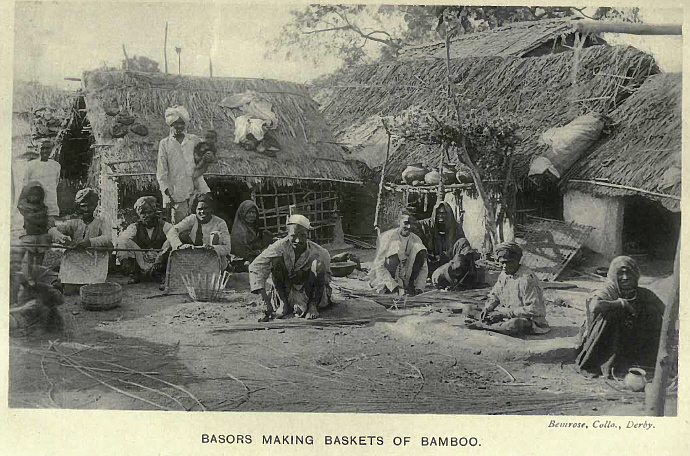
Abb.: Basors (= Bambusflechter)
[Bildquelle: Russell, R. V. (Robert Vane) <1873-1915> ; Hira Lal, Rai Bahadur <1867-1934>: The tribes and castes of the Central Provinces of India. -- London : Macmillan, 1916. -- 4 Bde. -- Bd. 2. -- Nach S. 210]
Abb.: Korbflechterin, Udaipur, Rajasthan
[Bildquelle: sarako. -- http://www.flickr.com/photos/sarako/31965815/. -- Zugriff am 2008-04-01. --Creative Commons Lizenz (Namensnennung, keine kommerzielle Nutzung)]
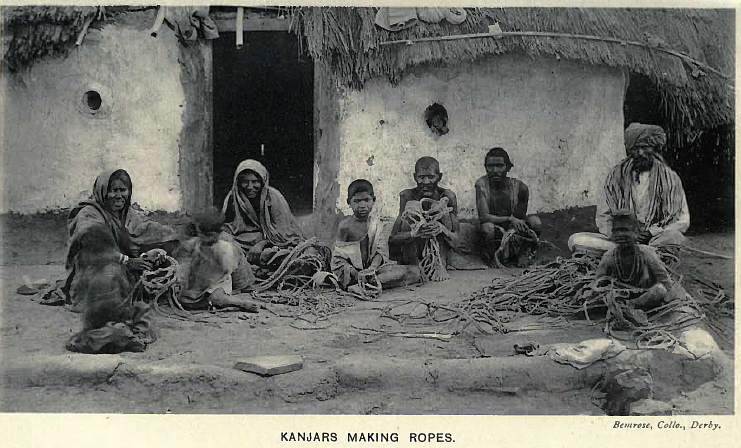
Abb.: Kanjars beim Seilen, Zentralindien, um 1916
[Bildquelle: Russell, R. V. (Robert Vane) <1873-1915> ; Hira Lal, Rai Bahadur <1867-1934>: The tribes and castes of the Central Provinces of India. -- London : Macmillan, 1916. -- 4 Bde. -- Bd. 3. -- Nach S. 332.]
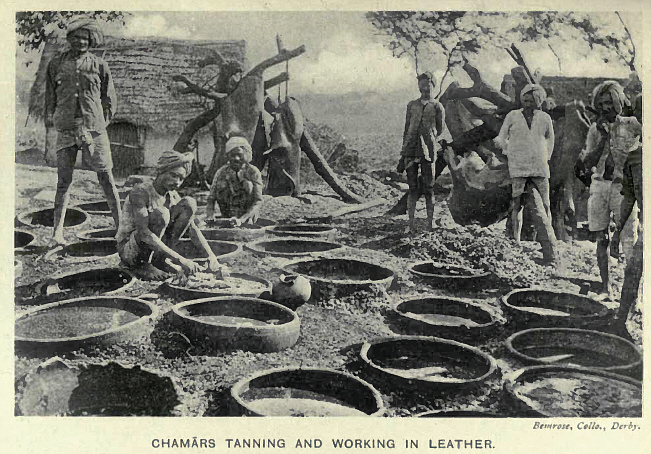
Abb.: Chamārs (Lederarbeiter) beim Gerben
[Bildquelle: Russell, R. V. (Robert Vane) <1873-1915> ; Hira Lal, Rai Bahadur <1867-1934>: The tribes and castes of the Central Provinces of India. -- London : Macmillan, 1916. -- 4 Bde. -- Bd. 2. -- Nach S. 416.]
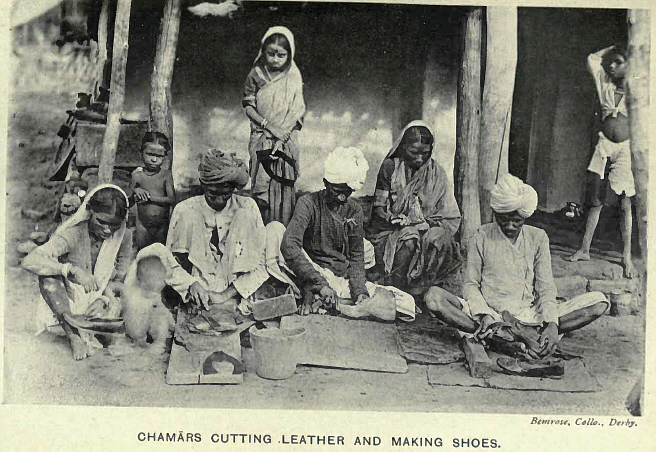
Abb.: Chamārs (Lederarbeiter) beim Schustern
[Bildquelle: Russell, R. V. (Robert Vane) <1873-1915> ; Hira Lal, Rai Bahadur <1867-1934>: The tribes and castes of the Central Provinces of India. -- London : Macmillan, 1916. -- 4 Bde. -- Bd. 2. -- Nach S. 418.]
"Miscellaneous Small Wares. [S. 313] Trinketry. In all parts of India imitation jewelry and other trinketry, already referred to under ivory carving, lac work, &c., are made. In Dacca, bracelets are also made from chank shells, imported from the Maldive and Laccadive islands. They are sawn into semicircular pieces which are joined together, and carved and inlaid with a red composition. The manufacture of shell bracelets in Sylhet gives employment to a large number of people. At Poona and other places bracelets and necklaces and chains are made of some sort of perfumed composition, and also of various seeds, as the scarlet and black seeds of the ganja or gunch (Abrus precatorius), the flat black seeds of the talapota or turwar (Cassia auriculata), the red seeds of the rukta chandan or red saunders (Adenanthera Pavonina), the mottled seed of the supari or betel-nut palm (Areca Catechu), the oval seeds of the bhirli mar (Caryota urens), and the deeply sulcated seeds of the rudraksh (Elaeocarpus Ganitrus), which are also worn as a necklace by the Saivas and Mahommedan fakirs.
The manufacture of mock ornaments for the idols is a very prosperous industry in most large Indian cities. These ornaments [S. 314] are for the most part made of paper, cut into various shapes and stuck over with bits of many-colored tinfoil, peacock's feathers, &c. Ahmedabad is specially mentioned by Mr. F. S. P. Lely in the Bombay Gazetteer, 1879, as celebrated for this manufacture. There the great occasion for the sale of these ornaments is the birthday of Krishna. The rich will sometimes spend as much as 25 l. in decking out a single image of the god with this paper trinketry, which perishes as used.
Another article much in demand on that day is enamel: and among the chief enamelled articles sold everywhere in India are eyes for the gods, made of almond-shaped pieces of silver, enamelled white with a black pupil.
Feathers. At Poona, peacock's feathers are made up with cuscus grass (Andropogon Calamus-Aromaticus), green beetle's wings, and spangles, into fragrant and very showy fans and mats.
Leather. Curious toys, figures, and artificial flowers are made by a single family of the shoemaker (muchi) caste at Nursapur in the Godavari district. They are very like those made at Condapilli in the Kistna district.
In India shoes are valued not so much for the soundness of their leather as the beauty of their ornamentation ; and formerly a great industry in gold embroidered shoes flourished at Lucknow. They were in demand all over India, for the native kings of Oudh would not allow the shoemakers to use any but pure gold wire on them. But, when we annexed the kingdom, all such restrictions were removed, and the bazaars of Oudh were at once flooded with the pinchbeck embroidered shoes of Delhi, and the Lucknow shoemakers' occupation was swept away for ever by the besom of free trade.
Bengal ladies use a toilet box made of leather, and cloth, ornamented with shells, for holding their pomades, and the kohl with which they blacken their eyelids ; and the little compressed cakes of cotton dyed with saffron and lac-dye, which they use for staining their hands and feet; and the red lead used by married [S. 315] women for painting the forehead just where the hair is parted. It generally contains also the iron bracelet which married women always carry about with them to ensure long life to their husbands.
In the Panjab, at Sirsa, Simla, Kangra, and elsewhere, huka stands, water bottles, and other articles of household use are wrought of plain leather, ornamented with strips of green leather and bright brass mountings.
Ornamented slippers, and sword sheaths are made throughout Rajputana, and slippers for the Mahommedans at Shikarpur, in the North-Western Provinces. Green slippers are worn only by Shiahs, and not by Sunnis. Chanda and Brahmapuri have a great reputation in the Central Provinces for the manufacture of native slippers. The slippers made at Molkalmuru are also noted in Mysore. In the Bombay Presidency, Poona, and Rajapur in the Ratnageri collectorate, are specially named for this industry.
In Gujarat beautifully embroidered leather mats are made. The leather shields of Ahmedabad have been mentioned under Arms.
It is indeed quite impossible to enumerate all the smaller village wares of India, although they are the most interesting of all, illustrating as they do the infinite variety in unity of the decorative art of India.
Leather work is a very ancient art in India. Bharata, during Rama's absence, places his brother's shoes on the vacant throne of Ayodhya, and daily worships them. Menu expresses great repugnance to any one stepping into another man's shoes, and forbids it.
Pith-work. Artificial flowers, models of temples, &c., are made in many parts of India of the pith of sola, or Eschynomene aspera, of which also the "sun hats" worn by Europeans in India, and called "solar" topis, by a natural corruption of the native name of the plant, are made. In Madras highly elaborate and accurate models of the great Dravidian temples of Southern India are made of this pith. [S. 316]
Bamboo work. Very artistic bamboo work is made at Monghyr, in Bengal.
Palm-branch work. Hand, and standard fans are made of the several species of palm leaves found in different parts of India. The broad and powerful fan formed of the branch of the Borassus flabelliformis, or palmyra, is often showily decorated with paint and gilding, and sometimes with embroidery."
[Quelle: Birdwood, George C. M. (George Christopher Molesworth) <1832-1917>: The industrial arts of India. -- London : Chapman and Hall. -- 20 cm. -- (South Kensington Museum art handbooks). -- Vol. 2. -- 1884. -- S. 313 - 316. -- Online: http://www.archive.org/details/industrialartsof00birduoft. -- Zugriff am 2008-03-24. -- "Not in copyright".]
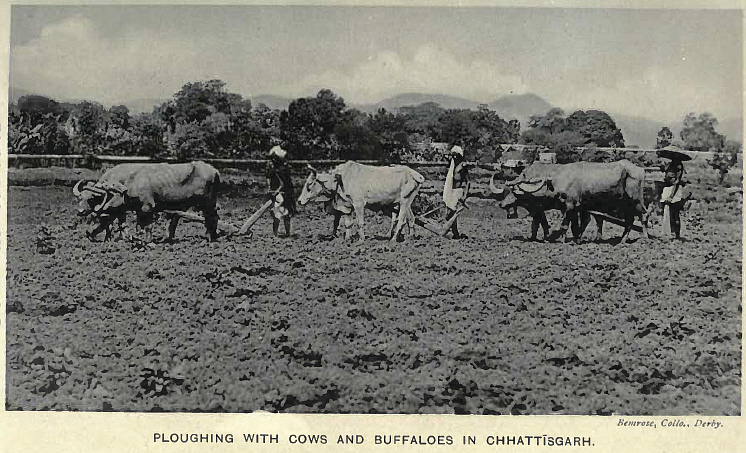
Abb.: Pflügen, Chhattīsgarh (छत्तीसगढ)
[Bildquelle: Russell, R. V. (Robert Vane) <1873-1915> ; Hira Lal, Rai Bahadur <1867-1934>: The tribes and castes of the Central Provinces of India. -- London : Macmillan, 1916. -- 4 Bde. -- Bd. 3. -- Nach S. 182.]
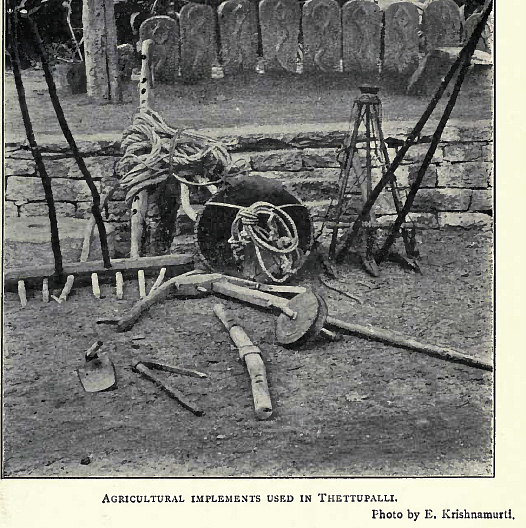
Abb.: Landwirtschaftliche Geräte, wie sie in Thettupalli, Tamil Nadu um ca. 1918
benutzt wurden (im Hintergrund "Schlangensteine")
[Bildquelle: Some south Indian villages / ed. by Gilbert Slater. . -- London [etc.] : H. Milford, Oxford University Press, 1918. -- 265 S. : Ill. ; 25 cm. -- (Economic studies ; 1). -- Nach S. 98. -- Online: http://www.openlibrary.org/details/somesouthindianv00slatiala. -- Zugriff am 2008-03-27. -- "Not in copyright"]
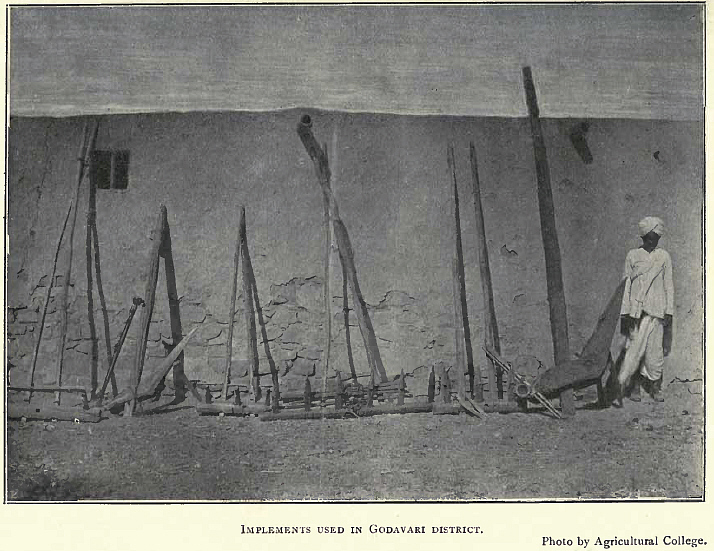
Abb.: Landwirtschaftliche Geräte, wie sie im Godavari District (గోదావర), Andhra
Pradesh um ca. 1918 benutzt wurden
[Bildquelle: Some south Indian villages / ed. by Gilbert Slater. . -- London [etc.] : H. Milford, Oxford University Press, 1918. -- 265 S. : Ill. ; 25 cm. -- (Economic studies ; 1). -- Nach S. 218. -- Online: http://www.openlibrary.org/details/somesouthindianv00slatiala. -- Zugriff am 2008-03-27. -- "Not in copyright"]
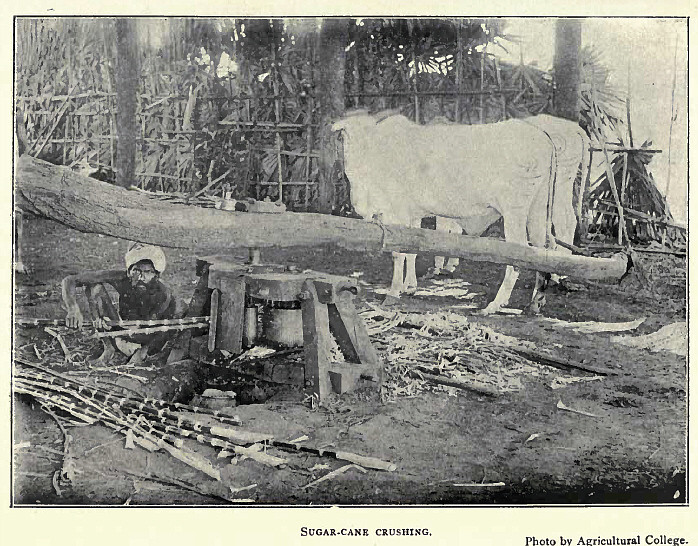
Abb.: Zuckerrohrmühle, Tamil Nadu, um 1918
[Bildquelle: Some south Indian villages / ed. by Gilbert Slater. . -- London [etc.] : H. Milford, Oxford University Press, 1918. -- 265 S. : Ill. ; 25 cm. -- (Economic studies ; 1). -- Nach S. 108. -- Online: http://www.openlibrary.org/details/somesouthindianv00slatiala. -- Zugriff am 2008-03-27. -- "Not in copyright"]
Das Folgende ist eine Darstellung der landwirtschaftlichen Geräte im Dorf Jategaon Budruk, 25 Meilen nordöstlich von Pune (पुणे), Maharashtra:
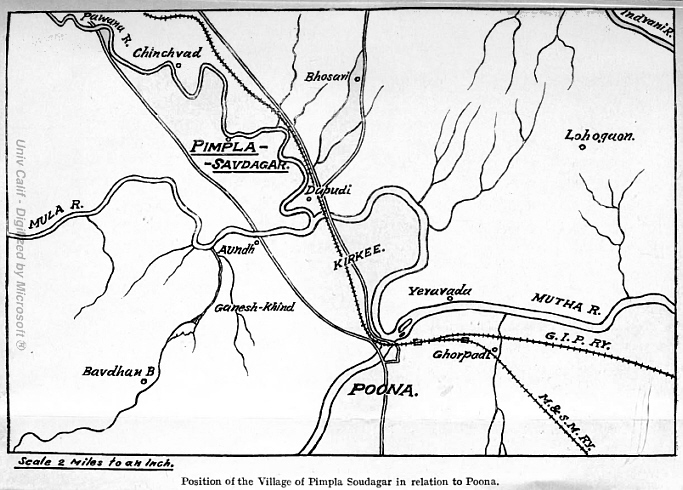
Abb.: Lage von Pimpla Soudagar
[Bildquelle: a.u.a.O., Plate II.]
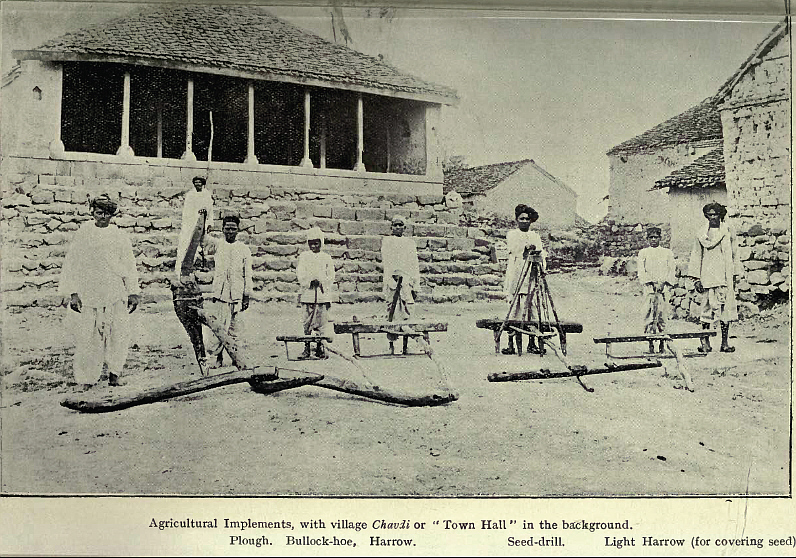
Abb.: Landwirtschaftliche Geräte, wie sie im Dorf Pimpla Soudagar, nordwestlich
von Pune (पुणे), Maharashtra um ca. 1917 benutzt wurden
[Bildquelle: a.u.a.O., Pl. IX.]
"IMPLEMENTS FOR CULTIVATION.
In a village like that which we are considering, which lies in a large measure apart from the more progressive parts of the country, owing to its being carried on almost entirely by dry cultivation, the implements in use for producing crops are of the primitive kind which were universal a few years ago, and which are only now slowly and gradually being replaced by more efficient, and, we may add, more expensive ones. The implements in use at present (1915) are shown in the following list with their costs :
Thus to get a complete set of implements as required by a good cultivator (except for the cart) will cost from Rs. 39 to Rs. 42. All can be made in the village, and two carpenters (see above) are maintained for the purpose of making and repairing them. These are paid in kind and not in cash, and for all repairs to village implements they each get (as [S. 55] baluta ) one palla (280 pounds) of grain and five hundred sheaves of jowari or bajri with the heads of corn on them. Beyond this they are paid in cash for new implements required, and for any other extra work which they do. The bigger cultivators are first attended to, and generally pay extra for the concession.
This is the system which has been universal in Deccan villages, and is maintained still in almost all places, at least at those which are off the main roads.
Practically all the implements are made of babul wood, and are of the patterns ordinarily in use for soil of this class, there is hence no need to describe them. A few notes may be made, however, about certain among them.
The heavy seed drill is a somewhat peculiar implement. It is exactly like the ordinary drill, only having a body double the size in order to sow the seed very deeply during the rabi season. At this season (September and October) it is essential to put in seed very deep, say, four to six inches, into the parts of the soil which still hold plenty of moisture. Hence the heavy seed drill, which is worked by two, and even occasionally by three pairs of bullocks.
The ordinary harrow in use here is only two and a half feet wide, but the block of which the body is made is short, thick and heavy, when compared with the light harrow or pharat. It is chiefly used to prepare the land following the plough.
The light harrow or pharat is wider than the last, being usually three and a half feet broad. This is generally used to cover the seed, following the seed drill.
The draught required for each of the implements used with bullocks is shown below:
Plough: from one to four pairs of bullocks, according to season and class of work.
Harrow: usually one to two pairs of bullocks. [S. 66]
Light harrow (pharat): one pair of bullocks.
Seed drill: usually one pair of bullocks for sowing in the kharif season, and up to three pairs of bullocks for sowing the rabi crops.
A man fitted out with such a complete set of implements and land sufficient to put them to full use would require also four pairs of bullocks in his stable. He would, however, only need these for about one hundred days in the year at the most, and as already stated, they would be available for the remainder of the year for other purposes. It is this fact which has led to the development of carting on the roads as a secondary occupation by many of the people of this and similar villages.
We have already referred to the fact that the use of the modern iron plough has made little progress in this as in most dry land villages. Only two cultivators in 1915 hired such ploughs for trial for a few days. The general opinion formed and expressed with regard to them is that they are efficient on land in fairly dry condition, and are well worth having under such conditions as they do better work with less expenditure of bullock power. When the land is wet and sticky, the people consider that there is no advantage, and that the country wooden plough answers as well, or better.
At present the whole number of the larger farm implements held in the village with 1,006 acres of cultivation and a population of 556 is as follows :
[Quelle: : Mann, Harold H. (Harold Hart) <1872 - > ; Sahasrabuddhe, Dattatraya Lakshman <1881- > ; Kanitkar, Narayan Vinayak <1887 - > ; Tamhane, Vinayak Atmaram <1884 - >: Land and labour in a Deccan village. By Harold H. Mann, in collaboration with D. L. Sahasrabuddhe, N. V. Kanitkar, V. A. Tamhane and others. -- London, Bombay : H. Milford, Oxford University Press, 1917. -- v, 184 S. : Ill. ; 23 cm. --S. 64 - 66]
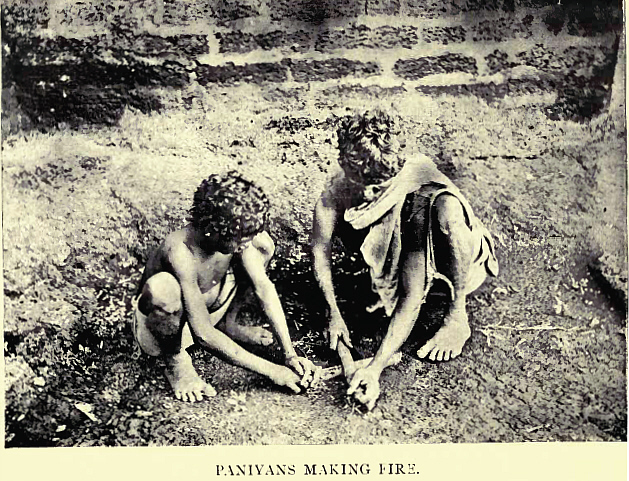
Abb.: Feuerreibe, Südindien, um 1909
[Bildquelle: Thurston, Edgar <1855 - 1935> ; Rangachari, K.: Castes and tribes of southern India. -- Madras : Govt. Press, 1909. -- 7 Bde. : ill. ; 24 cm. -- Bd. 6. -- Nach S. 70.]
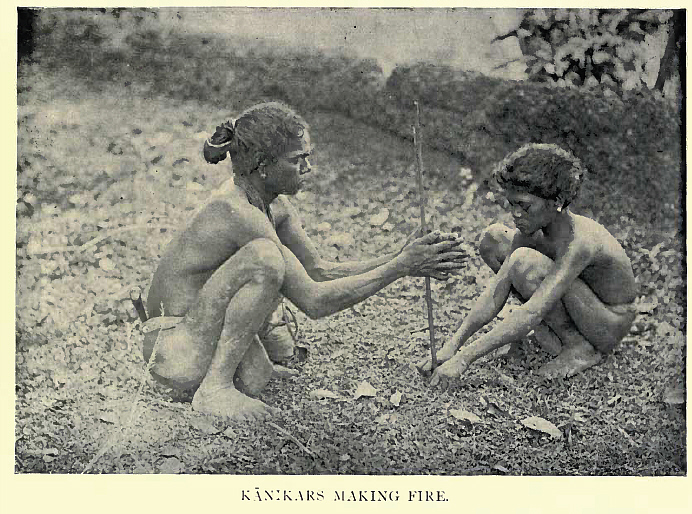
Abb.: Feuerquirl, Südindien, um 1909
[Bildquelle: Thurston, Edgar <1855 - 1935> ; Rangachari, K.: Castes and tribes of southern India. -- Madras : Govt. Press, 1909. -- 7 Bde. : ill. ; 24 cm. -- Bd. 3. -- Nach S. 168.]
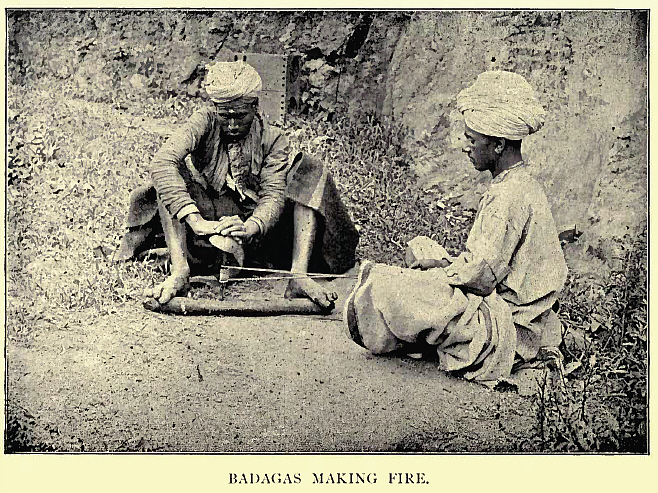
Abb.: Feuerbohrer, Nilgiri
[Bildquelle: Thurston, Edgar <1855 - 1935> ; Rangachari, K.: Castes and tribes of southern India. -- Madras : Govt. Press, 1909. -- 7 Bde. : ill. ; 24 cm. -- Bd. 1. -- Nach S. 98.]
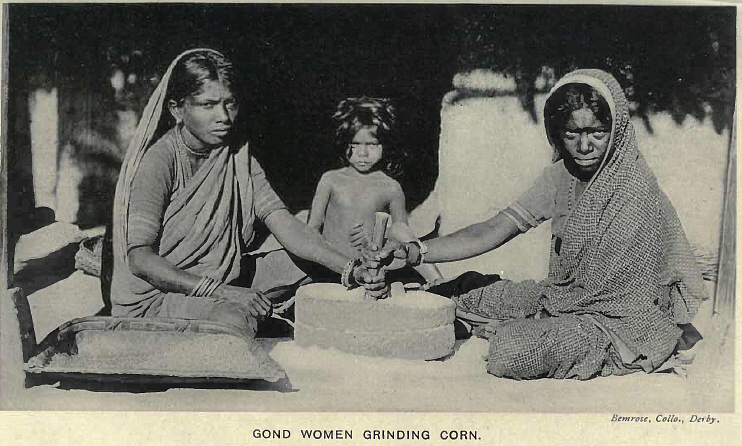
Abb.: Gond Frauen mit Mahlstein, Zentralindian, um 1916
[Bildquelle: Russell, R. V. (Robert Vane) <1873-1915> ; Hira Lal, Rai Bahadur <1867-1934>: The tribes and castes of the Central Provinces of India. -- London : Macmillan, 1916. -- 4 Bde. -- Bd. 3. -- Nach S. 42]
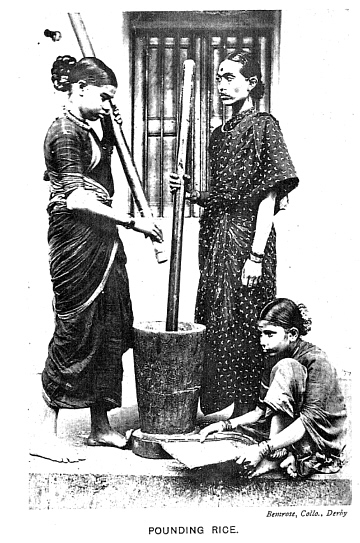
Abb.: Reismörser, Zentralindien, um 1916
[Bildquelle: Russell, R. V. (Robert Vane) <1873-1915> ; Hira Lal, Rai Bahadur <1867-1934>: The tribes and castes of the Central Provinces of India. -- London : Macmillan, 1916. -- 4 Bde. -- Bd. 4. -- Nach S. 60.]
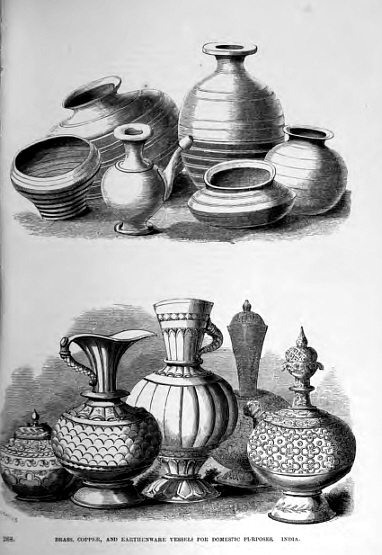
Abb.: Haushaltsgeräte aus Indien, ausgestellt bei der Great Exhibition of the
Works of Industry of all Nations, London 1851
[Bildquelle: Official descriptive and illustrated catalogue of the Great exhibition of the works of industry of all nations, 1851 ... -- London : Spicer, 1851. -- Vol IV: Colonies - foreign states. Division I.]
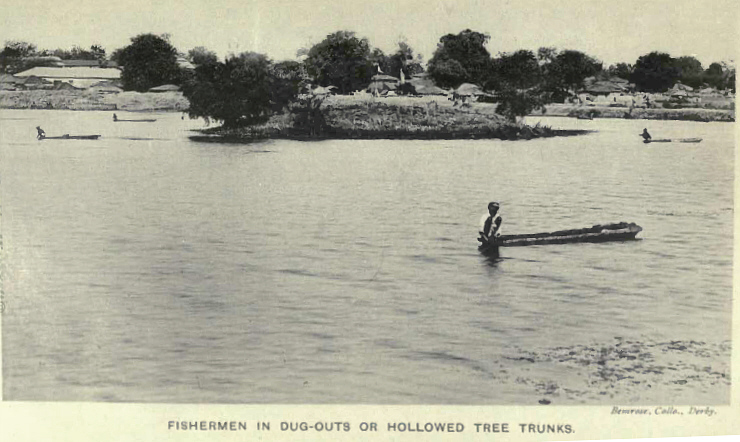
Abb.: Einbaum von Fischern
[Bildquelle: Russell, R. V. (Robert Vane) <1873-1915> ; Hira Lal, Rai Bahadur <1867-1934>: The tribes and castes of the Central Provinces of India. -- London : Macmillan, 1916. -- 4 Bde. -- Bd. 2. -- Nach S. 306.]
Abb.: Ölpresse, Zentralindien, um 1916[Bildquelle: Russell, R. V. (Robert Vane) <1873-1915> ; Hira Lal, Rai Bahadur <1867-1934>: The tribes and castes of the Central Provinces of India. -- London : Macmillan, 1916. -- 4 Bde. -- Bd. 4. -- Nach S. 544.]
Abb.: Zuckerrohrmühle, Zentralindien, um 1916[Bildquelle: Russell, R. V. (Robert Vane) <1873-1915> ; Hira Lal, Rai Bahadur <1867-1934>: The tribes and castes of the Central Provinces of India. -- London : Macmillan, 1916. -- 4 Bde. -- Bd. 3. -- Nach S. 494.]
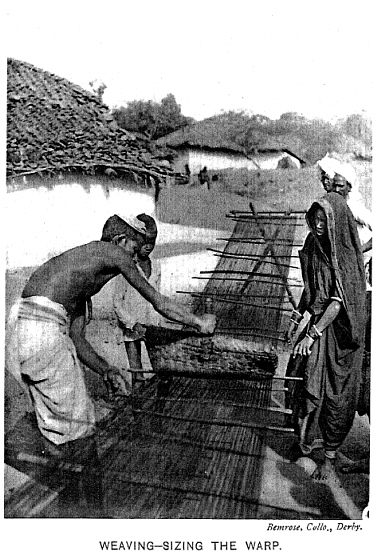
Abb.: Webstuhl, Zentralindien, um 1916
[Bildquelle: Russell, R. V. (Robert Vane) <1873-1915> ; Hira Lal, Rai Bahadur <1867-1934>: The tribes and castes of the Central Provinces of India. -- London : Macmillan, 1916. -- 4 Bde. -- Bd. 4. -- Nach S. 142.]
Abb.: Tanzkostüme, Kerala, um 1909[Bildquelle: Thurston, Edgar <1855 - 1935> ; Rangachari, K.: Castes and tribes of southern India. -- Madras : Govt. Press, 1909. -- 7 Bde. : ill. ; 24 cm. -- Bd. 4. -- Nach S. 440.]
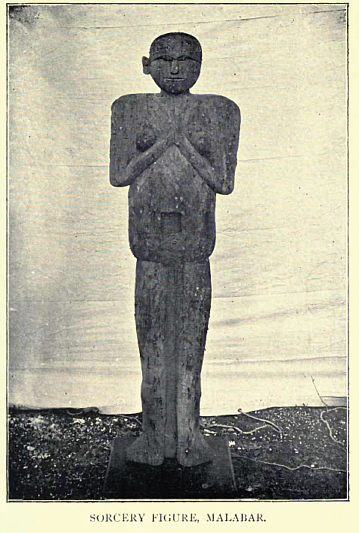
Abb.: Figur für Hexerei, Kerala, um 1909
[Bildquelle: Thurston, Edgar <1855 - 1935> ; Rangachari, K.: Castes and tribes of southern India. -- Madras : Govt. Press, 1909. -- 7 Bde. : ill. ; 24 cm. -- Bd. 4. -- Nach S. 488.]
Abb.: Bhūta-Darstellung, Karnataka, um 1909[Bildquelle: Thurston, Edgar <1855 - 1935> ; Rangachari, K.: Castes and tribes of southern India. -- Madras : Govt. Press, 1909. -- 7 Bde. : ill. ; 24 cm. -- Bd. 5. -- Nach S. 146.]
Abb.: Götterfiguren der Vāda (eine Fischerkaste), Andhra Pradesh, um 1909[Bildquelle: Thurston, Edgar <1855 - 1935> ; Rangachari, K.: Castes and tribes of southern India. -- Madras : Govt. Press, 1909. -- 7 Bde. : ill. ; 24 cm. -- Bd. 7. -- Nach S. 258.]
Abb.: Topf-Schreine der Vāda (eine Fischerkaste), Andhra Pradesh, um 1909[Bildquelle: Thurston, Edgar <1855 - 1935> ; Rangachari, K.: Castes and tribes of southern India. -- Madras : Govt. Press, 1909. -- 7 Bde. : ill. ; 24 cm. -- Bd. 7. -- Nach S. 260.]
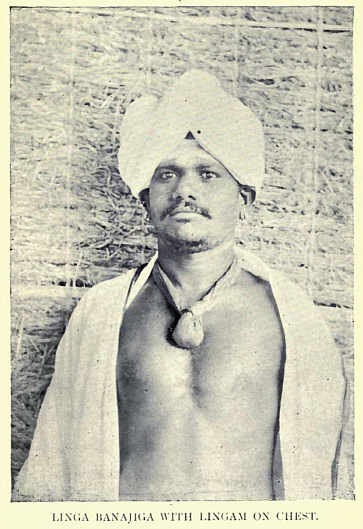
Abb.: Lingam-Amulett, Südindien, um 1909
[Bildquelle: Thurston, Edgar <1855 - 1935> ; Rangachari, K.: Castes and tribes of southern India. -- Madras : Govt. Press, 1909. -- 7 Bde. : ill. ; 24 cm. -- Bd. 4. -- Nach S. 242.]
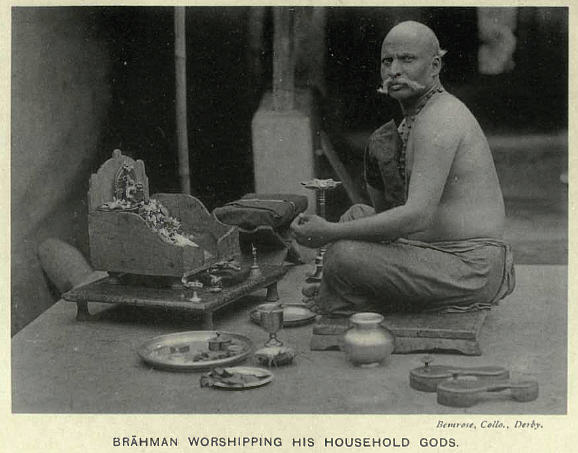
Abb.: Brahmane bei der Verehrung seiner Hausgötter
[Bildquelle: Russell, R. V. (Robert Vane) <1873-1915> ; Hira Lal, Rai Bahadur <1867-1934>: The tribes and castes of the Central Provinces of India. -- London : Macmillan, 1916. -- 4 Bde. -- Bd. 2. -- Nach S. 380.]
Abb.: Smarta-Brahmane mit Utensilien zum śivaitischen Gottesdienst, Südindien, um 1909[Bildquelle: Thurston, Edgar <1855 - 1935> ; Rangachari, K.: Castes and tribes of southern India. -- Madras : Govt. Press, 1909. -- 7 Bde. : ill. ; 24 cm. -- Bd. 1. -- Nach S. 322.]
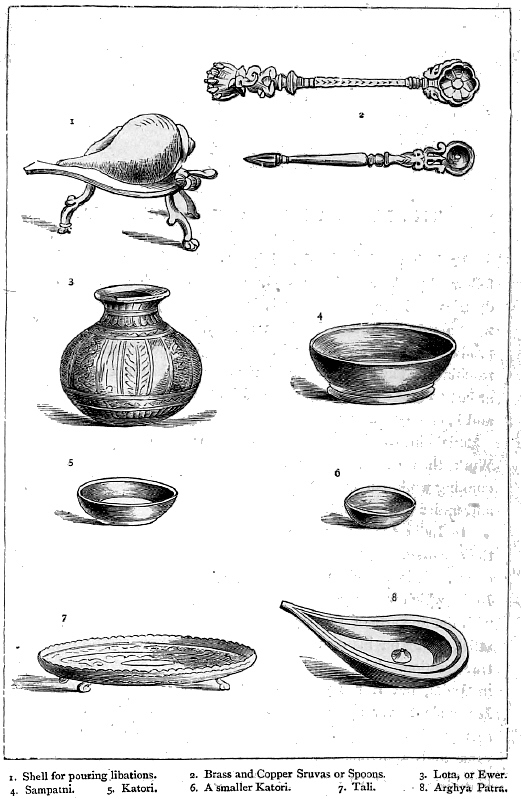
Abb.: Kultgegenstände
[Bildquelle: Birdwood, George C. M. (George Christopher Molesworth) <1832-1917>: The industrial arts of India. -- London : Chapman and Hall. -- (South Kensington Museum art handbooks). -- Vol. 1. -- 1884. -- Plate O.]
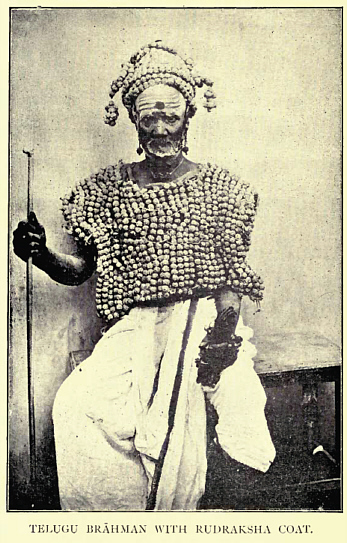
Abb.: Telugu Brahmane mit Leibchen und Mütze aus heiligen Rudrākṣa-Beeren, um
1909
[Bildquelle: Thurston, Edgar <1855 - 1935> ; Rangachari, K.: Castes and tribes of southern India. -- Madras : Govt. Press, 1909. -- 7 Bde. : ill. ; 24 cm. -- Bd. 1. -- Nach S. 318.]
Abb.: Jangam (Lingāyat-Priester), Südindien, um 1909[Bildquelle: Thurston, Edgar <1855 - 1935> ; Rangachari, K.: Castes and tribes of southern India. -- Madras : Govt. Press, 1909. -- 7 Bde. : ill. ; 24 cm. -- Bd. 4. -- Nach S. 256.]
Abb.: Syrisch-christlicher Bischof, Kerala, um 1909[Bildquelle: Thurston, Edgar <1855 - 1935> ; Rangachari, K.: Castes and tribes of southern India. -- Madras : Govt. Press, 1909. -- 7 Bde. : ill. ; 24 cm. -- Bd. 6. -- Nach S. 438.]
"IDOLS. The idols of the Hindus are made of gold, silver, and copper, or their alloys, one alloy of frequent use being that called panchalaka, of gold, silver, copper, tin, and lead; but iron, brass, crystal, stone, earth, cow-dung, and wood are also often employed, the red sanders wood and the woods of the Cupressus torulosa, Macrotomia euchroma, and Melia azedarach. Many of the idols in India are monsters, many are mere shapeless masses of stone with a smearing of red lead, or a log of wood without shape or form, or a stone from the river-bed; others, like the bull Nandi or Basava, the vahan of Siva, are beautifully formed models of that quadruped. The forms of Siva and of his wife Parvati and of the cobra serpent are usually well portrayed, as also of the peacock in the Saiva temples. The horse is formed of wood, plated with silver and gilded ; occasionally well-made figures of the elephant are to be seen.
The images made of gold are generally those of Durga, Lakshmi, Radha, Krishna, and Saraswati ; they are kept in private houses, and worshipped daily, and weigh from one to four tolas.
The image of Sheetula, of 10 or 12 tolas, is often made of silver, kept in the house, and worshipped daily. Ward mentions that at Kidderpur, adjoining to Calcutta, was a golden image of Puti-tupavuni, 2 cubits high. Near Sarampur was a golden image of Jagadhatri, about 1½ cubits high. Very small copper images of Surya, and of Siva riding on a bull, are preserved in private houses, and worshipped daily.
The images of all the gods and goddesses may be made of stone, generally of a black, but some of a white colour ; the greater number are placed in temples ; a few small ones are found in private houses. All images of stone are worshipped daily ; the greater number are of the lingam, or the various forms of Vishnu. A few exist of the lingam, nine or twelve cubits high. Throughout Lower Bengal and all the south of India, every village has its guardian idol, generally one or more rough stones smeared with red lead, and placed under an aged banyan or pipal tree. In one single street of Calcutta there are more images of Krishna and emblems of Siva than perhaps in the whole length of the Doab. A lingam at Benares requires six men to encircle it. The clay and composition images made in the vicinity of Calcutta for the annual festivals (some of which have a very splendid appearance, and are of large dimensions), after the ceremonies are over are cast into the river. The modern manufacturers of the deities are artisans in gold, silver, and other metals, stone-cutters, and potters. Some of the modern casts are handsome, but the modern sculptures are commonly contemptible. Some of the ancient Hindu sculptures are magnificent, and in minute ornamental and floral decorations almost unrivalled. [S. 143]
In Burma the images of Gaudama are made of wood, marble, and the precious metals. In Siam, Japan, etc., images are made of the ornaments, precious metals, etc., collected from the ashes of the funeral pile of a deceased person ; and others again from the pulverized fragments of the bones kneaded with water into a paste, baked, and afterwards gilded.
Images of snakes are common. The idea of their curative virtues is very old in India : a Hindu attacked by fever or other diseases, makes a serpent of brass or clay, and performs certain ceremonies to its honour, in furtherance of his recovery. Such ceremonies are particularly efficacious when the moon is in the Nakshatra (mansion, sign, or asterism) called Sarpa or the serpent, called also Ashlesha. Dhanwantari is the Esculapius of the Hindus, but has not an attendant serpent like his brother of Greece ; the health-bestowing Dhanwantari arose from the sea when churned for the beverage of immortality. He is generally represented as a venerable man with a book in his hand.
Every Hindu house has at least a picture ; many have idols ; and every man of the Vira Saiva or Jangam sect, of whom there are many millions in India, always wears the lingam in a silver or gold casket, suspended from his neck or tied round his arm. The lingam inside is a small stone cylinder embedded in the yoni. The ordinary lingam, of which there are millions in India, is a stone cylinder rising from the yoni, a stone platform marked with circular markings ; usually in front of it is a figure of the bull Nandi in stone. Ganapati or Ganesa, with the head of an elephant and the body of a fat man, is an idol frequently to be seen. As the god of wisdom, he is worshipped at the beginning of every undertaking by almost all Hindus. When a Hindu boy or girl begins to read, they make a Ganesa in the form of a small cone of cow-dung, which they place on a purified spot, and ornament it with flowers and naragam and red kanganu, and offer a sacrifice by burning camphor and frankincense, also offering betel-nuts and plantains, cocoanuts and jagari, then bow reverentially and pray for the god's aid. The pyramidal figure is then kept for a time or thrown into the water. Any person may see them.
In a Hindu temple, the idol is kept in the centre of the temple, called Sanadi. Daily the Brahman servants anoint it with oil, cleanse it with sikaia, wash it with water, then with curds, milk, lime-juice and honey, and cocoanut water. Before it the dancing girls of the temple, the devadasa, dance and sing to music morning and evening. On certain festivals, the idol is taken from the temple in a palanquin or on a car, and made to perambulate the squares and the streets.
Idols are frequently objects of litigation, and sacrifices of human beings are occasionally made to them. In a village called Kishnagur, some 30 miles from Bikanir, there lived one Maya Ram, a Jat by birth, in whose house was an image of stone, which Maya Ram and his family used to worship. It was a tradition in the village that the idol had been kept formerly in several other houses, one after the other, but that all who worshipped it had come to a violent end ; and Maya Ram one day was seen behaving very strangely before the idol, dancing frantically, says the report. He then forbade the other villagers to enter the house. He seemed under the influence of some religious homicidal mania, attacking his kinsmen, and threatening to kill them unless they conformed to his worship of the stone image. He killed the child of his elder brother. Suddenly the contagion of madness seemed to seize the whole family : Maya Ram, with two male kinsmen and seven women, threw themselves into a well all together, and shouting 'Swarga chalo !' Come to heaven ! the whole ten were drowned.
The Jain idols are usually naked figures of men and women, of gigantic proportions, often erect, but in every attitude. The Buddhist idol is usually Buddha or Gaudama, reclining, or sitting in the attitude of preaching. Some of the figures of Gaudama at the great Shooay dagon temple at Rangoon are of vast dimensions. Moor; Ward's Hindus; Tr. of a Hind. ; Coleman."
[Quelle: Balfour, Edward <1813-1889>: Cyclopædia of India and of eastern and southern Asia, commercial, industrial and scientific: products of the mineral, vegetable and animal kingdoms, useful arts and manufactures / ed. by Edward Balfour. -- 3rd ed. -- London: Quaritch. -- Vol. 2. -- 1885. -- S. 143f.]
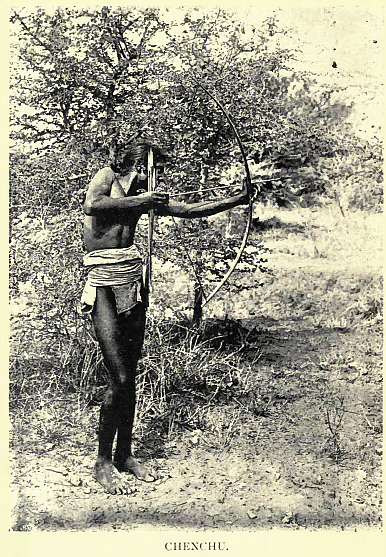
Abb.: Chenchu mit Pfeil und Bogen, Andhra Pradesh, um 1909
[Bildquelle: Thurston, Edgar <1855 - 1935> ; Rangachari, K.: Castes and tribes of southern India. -- Madras : Govt. Press, 1909. -- 7 Bde. : ill. ; 24 cm. -- Bd. 2. -- Nach S. 36.]
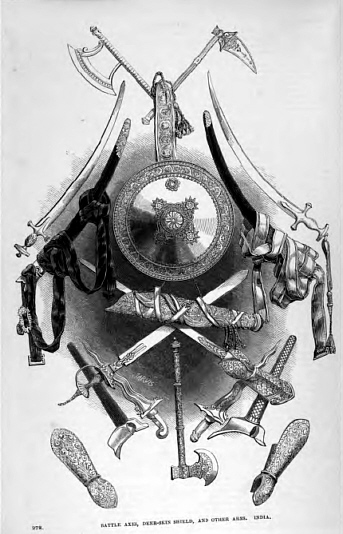
Abb.: Waffen aus Indien, ausgestellt bei der Great Exhibition of the Works of
Industry of all Nations, London 1851
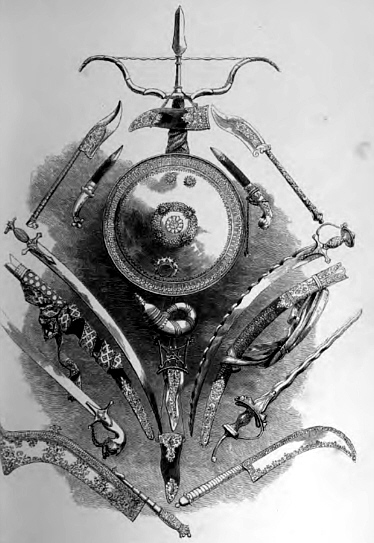
Abb.: Waffen aus Indien, ausgestellt bei der Great Exhibition of the Works of
Industry of all Nations, London 1851
Abb.: valai tadi = Bumerangs (Wurfwaffe) (Holz, bzw. Elfenbein), Thanjavur (தஞ்சாவூர்), Tamil Nadu[Bildquelle: Thurston, Edgar <1855 - 1935> ; Rangachari, K.: Castes and tribes of southern India. -- Madras : Govt. Press, 1909. -- 7 Bde. : ill. ; 24 cm. -- Bd. 1. -- Nach S. xxviii.]
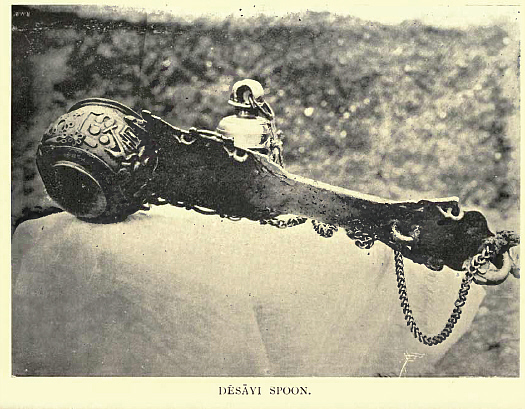
Abb.: Löffel eines Deśāyi (Distriktobmanns), Südindien, um 1909
[Bildquelle: Thurston, Edgar <1855 - 1935> ; Rangachari, K.: Castes and tribes of southern India. -- Madras : Govt. Press, 1909. -- 7 Bde. : ill. ; 24 cm. -- Bd. 2. -- Nach S. 122.]
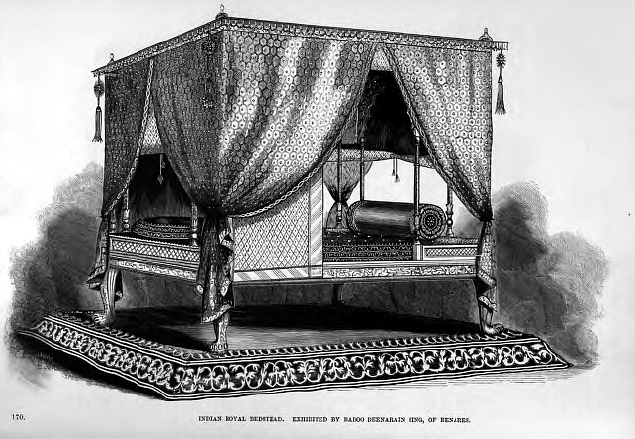
Abb.: Königliches Bett aus Indien, ausgestellt bei der Great Exhibition of the
Works of Industry of all Nations, London 1851
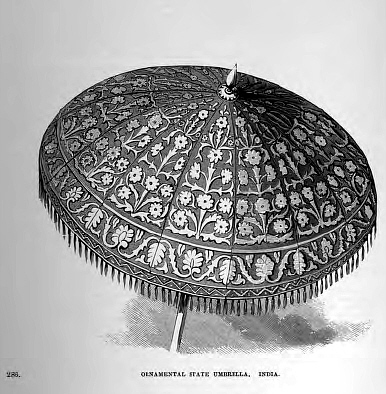
Abb.: Staatsschirm aus Indien, ausgestellt bei der Great Exhibition of the Works
of Industry of all Nations, London 1851
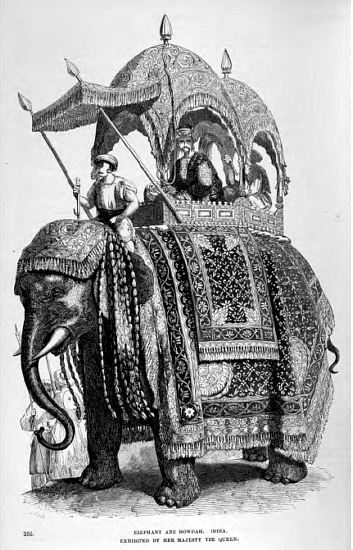
Abb.: Elefant mit Howdah aus Indien, ausgestellt bei der Great Exhibition of the
Works of Industry of all Nations, London 1851
[Quelle der 5 Abb.:: Official descriptive and illustrated catalogue of the Great exhibition of the works of industry of all nations, 1851 ... -- London : Spicer, 1851. -- Vol IV: Colonies - foreign states. Division I.]
George C. M. Birdwood gibt eine gute Einführung in indische Waffen (und die Denkweise britischer Kolonialherren):
"ARMS. [S. 225] IN the Rig-Veda frequent allusion is made to the use of the bow, the mastery of which was considered so important that a supplementary Veda, the Dhanur Veda, is devoted to it. In the Ramayana, Rama wins Sita for his bride by bending the great bow of Siva; and in the Mahabharata the choice of Draupadi fell on Arjuna for his skill in archery. In the legendary life of Gautama Buddha we are also told that when his father sought out a wife for him among the daughters of the neighbouring rajas, they all refused, because, though handsome, he had not been taught any martial accomplishments. Nevertheless the young Prince Siddhartha proved his prowess against all comers at the tournament proclaimed by the Raja Suprabuddha, for his daughter's hand, and so gained the radiant Yasodhara for his wife. The Agni Purana gives a most elaborate classification of arms ; and they are represented in every variety of form on the most ancient monuments of India. Indian steel has been celebrated from the earliest antiquity, and the blades of Damascus, which maintained their pre-eminence even after the blades of Toledo became celebrated, were in fact of Indian steel. Ctesias mentions two wonderful Indian blades which were presented to him by the King of Persia and his mother. The Ondanique of Marco Polo's travels refers originally, as Colonel Yule has shewn, to Indian steel, the word being a corruption of the Persian Hundwaniy, i.e., Indian steel. The [S. 226] same word found its way into Spanish, in the shapes of Alhinde and Alfinde, first with the meaning of steel, and then of a steel mirror, and finally of the metal foil of a glass mirror. The Ondanique of Kirman, which Marco Polo mentions, was so called from its comparative excellence, and the swords of Kirman were eagerly sought after, in the fifteenth and sixteenth centuries, by the Turks, who gave great prices for them. We have seen that Arrian mentions Indian steel, σιδηρος ινδικος, as imported into the Abyssinian ports ; and Salmasius mentions that among the surviving Greek treatises was one περι βαφης ινδικου σιδηρου "on the tempering of Indian steel."
Twenty miles east of Nirmal, and a few miles south of the Shisha hills, occurs the hornblende slate or schist from which the magnetic iron used for ages in the manufacture of Damascus steel, and by the Persians for their sword blades, is still obtained. The Dimdurti mines on the Godavari were also another source of Damascus steel, the mines here being mere holes dug through the thin granitic soil, from which the ore is detached by means of small iron crowbars. The iron ore is still further separated from its granitic or quartzy matrix by washing ; and the sand thus obtained is still manufactured into Damascus steel at Kona Samundram, near Dimdurti. The sand is melted with charcoal, without any flux, and is obtained at once in a perfectly tough and malleable state, superior to any English iron, or even the best Swedish. The Persian [Armenian] merchants, who in Voysey's days still frequented the iron furnaces of Kona Samundram, informed him that they had in vain attempted to imitate, in Persia, the steel formed from it. In the manufacture of the best steel three-fourths of Samundram ore is used, and one-fourth of Indore, which is a peroxide of iron.
In the Panjab. superbly ornamented arms, of the costliest description, are made at Lahore, Sialkote, Gujrat, Shahpur, and in Cashmere. Good arms are also made at Monghyr, in the Bhagalpur division of Bengal. In Chittagong the dao or bill, [S. 227] manufactured by the Mugs, has a long blade, widening towards the top, which is square, and fitted straight in the handle. The kukri of the Ghurkas of Nipal, which has a short handle and an incurved blade, widening in the middle and drawing to a point at the end, is well known. Swords of good temper are still made at Pehani, in the Hardoi district of Oudh.
Excellent steel is fused for gun-barrels and sword-blades along the banks of the Nerbudda, at Panagar, Katangi, Jabera, Barela, and Tenderkhera in the Central Provinces ; at Dewqlghat in the Berars ; and in Mysore. The knives and hatchets made by the Ghasias along the Upper Godavari have been already mentioned.
Nagpur, the capital of the Central Provinces, is noted for the manufacture of steel weapons, such as spears and daggers, with the steel brought from the valleys of the Nerbudda and Tapti. In the Madras Presidency arms and cutlery are produced at Tumkur for sale all over Mysore. There are 120 forges at Tumkur. Good swords, and spears, and daggers are also made at Kudwur and Vizianagram ; the superbly-mounted arms of the latter place being used chiefly in pageantry. In Kurg a handsomely mounted sword, of a peculiar shape, is made, called adya-kathi.
Handsomely-painted leather shields are made at Ahmedabad and in other parts of Gujarat in the Bombay Presidency, and also in Rajputana ; and the Katch silversmiths are famous all over India for their decoration of arms of all sorts in repoussé gold and silver.
For variety, extent, and gorgeousness, and ethnological and artistic value, no such collection of Indian arms exists in this country as that belonging to the Prince of Wales. It represents the armourer's art in every province of India, from the rude spear of the savage Nicobar islanders to the costly damascened, sculptured, and jewelled swords and shields, spears, daggers and matchlocks of Cashmere, Katch, and Vizianagram. The most striking object in the collection is a suit of armour made [S. 228] entirely of the horny scales of the Indian armadillo, or pangolin, (Manis pentadadyla), encrusted with gold, and turquoises, and garnets. There is another splendid suit of Cashmere chain armour, fine almost as lace work. The style is essentially Persian and Circassian, and is identical with that of the armour worn in Europe in the thirteenth century. The damascened casque is surmounted with a plume of pearls. There are many other suits of armour, with damascened breastplates, gauntlets, and greaves, which carry one back to the crusades and legendary history of modern Persia. Some of the sword blades are marvellously watered, several are sculptured in half relief with hunting scenes, and others are strangely shaped, teethed like a saw, and flaming (flamboyant) ; although for mingled cruelty and grotesqueness of appearance none equal the battle-axes of the Sowrahs and Khonds. There is the kukri of the Ghurkas, the adyakathi of the Moplas, the tiga of the wild tribes of Central India, and the knife used in the Meriah sacrifice. The collection also contains the great sword of Mahmud Chand Sultan Shah of the date of 1707, and the sword (No. 1,439) of the famous Polygar Katabomma Naik, who defeated the English early in the present century ; and, most interesting of all, the sword (No. 74) of Sivaji, the founder of the Maratha dominion in India.
[...]
[S. 229]
[...]
Sivaji (nicknamed by Aurungzebe " a mountain rat "), at the age of nineteen, seized Tornia, and with the spoils built Raighur, where he was subsequently enthroned, and where he died. After building Raighur, he took Singar and Purandar, and it was from the Konkan hill fort of Pertabghar, opposite Mahabaleshwur, that he issued, after receiving his mother's blessing and offering his vows to Bhavani, to circumvent, by an act of the most detestable treachery, the assassination of the Bijapur General, Afzul Khan. He enticed his generous and too confiding enemy into asecret [S. 230] turning in the road leading down the hill side, and there, in pretending to embrace him, ripped his bowels open with the wagnak ("tiger claw") concealed in his left hand, and stabbed him to the heart with the bichwa ("scorpion" dagger) hid up his right sleeve.
He is the great national hero of the Maratha Hindus, and his descendants are held in the highest reverence throughout the Dakhan. Every relic of his, his sword, daggers, and seal, and the wagnak or "tiger-claw" with which he foully assassinated Afzul Khan, have all been religiously preserved at Sattara and Kolhapur ever since his death in 1680. Mr. Grant Duff, in his Notes of an Indian Journey, has described the worship of his famous sword, Bhavani, at Sattara. The sword in the Prince's collection is not this deified weapon, but the one that has always been kept, since Sivaji's death in 1680, at Kolhapur. The political value of the gift is simply incalculable. It was a family and national heirloom, which nothing but a sentiment of the profoundest loyalty could have moved the descendants of Sivaji to give up, and which has been sacredly guarded for the last 200 years at Kolhapur, as the palladium of their house and race, by the junior branch of the Bhonsla family.
Only less significant are the other gifts of the great sword of Sultan Chand, and the sword of Katabomm Naik. All these historical weapons, the symbols of the latent, hopes and aspirations of nations and once sovereign families, were literally forced on the Prince's acceptance in a spontaneous transport of loyalty, and their surrender may be fairly interpreted to mean that the people and princes of India are beginning to give up their vain regrets for the past, and, sensible of the present blessings of a civilised rule, desire to centre their hopes of the future in the good faith, and wisdom, and power of the British Government.
Plate 40.The barrel of one of the Prince's matchlocks (Plate 40), damascened in gold, with a sort of poppy pattern, one flower nodding above another along the whole length of the barrel, is the noblest example of damascening in the whole collection.
Plate 41.[S. 231] There is another matchlock (Plate 41), the stock of which is carved in ivory, against a chocolate- stained background, with scenes of wild animal life, in which every group is a perfect cameo. The richer arms are resplendent with gold and enamelling, and gems, and are generally of uncontaminated Indian design. There is, indeed; but little room for the obtrusion of European design in Oriental arms.
There are, however, several swords and daggers in the Prince's magnificent collection of arms, which have been mounted in native design by English workmen, and the result is not less mischievous than when European designs are literally imitated by unsophisticated native handicraftsmen. The mechanical character of European manufactures requires a consistent general finish which is quite out of place in the bold and freehand compositions of the best native art work, in which finish is strictly subordinated to practical use and artistic effect ; and, if a taste for mechanical perfection becomes prevalent with the spread of middle class English ideas among the princes and chiefs of India, Indian wrought arms and jewelry will soon become arts of the past. The splendour of Indian arms and jewelry is due to the lavish use of diamonds, rubies, emeralds, and other bright and colored stones. But, as their work is really manual, and grows up spontaneously, like a growing flower, under their hands, the native jewellers are able to use the most worthless gems on it, mere chips and scales of diamonds, often so thin that they will float on water, and flawed rubies and emeralds, which have no value as precious stones, but only as barbaric blobs of colour. The European jeweller can use with his machine-made work only the most costly gems, polished to the highest lustre, far too costly to be used except for their own effect and intrinsic value only, and it would be impossible to employ them merely to enhance the general decorative effect, as in India. There are examples in the Prince's collection of elaborate gold work in purely native design, but by English workmen ; and the mechanical precision of their work has forced [S. 232] them to use rose diamonds and brilliants in the ornamentation, but necessarily so scantily that all effect of splendour is lost. Where in other examples worthless Indian stones have been set in machine-made English gold work, the effect is flat and mean beyond belief. If, therefore, Indian jewelry should become mechanical, and hard, and glittery in character, it will at once cease to be artistic, and sink to the level of the extravagantly priced vulgar trinketry of Birmingham, Paris, and Vienna.
The battle-axes used by the wild tribes are identical in form with those found among the prehistoric remains of man in Europe, perhaps because they have all been instinctively modelled from the teeth of carnivorous animals. It is impossible also to overlook the strong resemblance of the forms of Persian and Arabian arms, and of Indian arms shewing Persian and Arabian influence, to those represented on the sculptures of Assyria and Babylonia, and in the hieroglyphic painting of Egypt, as figured in Rawlinson's Ancient Monarchies and Wilkinson's Ancient Egyptians. This is especially marked in the typical fiddle-shaped handles of the daggers. The Arabian arms are distinguished by their fine filigrain work and the absence of gems, the Persian by their superb damascening, enamelling, and carving, and the rare employment of gems in their decoration, only turquoises and pearls being generally used, except in the incrustation of jade mountings ; while the Indian arms are characterised by the high relief of their elaborately hammered and cut gold work, and the unsparing use of the precious gems with which they are all over embellished. It is the special defect of Indian, particularly of Brahmanical art, to run into this excess and satiety of decorative details. It is the exclusive prerogative of Greek art to produce beauty without the use of ornament.
The interest of the India Museum also culminates in its collection of arms, which have been arranged with the most imposing effect, according to the plan adopted by the Hon. Wilbraham Egerton, M.P., in the Handbook of Indian Arms which [S. 233] he has prepared for the India Office, and which will be ready for sale at the India Museum on its reopening. It is in fact a classified and descriptive catalogue of the arms exhibited at the old India Museum, and is the only completed catalogue of any section of the Museum that has yet been made ; and it will always remain a work of permanent reference on Indian armoury. Mr. Egerton first gives a sketch of the military history of India from the earliest times, adding figures of the arms of ancient India represented on the Buddhist sculptures of Sanchi (B.C. 250), and Udyagiri, and references to those portrayed in the Buddhist paintings at Ajanta (about A.D. 400) ; and on the later Hindu temple of Bhurvaneswar (A.D. 650) ; in the Jaina sculptures at Saitron in Rajputana (A.D. 1100) ; on the sun temple at Kanarak (A.D. 1237) ; and in the sculptures of the fifteenth century in the neighbourhood of Mandore, the former capital of Marwar. After this follows a most interesting and valuable chapter on the decoration, and processes of manufacture of Indian arms, which really exhausts the subject. Mr. Egerton considers that Aryan art predominates over Turanian in Indian arms, and he divides the former into Hindi or Indian, and Iranic or Persian, and the latter into Dravidian, Tibetan, and Indo-Chinese. There is an obvious difference in the forms and details of decoration prevailing in the Panjab, Rajputana, and Hindustan generally, and of those which prevail in the Dakhan, and again along the Eastern Himalayas ; but the distinguishing expression of an ethnic or national art is given to it not by its forms but by its animating spirit ; and whatever may be the local shapes it takes there prevails all through India proper a distinctive art, which we recognise to be in its essence unvarying and indivisible, and which we may call Indian. A Mahommedan mosque in India, although its form may be Saracenic, is generally as essentially Hindu in expression as a temple of Siva or Vishnu. On the other hand, there is a deep and impassable gulf fixed between Indian art and the as strongly specialised art of Further India.
[S. 234] In classifying the India Museum arms Mr. Egerton has divided them in a thoroughly practical manner into twelve groups, which are partly ethnical, partly geographical, and partly economical.
GROUP 1 is of the arms of the aboriginal and non-Aryan tribes of Central India, and the Andaman Islands.
GROUPS 2 and 3, of the aboriginal and Dravidian races of Southern India.
GROUP 4, of the hill tribes of Assam and the North East frontier.
GROUP 5, of British and native Burma and Assam.
GROUP 6, of the Malayan Peninsula, and Indian Archipelago.
GROUP 7, of Nipal.
GROUP 8, of the Rajputs.
GROUP 9, of the Marathas ; and of the Mahommedans of Mysore and the Dakhan.
GROUP 10, of Sindh and the Panjab.
GROUP 11, of the Afghans and Persians; and also of the Abyssinians, &c.
GROUP 12, of arms used for athletic and sacrificial purposes.
It is in this order that the arms have been arranged in the India Museum, and nothing could be simpler or more effective for the purpose of instruction, or more suitable for their artistic display. In his preface Mr. Egerton expresses a regret, in which everyone will concur, that the collection of Indian arms at the Tower has not been united to the India Museum collection : and that the Government of Madras should have recently allowed the old historical weapons from the armouries of Tanjore and Madras to be broken up and sold for old metal. This act of vandalism is all the more to be deplored, as neither the Tower nor the India Museum collections are, as Mr. Egerton points out, rich in Southern Indian arms.
Plate 43I have illustrated a spear-head [Plate 43] of Vizianagram work, as an example of decoration derived from the temple architecture of the Madras Presidency.
Plate 42.[Quelle: Birdwood, George C. M. (George Christopher Molesworth) <1832-1917>: The industrial arts of India. -- London : Chapman and Hall. -- 20 cm. -- (South Kensington Museum art handbooks). -- Vol. 2. -- 1884. -- S. 225 - 234. -- Online: http://www.archive.org/details/industrialartsof00birduoft. -- Zugriff am 2008-03-24. -- "Not in copyright".]
Zur militärischen Kostümgeschichte siehe folgende Hefte aus der Men-at-Arms Series:
Nicolle, David <1944 - > ; McBride, Angus: Mughul India 1504 - 1761 / text by David Nicolle ; colour plates by Angus McBride. -- Oxford : Osprey, 1993. -- 48 S. : Ill. ; 25 cm. -- (Men-at-Arms series ; 263). -- ISBN 1-85532-344-3
Wilkinson-Latham, Christopher ; Embleton, G. A.: The Indian mutiny / text by Christopher Wilkinson-Latham ; colour plates by G. A. Embleton. -- London : Osprey, 1977. -- (Men-at-Arms series ; 67). 40 S., : Ill. ; 25 cm. -- ISBN 0-85045-259-7
Barthrop, Michael ; Anderson, Douglas N.: The British Troops in the Indian Mutiny / text by Michael Barthrop ; colour plates by Douglas N. Anderson. -- London : Osprey, 1994. -- (Men-at-Arms series ; 268). 48 S., : Ill. ; 25 cm. -- ISBN 1-85532-369-9
Demonstrationen von Macht und Pracht:
"TRAPPINGS AND CAPARISONS. [S. 239] ALL Indian collections are overloaded with gaudy trappings, state caparisons and housings, horse-cloths, elephant-cloths, howdahs, high umbrellas, standards, peacock tails, yak tails, and other ensigns of royalty. But they look very brave in procession through the narrow, picturesque streets, thronged with the gay crowd of an Indian town, advancing tumultuously between the high, overhanging houses, which are painted storey above storey in red and green and yellow, like macaws ; or when the Maratha princes and their whole court go forth in unprepared pomp, with trumpets, shawms, high shrilling pipes, and belaboured tom-toms, into the jungle to do homage at the dasera festival to the palas tree (Butea frondosa) ; returning every one with his hands full of its yellow flowers to offer as gold before the idols in the wayside village temples. They are also very interesting for the designs to be found on the metal work ; and for the manner in which cut cloth work, opus consutum, or appliqué as it is termed by the French, is used in their ornamentation, particularly of the horse-cloths, saddles, and girths.
Chatries or umbrellas, and chauries or horse-whisks of sandalwood, ivory, and particularly yak tails, and murchals or fly-flappers of peacock feathers, are regarded as the most solemn symbols of state throughout the East. In the Ayin Akbari, or Institutes of the Emperor Akbar, written by Abdul Fazl, Akbar's great minister (see Gladwin's Translation, London, 1800), the following enumeration is given [S. 240] of the ensigns of state "which wise monarchs consider as marks of divine favour."
The aurung or throne, the chuttur or umbrella, the sayiban or sun fan ; and the kowkebah or stars in gold and other metals which are hung up in front of palaces : and these four ensigns are used only by kings.
The alum, the chuttrrtowk, and the tementowk, all varieties of standards of the highest dignity, appropriated solely to the king and his military officers of the highest rank.
Then follow the kowrekh or demameh, the nekareh, and the dehl, three kinds of drums ; the kerna of gold, silver, brass, or other metal, the serna, the nefeer, the sing, or horn of brass, made in the form of a cow's horn, all different kinds of trumpets; and the sing, or conch shell.
Formerly, adds Abdul Fazl, they used to blow the conch shell four hours before night, and the same time from daybreak ; but now the first blast is at midnight and the other at sunrise: -- "And one hour before sunrise the lively blast of the serna awakens those who slumber ; and the kowrekh is beat a little. These are presently joined by the kerna, the nefeer, and all the other musical instruments excepting the nekareh. Then after a short pause, the serna and the nefeer play the musical modes, after which the nekareh is beat, and the people with one voice pray blessings on his majesty." Thus was the reveille sounded in every camp and garrison of Hindustan and the Dakhan during the plentitude of the Mogol power in India, in the reign of the Emperor Akbar, 1556 1605 ; at the very moment when Queen Elizabeth was signing (31 December 1600) the charter of the East India Company, which was to prove its death warrant.
In Herklot's Quanoon-i-Islam (Canons of Islam), London 1832, the alums "used in the Moharram procession in India are described in detail. They are analogous to the standards used by the Greeks and Romans, and those figured on the [S. 241] gates (torans) of the Sanchi tope ; consisting not only of flags, but of all sorts of devices in metal, raised on the top of long staves. They are generally kept wrapped up in bags of scarlet cloth, and displayed only on days of festivity and parade ; and, of old time, before the British peace was established, in battle. The umbrella is the highest of all these insignia of regality. Chatrapati, "lord of the umbrella," is even now a prouder title in India than raja or maharaja. The king of Burma's title translated is "Lord of the Twenty-four Umbrellas;" and the Emperor of China always has that number of umbrellas borne before him, even in the hunting-field. A vermilion umbrella everywhere in the east signifies imperial authority. The Mahabharata makes frequent mention of umbrellas as a mark of royalty, and speaks of the gift of a white umbrella, having a hundred ribs, as calculated to insure the giver a place in Indra's heaven. Rajendralala Mitra, in his Antiquities of Orissa, Calcutta, 1875, says that the most detailed rules are given in the Yuktikalapataru for the making and proportion of the parts of both royal and common umbrellas. An umbrella with the stick of choice wood, and ribs of selected bamboo, and a cover of scarlet cloth, is a gift worthy of presentation to a king. It is called a prasada. An umbrella with blue cloth and a gold fringe is meet for a prince. It is called a pratapa. An umbrella, the frame and stem of which are of sandal-wood, mounted in gold, with a golden kalasa or knop on the top, and covered with pure white, fringed with gold, is the right umbrella for a noble. It is called a kanaka-danda. But the most important umbrella of all is the nava-danda, which is used only on occasions of high state, such as coronations, the marriages of kings and princes, and other regal celebrations. The stem, the sliding frame and the ribs are all of pure gold. The handle is a pure ruby, and the knop at the end a diamond, and the cover of silk, of the choicest colours, and fringed with thirty-two looped strings of pearls, with thirty-two pearls on each string. Umbrellas [S. 242] are also appropriately decorated with the feathers of the peacock, heron, parrot and goose.
The chamara or chauri is next in dignity to the umbrella, and may be made either of strips of sandal-wood, or of ivory ; but the most esteemed are those made of the tail of the Himalayan yak. The Prince has a pair of yak-tail chauris, and also of murchals, mounted on elaborately jewelled and enamelled handles. To put gems and enamel on peacock feathers would seem like adding another hue to the rainbow, but there is no "wasteful and ridiculous excess" in the masterly way in which the Jaipur artist has used the feathers and gems, and his secret enamels, to mutually enhance each other's effect. Nothing can be richer than his materials, nothing more harmonious and effective than the manner m which he has combined them. The popes always have peacock feathers borne before them at their enthronement, and no doubt the custom was derived at some distant date from the East. There is a sayiban in the arms room of the India Museum made of a talipot palm leaf, with a conventional tree pattern worked on it, which in form and detail is exactly like the fan-like ensign represented in the Nineveh marbles as borne before the kings of ancient Assyria. The royal howdahs and the painted open palanquin in the arms room are most picturesque-looking objects, and are valuable examples of strong and massive goldsmith's work, and Indian ivory and wood carving and turning."
[Quelle: Birdwood, George C. M. (George Christopher Molesworth) <1832-1917>: The industrial arts of India. -- London : Chapman and Hall. -- 20 cm. -- (South Kensington Museum art handbooks). -- Vol. 2. -- 1884. -- S. 239 - 242. -- Online: http://www.archive.org/details/industrialartsof00birduoft. -- Zugriff am 2008-03-24. -- "Not in copyright".]
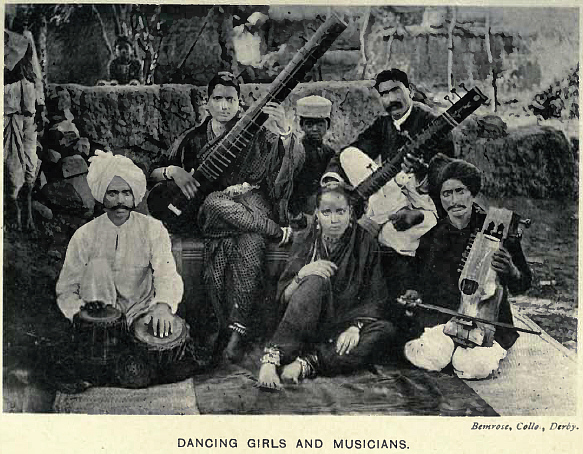
Abb.: Musiker und Tänzerin, Zentralindien, um 1916
[Bildquelle: Russell, R. V. (Robert Vane) <1873-1915> ; Hira Lal, Rai Bahadur <1867-1934>: The tribes and castes of the Central Provinces of India. -- London : Macmillan, 1916. -- 4 Bde. -- Bd. 3. -- Nach S. 374.]
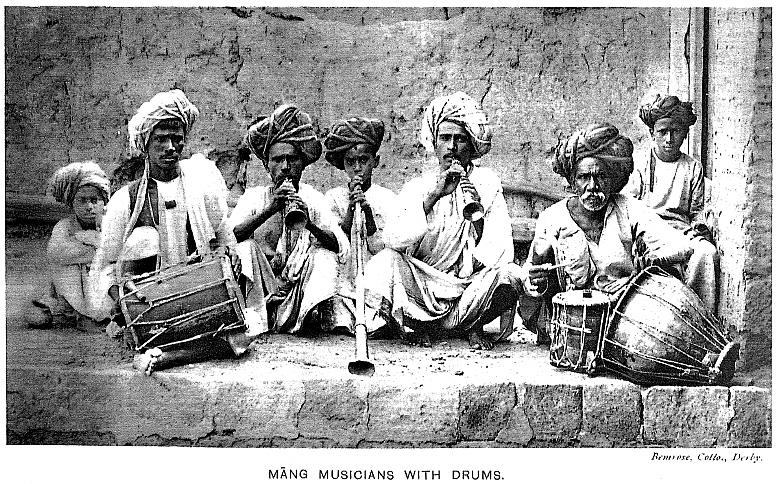
Abb.: Māng-Dorfmusikanten, Zentralindien, um 1916
[Bildquelle: Russell, R. V. (Robert Vane) <1873-1915> ; Hira Lal, Rai Bahadur <1867-1934>: The tribes and castes of the Central Provinces of India. -- London : Macmillan, 1916. -- 4 Bde. -- Bd. 4. -- Nach S. 186.]
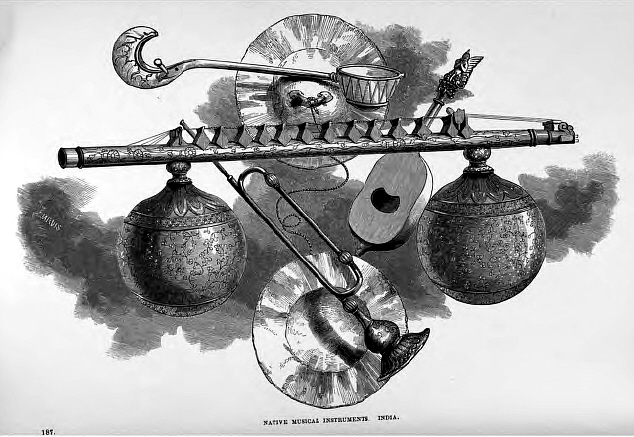
Abb.: Musikinstrumente aus Indien, ausgestellt bei der Great Exhibition of the
Works of Industry of all Nations, London 1851
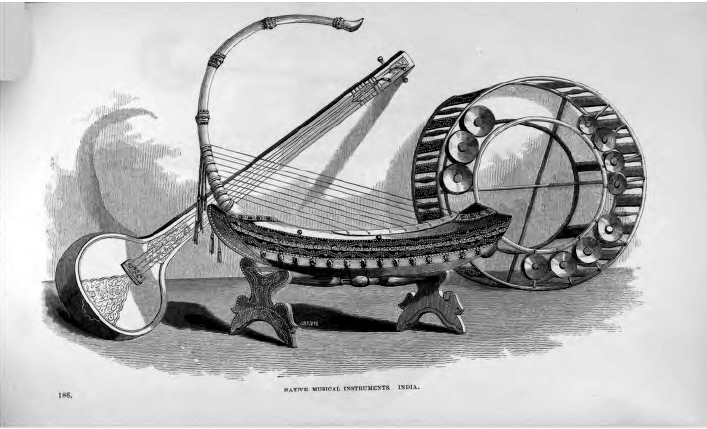
Abb.: Musikinstrumente aus Indien, ausgestellt bei der Great Exhibition of the
Works of Industry of all Nations, London 1851
[Quelle beider Abb.: Official descriptive and illustrated catalogue of the Great exhibition of the works of industry of all nations, 1851 ... -- London : Spicer, 1851. -- Vol IV: Colonies - foreign states. Division I. -- Pl. 186/187]
"MUSICAL INSTRUMENTS. INDIAN musical instruments are remarkable for the beauty and variety of their forms, which the ancient sculptures and paintings at Ajanta shew have remained unchanged for the last two thousand years. The harp, chang, is identical in shape with the Assyrian harp represented on the Nineveh sculptures, and the vina is of equal antiquity. The Hindus claim to have invented the fiddle bow. At Kalka, in the Ambala district of the Panjab, the "Jew's harp," mu-chang ("mouth-harp"), is made at certain seasons of festivity and sold by hundreds. Musical instruments are made in most of the large towns and cities, and those of Srinagar (Cashmere) and Delhi in the Panjab, of Murshedabad in Bengal, and of Tumkur in Mysore, are especially prized. They are also made of marked excellence at Parashram and Malwan, both in the Ratnagiri collectorate of the Bombay Presidency, Delhi, Bareilly, and Channapatna in Mysore are noted for the manufacture of wire for musical instruments. The conch shell used in India as a wind instrument is often beautifully mounted in silver and gold. It is the Turbinella rapa of naturalists, and all that is required to make it sonorous is to drill a hole through its base. When blown into, the wind passing through the different whorls, produces a loud, sharp, and piercing sound, which is heard far and wide, and hence its great esteem as a war trumpet. It is used in religious services to call the attention of the gods to their worshippers ; and also at the conclusion of certain ceremonies. The conch shell used for pouring water on the gods is a smaller one, the Mazza rapa of naturalists. Both these species, and a third, the Voluta gravis, are used in the manufacture of the shell bracelets of Dacca."
[Quelle: Birdwood, George C. M. (George Christopher Molesworth) <1832-1917>: The industrial arts of India. -- London : Chapman and Hall. -- 20 cm. -- (South Kensington Museum art handbooks). -- Vol. 2. -- 1884. -- S. 315. -- Online: http://www.archive.org/details/industrialartsof00birduoft. -- Zugriff am 2008-03-24. -- "Not in copyright".]
Nur einige Beispiele
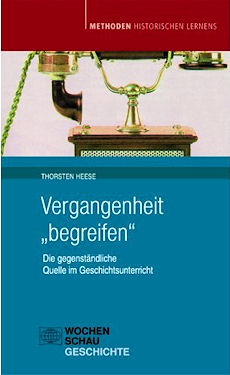
Heese, Thorsten <1965 - >: Vergangenheit "begreifen" : die gegenständliche Quelle im Geschichtsunterricht. --Schwalbach/Ts. : Wochenschau-Verl. , 2007. -- 223 S. : Ill. ; 19 cm. -- (Methoden historischen Lernens). -- ISBN 978-3-89974-331-9
Hervorragende Einführung in das Gebiet:
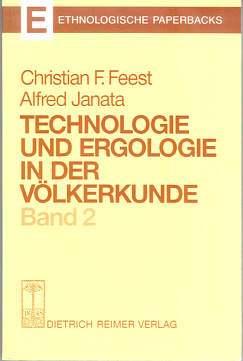
Abb.: Einbandtitel
Technologie und Ergologie in der Völkerkunde / Christian F. Feest ; Alfred Janata. Begr. von Walter Hirschberg. -- Berlin : Reimer. --21 cm. -- (Ethnologische Paperbacks)
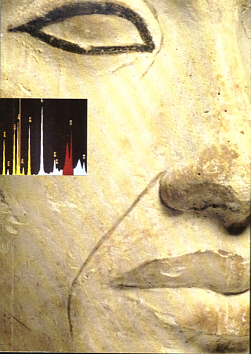
Abb.: Einbandtitel
Riederer, Josef <1939 - >: Archäologie und Chemie : Einblicke in die Vergangenheit ; Ausstellung des Rathgen-Forschungslabors SMPK, September 1987 - Januar 1988 / Staatl. Museen Preuss. Kulturbesitz, Rathgen-Forschungslabor, Berlin. -- Berlin : Rathgen-Forschungslabor SMPK, © 1987. -- 276 S. : Ill. ; 24 cm. -- ISBN 3-88609-212-7
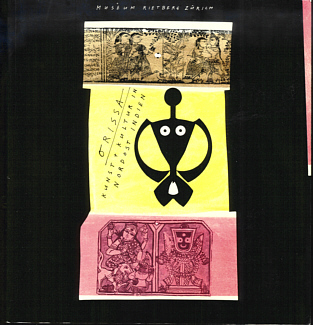
Abb.: Einbandtitel
Orissa : Kunst u. Kultur in Nordost-Indien / Museum Rietberg Zürich. Hrsg. von Eberhard Fischer ... -- Zürich : Museum Rietberg, 1980. -- 360 S. : Ill. ; 22 cm. -- (Publikationsstiftung für das Museum Rietberg <Zürich> ; Bd. 2). -- Regionale Darstellung im Gesamtzusammenhang, kunstlastig.
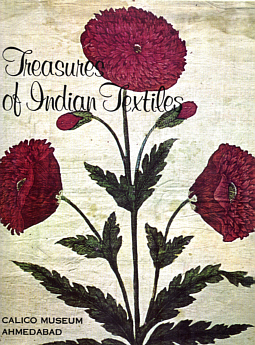
Abb.: Umschlagtitel
Treasures of Indian textiles, Calico Museum, Ahmedabad. -- Marg Publications, [1980]. -- 145 S. : Ill. ; 33 cm.
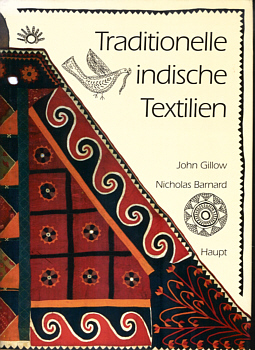
Abb.: Umschlagtitel
Gillow, John ; Barnard, Nicholas: Traditionelle indische Textilien : ein Führer durch die faszinierende Vielfalt indischer Textilkunst:Geschichte, Materialien, Verfahren. -- Bern ; Stuttgart : Haupt, 1991. -- 160 S. : Ill. ; 31 cm. -- Originaltitel: Traditional Indian textiles (1991). -- ISBN 3-258-04364-7
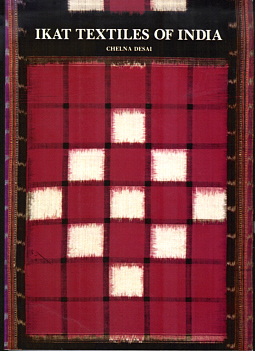
Abb.: Einbandtitel
Desai, Chelna: Ikat textiles of India. -- San Francisco : Chronicle Books, 1988. -- 155 S. : Ill. ; 30 cm. -- ISBN 0877015481
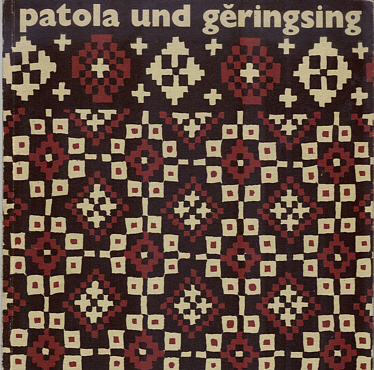
Abb.: Einbandtitel
Bühler, Alfred <1900-1981> ; Ramseyer, Urs ; Ramseyer-Gygi, Nicole: Patola und gěringsing : Zeremonialtücher aus Indien und Indonesien. Sonderausstellung, Museum für Völkerkunde und Schweizerisches Museum für Volkskunde, Basel, 1975/76. -- Basel, 1975. -- 96 S. : Ill. ; 21 cm.
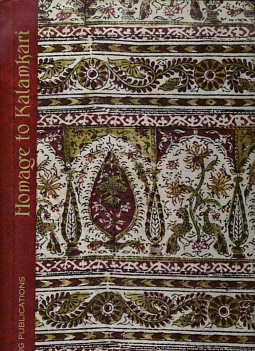
Abb.: Einbandtitel
Homage to Kalamkari. -- Bombay : Marg Publications, [1980?]. -- 134 S. : Ill. ; 33 cm.
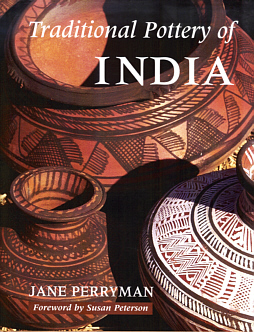
Abb.: Umschlagtitel
Perryman, Jane: Traditional pottery of India. -- London : Black, 2000. -- 192 S. : Ill. ; 30 cm. -- ISBN 0713645210
Beispiel eines ethnoarchäologischen Zugangs:
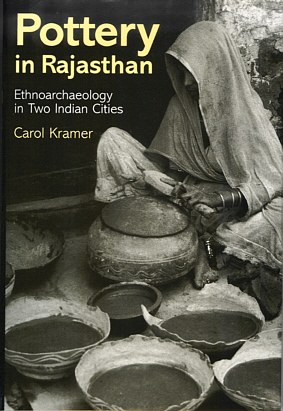
Abb.: Umschlagtitel
Kramer, Carol: Pottery in Rajasthan : ethnoarchaeology in two Indian cities. -- Washington : Smithsonian Institution Press, 1997. -- XVIII, 264 S. : Ill. ; 24 cm.. -- (Smithsonian series in archaeological inquiry). -- ISBN 1-560-98740-5
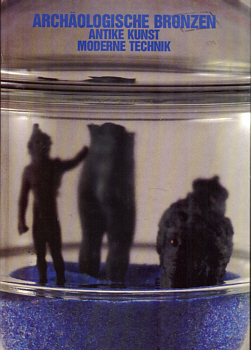
Abb.: Einbandtitel
Archäologische Bronzen, antike Kunst, moderne Technik / [dieser Katalog entstand im Rahmen d. Berliner Ausstellung "Archäolog. Bronzen in d. Restaurierung - Antike Kunst - Moderne Technik" im Museum für Vor- u. Frühgeschichte, Staatl. Museen Preuss. Kulturbesitz, Berlin]. Hrsg. von Hermann Born. Mit Beitr. von Hermann Born ... -- Berlin : Reimer, 1985. -- 206 S. : Ill. ; 30 cm. -- ISBN 3-496-01029-0. -- Sehr gute Darstellung moderner Forschungsmethoden.
Bewegliche Hinterlassenschaften werden vor allem in Museen aufbewahrt. Wichtige Museen sind:
Für alle Gebiete:
Für Textilien
Selbstdarstellung:
"Das Rathgen-Forschungslabor ist ein naturwissenschaftliches Institut, das sich mit der Materialanalyse und der Erhaltung kulturgeschichtlicher Objekte befasst. Ziele solcher Untersuchungen sind die Bestimmung des Materials, des Alters, der Herkunft und der Echtheit sowie die Beratung bei Fragen der Restaurierung und Konservierung von Kunstwerken. Es wurde 1888 als Chemisches Labor der Königlichen Museen zu Berlin gegründet.
Das Rathgen-Forschungslabor ist die Leitinstitution für konservierungswissenschaftliche, kunsttechnologische und archäometrische Belange innerhalb der Staatlichen Museen zu Berlin. Es ist bundesweit eine von wenigen Forschungseinrichtungen, die materialübergreifend entsprechende Untersuchungen an Museumsobjekten durchführt sowie naturwissenschaftliche Fragestellungen aus der Denkmalpflege und der Erhaltung archäologischer Stätten bearbeitet. Das Rathgen-Forschungslabor steht in der Tradition des ältesten Museumslabors der Welt, der am 1. April 1888 als Chemisches Labor der Königlichen Museen zu Berlin gegründeten Forschungs- und Entwicklungseinrichtung. Es wurde nach dessen erstem Direktor Friedrich Rathgen benannt.
Seine Expertise in allen die Konservierung und Erhaltung von mobilem und immobilem Kunst- und Kulturgut betreffenden Fragen stellt das Rathgen-Forschungslabor auch in internationalen Fachgremien wie dem International Council on Monuments and Sites (ICOMOS), dem International Council of Museums - Committee for Conservation (ICOM-CC) oder dem International Centre for the Study and Preservation of Cultural Property (ICCROM) zur Verfügung.
In seiner Funktion als konservierungswissenschaftlicher Ansprechpartner innerhalb der Staatlichen Museen zu Berlin ist das Rathgen-Forschungslabor insbesondere der Einwerbung und Durchführung langfristiger Forschungsprojekte sowie theoretisch und methodisch fundierter Dienstleistung verpflichtet.
Dafür ist das Labor mit modernen analytische Geräten und Verfahren ausgestattet wie u.a. optische sowie Rasterelektronenmikroskopie (ESEM/EDS), mobile und traditionelle Röntgenfluoreszenzanalytik (µ-XRF und XRF), Röntendiffraktometrie (XRD), Infrarot- (FT-IR) und UV-Vis-Spektroskopie, Pyrolyse-Gaschromatographie-Massenspektrometrie (GC-MS), Hochleistungsflüssigkeitschromatographie (HPLC), Atomabsorptionsspektroskopie (AAS), Massenspektrometrie mit induktiv gekoppeltem Plasma (ICP/MS), optisch stimulierte (OSL) und Thermolumineszenz (TL), zerstörungsfreie Ultraschalldiagnostik, sowie weitere Verfahren zur Bestimmung physiko-mechanischer Kennwerte von Materialien, Bewitterungskammern zur Simulation bestimmter Klimabedingungen und mobilen Messsystemen zum Monitoring der physikalischen und chemischen Umgebungsbedingungen in den Sammlungen."[Quelle: http://www.smb.spk-berlin.de/smb/sammlungen/institut.php?lang=de&objID=14973&p=0. -- Zugriff am 2008-03-23]
Zu: 6.1. The textile manufactures and the costumes of the people of India <Auszüge> / by John Forbes Watson (1866)
Zu: 7. Bildträger